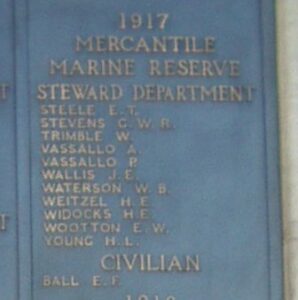Pembroke Dock is the third largest town in Pembrokeshire, and is situated on the River Cleddau. The town began life as a rural estate in the Middle Ages, but was really established with the building of the Royal Dockyard in 1814. The importance, and location, of Pembroke Dock as a Dockyard grew throughout the remainder of the 19th Century, but by the beginning of the 20th Century the town was in decline. War brought about a short-lived resurgence in the town, both during WW1, when the Dockyards were widely used, and during WW2 when Pembroke Dock played host to various Squadrons of the Royal Air Force, being home to the famous Sunderland flying boat. The War Memorial for the town was unveiled on 30 July 1921, and stands outside St. John’s Church. There are no names on the memorial itself, but on several carved oak panels inside St John’s Church. There is also a small memorial within St. Teilo’s Church, one inside St. Andrew’s Church and another inside Bethany Chapel. The men below are a conglomeration of these names, and also men from Pembroke Dock who haven’t yet been found to be commemorated locally have been added and noted.
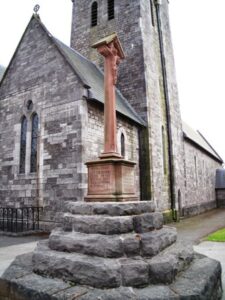
The Great War, 1914-1918
Thomas George Adams, Private, 27565, South Wales Borderers. Thomas was the son of Henry and Mary Adams, of Pembroke Dock, and the husband of Sarah Adams, of 79, High Street, Tumble. He enlisted at Haverfordwest into the Army, joining the 11th Battalion, South Wales Borderers, which was attached to 115 Brigade, 38th (Welsh) Division. After training at Rhyl and Winchester, the division landed in France in December 1915, taking the line at Fleurbaix. In June 1916 it moved to the Somme, where it captured Mametz Wood, before moving to positions at Boesinghe, north of Ypres. Thomas was wounded at Ypres the following year. He was evacuated to a Casualty Clearing Station for treatment, but died of his wounds on 4 June 1917. Thomas was 26 years old, and is buried at Mendinghem Military Cemetery, Belgium. Thomas is commemorated at Tumble, but not at Pembroke Dock.
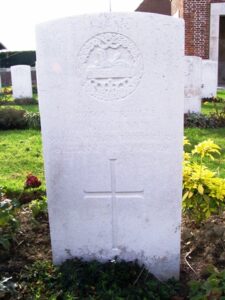
William Victor Adams, Corporal, 79810, Royal Field Artillery. William was born at Prendergast, Haverfordwest. He was a shunter with the GWR prior to the war, and had enlisted at Haverfordwest into the Royal Field Artillery on 14 August 1914. On 18 January 1915 William married Gertrude Nellie Wilson, at St. Thomas Church, Haverfordwest, and she set up home at 70, Bush Street, Pembroke Dock, where their daughter, Phyllis Winifred, was born. (She was later Gertrude Ball, of 18, Margaret Street, Ammanford). William was posted to ‘B’ Battery, 88th Brigade, RFA, attached to the 19th (Western) Division. The Division crossed to France during July 1915, moving to positions near Loos. The Division fought during the opening attack of the Battle of Loos, and then moved to the Somme, where they took part in the second wave of the attack on Ovillers-La Boiselle on 1 July 1916, capturing the village at heavy cost, and fought through the Somme Battles, and it was during the Battle of Pozieres that William was killed in action, on 28 July 1916. He was 23 years old, and is buried at Caterpillar Valley Cemetery, Longueval. William is commemorated at St. John’s Church.
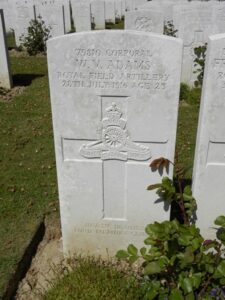
William Alexander, Company Sergeant Major, 6341, Duke of Edinburgh’s Wiltshire Regiment. William was born at Devizes, Wiltshire in 1884, the son of Eli and Charlotte Alexander. He was a regular soldier, and resided at Pembroke Dock prior to the war, marrying Elizabeth Mary Brown there in 1907. Upon the outbreak of war, William was posted to the 6th Battalion, Wiltshire Regiment, which was attached to 58 Brigade, 19th (Western) Division. The Division moved to France during July 1915, and moved to positions near Loos, where it took part in the opening attack of the Battle of Loos on 25 September 1915. The following year the Division moved to the Somme, where it took part in the second wave of the attack on Ovillers-La Boiselle on 1 July, capturing the village at heavy cost. It then fought through the Somme Battles of Poziéres and the Ancre in 1916. William was killed on the Somme on 2 November 1916, aged 31. He is commemorated on the Thiepval Memorial, France. William is not commemorated at Pembroke Dock.
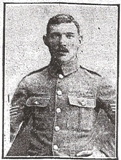
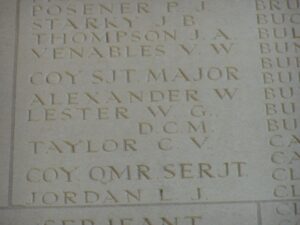
Thomas Allan, Sapper, 20214, Royal Engineers. Thomas was the son of Thomas and Margaret Louisa Allan, of Sunderland. He was a regular soldier, having enlisted at Sunderland into the Royal Engineers on 15 June 1910. Thomas was based at Pembroke Dock prior to the war, and married Alice Myra Davies, of 30, Clarence Street, Pembroke Dock, in 1913. He was mobilised for war at Chatham on 4 August 1914, serving in France from 5 November 1914, and on 3 February 1917 was posted to 353rd Entrenching Company, Royal Engineers. Thomas was killed in action during the German Spring Offensive, on 2 April 1918. He was 30 years old, and is buried at Namps-Au-Val British Cemetery, France. Thomas is commemorated at St. John’s Church.
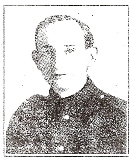
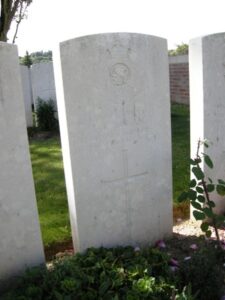
William Lynn Allen, DSO, Major, Border Regiment. William was born on 8 May 1871 at West Lynn, Altringham, Cheshire, the son of Bulkeley Allen, JP, of West Lynn, Altrincham, and Mary Emma Lynn. He was educated at Rugby before being gazetted to the 3rd Battalion, King’s Own Yorkshire Light Infantry in 1891, and to the Border Regiment 9 September 1893. He served during the Boer War, where he was mentioned in Despatches twice, and awarded the Distinguished Service Order, ‘In recognition of services during the operations in South Africa’. William had married Adeline Miriam prior to the Boer War, and the couple had three children. The battalion was stationed at Pembroke Dock before the outbreak of war, and left Pembroke Dock for the Western Front, sailing on 5 October 1914. The battalion was attached to the 7th Division, and moved to positions east of Ypres. After weeks of desperate fighting, William was killed during a German attack on his battalions’ position on 28 October 1914. He was 43 years old, and is commemorated on Panel 35 of the Ypres (Menin Gate) Memorial, Belgium. William is commemorated at St. John’s Church.
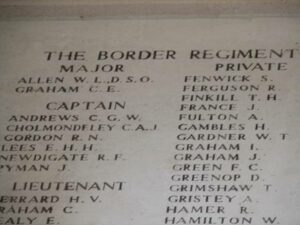
Charles George Williams Andrews, Captain, Border Regiment. Charles was born on 16 May 1878, the only son of G. J. W. Andrews, of Dorchester, and the husband of Diana Norrington. He was commissioned in 1897, and served during the Boer War with the 2nd Battalion, Border Regiment. The battalion was stationed at Pembroke Dock before the outbreak of war, and left Pembroke Dock for the Western Front, sailing on 5 October 1914. The battalion was attached to the 7th Division, and moved to positions east of Ypres. After several weeks of desperate defensive actions, Charles was killed in action during the same action as William Lynn Allen, on 28 October 1914. He is commemorated on Panel 35 of the Ypres (Menin Gate) Memorial, Belgium. Charles is commemorated at St. John’s Church.
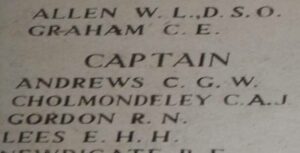
William Thomas Arthur, Private, 54130, Welsh Regiment. William was born in 1896, the son of George and Martha Arthur, of White Hill, Carew. He lived at Pembroke Dock prior to the war, and enlisted at Carmarthen into the 15th Battalion of the Welsh Regiment, which was the Carmarthenshire Battalion. In 1915 the Battalion became part of 114 Brigade, 38th (Welsh) Division, and moved to the Western Front in December 1915, taking up positions near Fleurbaix. They fought with distinction at Mametz Wood the following year, and in 1917 played a major part in the capture of the Pilckem Ridge during Third Ypres. They were rushed to the Somme in spring 1918 to help stem the German push towards Amiens, and then took part in the great offensive of August, 1918, where they forded the flooded River Ancre on the night of 22 August 1918 which began the great drive to victory. The Division pushed steadily through Pozières and Longueval, capturing the village of Morval, which is where William was killed on 1 September 1918. He was 22 years old, and is buried at Morval British Cemetery, France, in grave Ref. A. 6. William is not commemorated at Pembroke Dock.
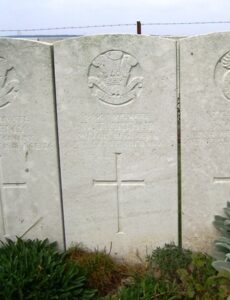
Bertie Thomas Ashmore, Private, 899, Welsh Regiment. Bertie was the son of Charles and Caroline Ashmore, of 32, Lewis Street, Pembroke Dock. He enlisted at Carmarthen at the outbreak of war into the 1/4th Battalion, the Welsh Regiment. The battalion was the local Territorial infantry unit, and formed for war at Carmarthen from 4 August 1914, attached to South Wales Brigade, Army Troops. During November 1914 it moved to Tunbridge Wells, and in February 1915 moved to Scotland on the Forth and Tay Defences. On 17 April 1915 the battalion joined 159 Brigade, 53rd (Welsh) Division, at Bedford, and on 19 July 1915 sailed from Devonport for Mudros, arriving on 5 August, before being transferred to Suvla Bay, Gallipoli on 9 August 1915. Immediately the 1/4th Welsh became embroiled in heavy fighting, against strongly defended Turkish trenches. Bertie was killed on the following day, 10 August 1915, during a charge against a Turkish post. He was 23 years old, and like so many of the men killed at Gallipoli, is commemorated on the Helles Memorial, Gallipoli, on Panel 140 to 144. Bertie is commemorated at St. John’s Church.
Tom Ashton, Private, PLY/11443, Royal Marine Light Infantry. Tom was born on 23 January 1884, the son of Susannah Ashton, of Oldham, Lancashire. He enlisted into the Plymouth Division, Royal Marines on 20 February 1902. At the outbreak of war, he was posted aboard the Canopus Class Battleship HMS Goliath, which was stationed at Pembroke Dock. Goliath then moved to Devonport, and then covered the landing of the Plymouth Marine Battalion at Ostend, Belgium on 25 August 1914. On 25 March 1915, Goliath was ordered to the Dardanelles, where she provided artillery support for the landings of 25 April 1915. On 13 May 1915, Goliath was attacked by the Turkish torpedo boat Muavenet, and was sunk by two torpedoes. Tom was one of 570 men who died during the sinking. He is commemorated on Panel 7 of the Plymouth Naval Memorial, Devon. Tom is commemorated at St. John’s Church.
Edgar James Ball, Driver, 14484, Royal Field Artillery. Edgar was the son of Hugh and Minnie Ball, of 8, King Street, Pembroke Dock. He enlisted at Pembroke into the Royal Field Artillery, and was posted to the 28th Brigade Ammunition Column, which was an Army Brigade, attached to 2nd Army. Edgar fought at the Battle of Passchendaele throughout the summer of 1917, and this is where he became wounded, after the main Battle had been called to a halt. Edgar was taken to a Casualty Clearing Station just north of Poperinghe, where he died of his wounds on 5 December 1917. Edgar was 27 years old, and was buried at Dozinghem Military Cemetery, Belgium, in grave Ref. XIV. F. 11. Edgar is commemorated at St. John’s Church.
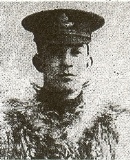
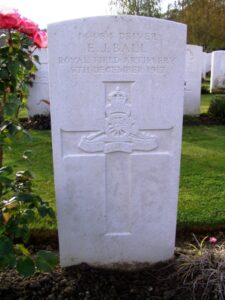
Frederick Ball, Private, 31283, King’s Shropshire Light Infantry. Frederick was the son of Henry Isaac and Mary Ann Ball, of 14, Listley Street, Bridgenorth, Salop. He resided at Pembroke Dock prior to the war, and enlisted there into the army. After serving with the Royal Defence Corps on home service, Frederick was posted to France, where he joined the 1st Battalion, King’s Shropshire Light Infantry, which was attached to 16 Brigade, 6th Division. Frederick would have fought on the Somme with the battalion in 1916, then at Arras the following year. He was probably captured by the Germans during the spring offensives of 1918, and died in captivity on 7 October 1918, aged 36. Frederick is buried at Cologne Southern Cemetery, Germany, in Grave Ref. XI. B. 7. Frederick is not commemorated at Pembroke Dock.
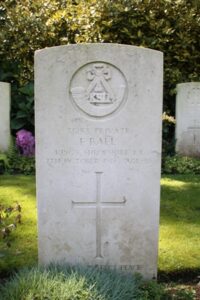
Reginald Percy Bartlett, Boy 1st Class, J/23934, Royal Navy. Reginald was born in Pembroke Dock on 3 March 1897, the son of Charles and Mary Bartlett. He enlisted into the Royal Navy on 3 March 1915, and trained at HMS Impregnable, HMS Edgar and HMS Vivid I before being posted to HMS Viknor. Viknor was an obsolete merchant ship which had been requisitioned by the Admiralty and converted into an armed merchant cruiser. During the first weeks of 1915 she was on patrol off the north-west coast of Ireland and lost contact with shore in heavy weather on 13 January 1915. The area was thought to have been heavily mined by the Germans. There were no survivors from Viknor, although many bodies and some wreckage were washed up on the Irish and Scottish coasts in the coming weeks. Reginald was just 17 years old when he was lost in the sinking and is commemorated on the Plymouth Naval Memorial, Devon. He does not appear to be commemorated locally.
Charles Bateman, Private, 40077, Welsh Regiment. Charles was the son of Joseph Charles and Jane Bateman, of Pembroke Dock. He resided at Nantymoel prior to the war, and enlisted at Bridgend into the Welsh Regiment. Charles was posted to France in 1916, joining the 13th Battalion, Welsh Regiment (2nd Rhondda), which was attached to 114 Brigade, 38th (Welsh) Division. On 2 December 1915 the battalion moved to France, and the entire Division moved to the Fleurbaix sector, where it was initiated into trench warfare. During June 1916 the Division marched south to the Somme, and on 7 July 1916 attacked Mametz Wood. The initial attack failed, and it was three days later, on 10 July, that a fresh attack was mounted. After two days of heavy hand to hand fighting within the wood, the Germans withdrew. Charles was killed in Mametz Wood on 10 July 1916, aged 29. He has no known grave, and is commemorated on the Thiepval Memorial, France. Charles is not commemorated at Pembroke Dock.
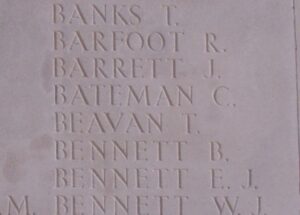
Edward John Beavil, Petty Officer 1st Class, 174872, Royal Navy. Edward was born on 22 September 1877, the son of Elizabeth Ann Beavil, of Plymouth. He resided with his wife, Muriel Mabel Beavil, at 45, Bush Street, Pembroke Dock prior to the war. Edward served aboard HMS Goliath, which was classed as a 1st class battleship, of the ‘Canopus Class’. It had been laid down at Chatham Dockyard on 4 January 1897, and was designed for the China station, having a narrow draught, to enable her to use the Suez Canal. She remained there until 1903, and in 1904 went into commissioned reserve at Portsmouth. In May 1905 she joined the Mediterranean fleet, transferring to the channel fleet in December and remaining there until March 1907. She was then commissioned in April 1909 at Sheerness for the 4th Fleet (Nore Reserve). HMS Goliath was mothballed in 1913, and joined the 3rd Fleet (Pembroke Reserve), to be brought out in August 1914 to join the battle squadron operating from Devonport. Her complement was drawn up from the naval reserve on 2 August 1914, and she was despatched in September 1914 to the East Indies for escort duties, operating against the German light cruiser Konigsberg in November. In April 1915 she was transferred to the Dardanelles, to support the ill-fated landings around Cape Helles. She was damaged on 25 April and again on 2 May, and then finally sunk by three torpedoes fired by the Turkish torpedo boat ‘Muavanet’ on 13 May 1915, with the loss of 570 of her crew, including Edward, who was 37 years old. Edward is commemorated on the Plymouth Naval Memorial, Devon. Edward is commemorated at St. John’s Church.
William John Beddoe, Private, 16882, Essex Regiment. William was the son of John and Sarah Beddoe, of Pembroke Dock. He enlisted at Pembroke into the Army, and was posted to the 9th Battalion, Essex Regiment. The Battalion formed part of 35 Brigade, 12th (Eastern) Division. The Division landed at Boulogne on 31 May 1915, and took over the line at Ploegsteert Wood. They then moved south and fought in the Battle of Loos, and the subsequent actions of the Hohenzollern Redoubt, and remained there until March 1916. William was killed in action near Loos, just before the Division moved to the Somme, on 30 March 1916. He was 30 years old, and is buried at Vermelles British Cemetery, France, in grave Ref. II. E. 17. William is commemorated at St. John’s Church.
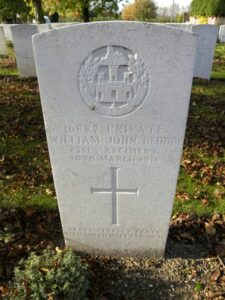
William George Bevan, Leading Seaman, 205220, Royal Navy. William was born at Pembroke Dock on 20 March 1883, and was the husband of Violet Bevan, of 8, King William Street, Pembroke Dock. He worked for the Trinity Service prior to the war, before joining the Royal Navy. Towards the end of the war he was serving aboard H.M.P.M.S. Ascot, a Racecourse Class Paddle Steamer Minesweeper. Unluckily for William, Ascot was to be the last Royal Naval vessel to be sunk during the war, when it went down after being torpedoed by a German U-Boat on 10 November 1918. William was 35 years old, and is commemorated along with his ship-mates on the Plymouth Naval Memorial, Devon, on Panel 20. William is commemorated at St. John’s Church.
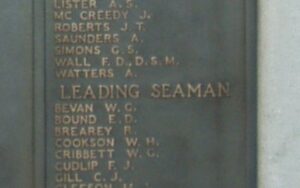
Henry Arthur Beynon, Private, M/333337, Royal Army Service Corps. Henry was born at Saundersfoot in 1885. He was a butcher prior to the war, and lived with his wife Mary Ann Beynon, at 12, King Street, Pembroke Dock. He enlisted on 26 June 1916 into the army, and was posted to the 970th Motor Transport Company, Royal Army Service Corps. Henry saw active service at home and in Mesopotamia during the war. Henry survived the war, but had developed neurasthenia, which took a heavy toll on his health, and died on 1 March 1920, aged 35. Henry is buried at Pembroke Dock (Llanion) Cemetery, in Grave Ref. U. 147. Henry is not commemorated at Pembroke Dock.
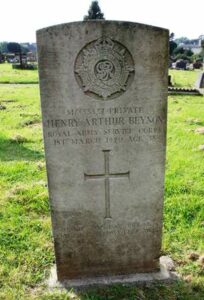
Thomas John Birmingham, Sergeant, 9111, Seaforth Highlanders. Thomas was born in 1882, the son of Edward and Johanna Birmingham, of 10, South Park Street, Pembroke Dock. He was a long serving regular soldier, and at the outbreak of war was posted to the 7th Battalion, Seaforth Highlanders. The battalion was attached to 26 Brigade, 9th (Scottish) Division, and landed in France on 10 May 1915, seeing its first major action during the Battle of Loos, which was launched on 25 September 1915. The formidable task facing the Brigade was the capture of the renowned Hohenzollern Redoubt. The Seaforths were the first battalion in action, but were mown down by German machine-gun fire, but gained the Redoubt, where consolidation work began, still under intense fire and bombardment. Thomas was wounded during the battle, and was evacuated back to a Military Hospital near Rhymney, where he died of his wounds on 4 October 1915, aged 33. Thomas is buried at Rhymney Cemetery, in Grave Ref. A. 356. (The family name is found in records both as Birmingham and Bermingham, but the former seems the most prevalent, and is the name he served under). Thomas is commemorated at St. John’s Church.
William Bowen, Chief Stoker, 291526, Royal Navy. William was born on 7 October 1878, the son of the late W. and S. Bowen. He resided with his wife Alice Bowen, at 31, Military Road, Pennar prior to the war. William served aboard HMS Pheasant, which was a destroyer, stationed in the Orkneys. William died when Pheasant was lost with all hands after striking a mine off the Orkneys on 1 March 1917. He was 38 years old, and is commemorated on the Plymouth Naval Memorial, Devon, on Panel 22. William is not commemorated at Pembroke Dock.
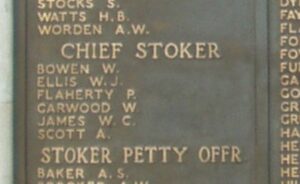
Edward Bowmaker, Sergeant, 9377, Border Regiment. Edward was born at Newcastle in 1888, and was a regular soldier, and had enlisted into the 4th Battalion, Durham Light Infantry at Gateshead on 8 February 1907. He transferred to the regular army on 9 January 1908, joining the Border Regiment. He married Sarah Jane Scurlock, of 98, Laws Street, Pembroke Dock early in 1914. Edward was sent to France with the 2nd Battalion, Border Regiment, which was attached to 20 Brigade, 7th Division. The Division was formed during September, 1914 and landed at Zeebrugge on 6 October 1914. The City was already falling however, and so the Division was moved to Ypres, where they became the first British Division to hold the city. They fought during the First Battle of Ypres, and helped stop the German advance through Belgium. Edward was killed at Ypres on 26 October 1914, aged 26. He is buried at Zantvoorde British Cemetery, Belgium, in Grave Ref. V. E. 7. Edward is commemorated at St. John’s Church.
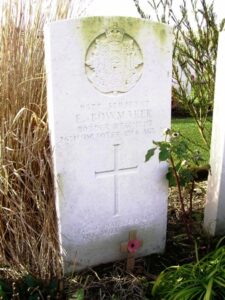
Charles Norton Breckenridge, Private, 24472, Welsh Regiment. Charles was the son of Robert John and Sarah Breckenridge, of Pembroke Dock. He resided with his wife Florence Lydia Breckenridge, at 38, Pyke Street, Barry, prior to the war. Charles enlisted at Barry into the 16th Battalion, Welsh Regiment, which was raised in Cardiff, before moving to Rhyl for training in September 1914. In 1915 the battalion moved to Winchester, becoming part of 114 Brigade, 38th (Welsh) Division, and landed with the division in France during December 1915. After several months training at the Nursery Sector at Fleurbaix, the Welshmen marched to the Somme Valley in June 1916. There, they were tasked with the capture of Mametz Wood. The initial attack on the wood was launched on 7 July 1916 by the 16th Welsh, and it was on this day that Charles was killed. He was 35 years old, and is commemorated on the Thiepval Memorial, France, on Pier & Face 7A & 10A. Charles is not commemorated at Pembroke Dock.
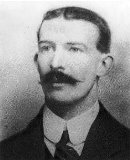
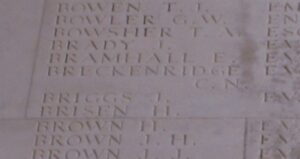
Stephen Joseph Breen, Private, 10730, Border Regiment. Stephen was born at Cork, and enlisted at Pembroke Dock into the 2nd Battalion, Border Regiment. The battalion was attached to 20 Brigade, 7th Division, and landed at Zeebrugge in October 1914, before moving to Ypres. They fought during the First Battle of Ypres, and helped stop the German advance through Belgium, and in March, 1915 fought at the Battle of Neuve Chappelle. During May they fought at the Battle of Aubers Ridge, and at Festubert, before taking part in the Battle of Loos in September. In the summer of 1916, the Division were on the Somme, and took part in the Battle of Albert, where they captured Mametz, one of the few successes of 1 July 1916. They then fought at the Battle of Bazentin, and the Attacks on High Wood, playing a successful part in the ‘dawn attack’, and were also the first troops into High Wood. Stephen was killed here on 4 September 1916. He has no known grave, and is commemorated on the Thiepval Memorial, France, on Pier and Face 6A and 7C. Stephen is not commemorated at Pembroke Dock.
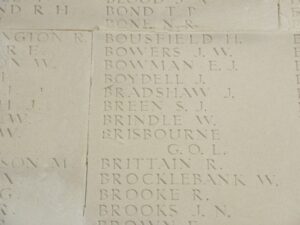
Frederick Brooks, Gunner, 14483, Royal Field Artillery. Frederick was the son of Joseph and Sarah Brooks of Pembroke. He enlisted at Pembroke into the Royal Field Artillery, and was posted to ‘B’ Battery, 92nd Brigade, which was attached to the 20th (Light) Division. On 26 July 1915 the Division completed concentration in the Saint-Omer area, all units having crossed to France during the preceding few days. Early trench familiarisation and training took place in the Fleurbaix area. When the Battle of Loos was launched on 25 September 1915 the Division fought a diversionary attack towards Fromelles. Later that year they moved north, and fought at the Battle of Mount Sorrel alongside the Canadian Corps. Over the winter of 1915/16, the Division remained in positions south of Ypres, and fought at the Battle of Mount Sorrel in June, alongside the Canadian Corps. They then fought through the Somme Offensive, at the Battles of Delville Wood, Guillemont, Flers-Courcelette, Morval and Le Transloy. Frederick was killed in action during the fighting at Le Transloy, on 3 November 1916. He was just 22 years old, and is buried at Carnoy Military Cemetery, France. Frederick is commemorated at St. John’s Church, and at St. Teilo’s Church.
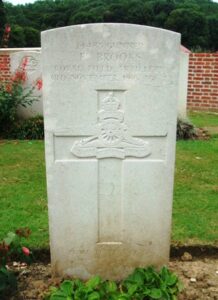
William George Brown, Private, 5651, Lancashire Fusiliers. William was born at Pembroke Dock, the son of Colour Serjeant Instructor Harry Brown, late of the 2nd Norfolk Regiment. Prior to the war he resided with his wife Catherine Brown, at 77, Bridgefield Street, Radcliffe, Manchester. He enlisted at Bury into the 1st Battalion, Lancashire Fusiliers, which was attached to 86 Brigade, 29th Division. The Division moved to Gallipoli via Egypt, landing on 25 April, 1915, and remained here until the evacuation, forging a reputation as one of the best divisions in the British Army. William was killed at Gallipoli on 21 June 1915, aged 40, and is buried at Pink Farm Cemetery, Helles. The exact location of his grave is unknown, and he is commemorated on Special Memorial 10. William is not commemorated at Pembroke Dock.
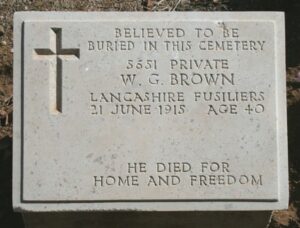
Alfred Henry Bull, Private, 4183, Border Regiment. Alfred was born at Tottenham, and was the husband of Celia Bull. He had enlisted at London into the 2nd Battalion, Border Regiment, and was stationed with the battalion at Pembroke Dock prior to the outbreak of the Great War. Alfred embarked for the Western Front with his battalion on 5 October 1914, where it became part of the 7th Division, taking up positions east of Ypres. Alfred was killed during a German attack on 24 October 1914. He was 39 years old, and is commemorated on Panel 35 of the Ypres (Menin Gate) Memorial, Belgium. Alfred is commemorated at St. John’s Church.
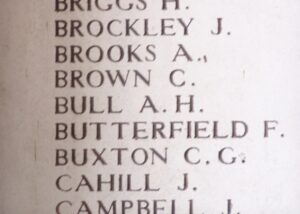
Frederick James Bunt, Driver, 47949, Royal Garrison Artillery. Frederick was born at the Defensible Barracks, Pembroke Dock in 1892, the son of Sidney and Annie Elizabeth Bunt (nee Gravett). His father was originally from Gosport, Hampshire, and served with the Royal Artillery at Pembroke Dock, where he had married Annie in 1883. Fred followed in his fathers footsteps, and enlisted on 29 August 1907 into the Royal Artillery at Pembroke Dock. On 4 November 1911 he married Annie Maria Cotton, at Newport, Isle of Wight. By the outbreak of the Great War, Fred was stationed at Gosport, where he was attached to No. 33 Company, Royal Garrison Artillery. He served at the Gibraltar Garrison from 27 December 1914, until 15 September 1915, before returning to Gosport, where he was discharged from the Royal Artillery on 15 October 1915 for misconduct. He possibly died of wounds in France on 7 July 1918, but is not commemorated by the Commonwealth War Graves Commission, so nothing further has yet been traced. Frederick is commemorated at St. John’s Church, and at St. Teilo’s.
Hugh Albert Bunt, Private, 1005, Canadian Infantry. Hugh was born at Pembroke Dock on 23 February 1878, the seventh child of Sidney and Sarah Bunt (nee Kelsey). Sarah died in 1880, and Sidney married Annie Elizabeth Gravett in 1883, and the couple had three more children. Hugh emigrated to Canada prior to the war, and enlisted at Valcartier into the 8th Battalion, Canadian Expeditionary Force. The battalion was known as the Little Black Devils, and was part of the 2nd Brigade, 1st Canadian Division, which arrived in Britain on 14 October 1914, before moving to France. The division saw heavy fighting at Ypres throughout 1915, and was involved in the first German gas attack at Gravenstafel on 24 April 1915, where it held a large gap in the line after the French Colonial troops had fled. In the summer of 1916 the Canadians moved to the Somme, and Hugh was wounded there during the attack on Flers. He died of wounds at a Casualty Clearing Station on 8 September 1916. He was 36 years old, and is buried at Puchevillers British Cemetery, France, in Grave Ref. IV. B. 23. The County War Memorial incorrectly lists Hugh as serving with the Australian Forces. Hugh is commemorated at St. John’s Church.
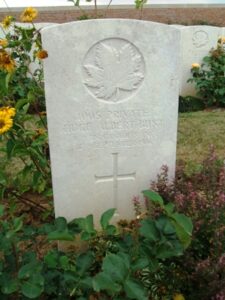
Horace William Burrell, Private, 19312, South Wales Borderers. Horace was the son of Robert and Elenor Burrell, of 46, Rensburg Road, Coppermill Lane, Walthamstow, London. He was residing at Pembroke Dock when he enlisted into the army, and was posted to the 7th Battalion, South Wales Borderers, which was attached to 67 Brigade, 22nd Division. The division was in Salonika, and in September 1918 took part in the Battle of Doiran. Horace was killed in action here on 18 September 1918, aged 20. He is buried in Doiran Military Cemetery, Salonika. Horace is not commemorated locally.
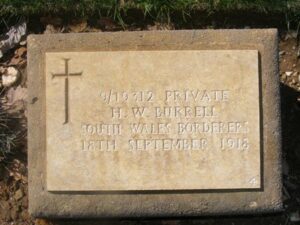
Ernest Alfred Butland, Private, 49618, Bedfordshire Regiment. Ernest was the son of Ernest Adam and Charlotte Butland, of 18, Jacobs Wells Road, Clifton, Bristol. He resided at Pembroke Dock prior to the war, and enlisted at Chiswick into the Army Service Corps, before being posted to the 2nd Battalion, Bedfordshire Regiment. The battalion was attached to 54 Brigade, 18th (Eastern) Division, which saw its first major action in July 1916, when it took part in the Battle of the Somme. In March, 1917 they followed the German Retreat to the Hindenburg Line, and in May took part in the Third Battle of the Scarpe, which was part of the Arras Offensive. July 1917 saw the Division at Ypres, where they took part in the Battle of Pilckem, where they helped capture Westhoek, and then they fought at the Battle of Langemarck, and at the First Battle of Passchendaele, followed by the Second Battle of Passchendaele. In 1918 the Division were stationed south of the Somme, and were one of the Divisions hit there by the German Spring Offensive, which was launched on 21 March 1918. They fought at the Battle of St Quentin, and suffered terrible casualties, and then took part in the Battle of the Avre and the Actions of Villers-Bretonneux. Ernest was killed during the desperate attempt to prevent the German breakthrough to Amiens, on 2 July 1918. He was 19 years old, and is buried at Warloy-Baillon Communal Cemetery Extension, France, in Grave Ref. IV. H. 1. Ernest is not commemorated at Pembroke Dock.
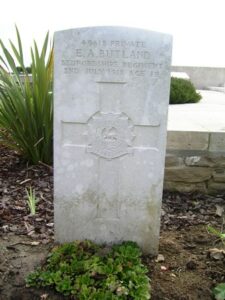
Lewis Canton, Company Sergeant Major, 11825, Royal Warwickshire Regiment. Lewis was born in 1875, the son of William and Mary Canton, of Stakpole. He had enlisted into the Militia in August 1894, joining the 1st Battalion, Staffordshire Regiment three months later. He served in India from 1896 to 1905, and at Sierra Leone from 1907 to 1912, marrying Margaret Ethel Boyling at Ellesmere, Salop whilst on leave in 1906. At the outbreak of war the couple were living at 34, North Brewery Street, Pembroke Dock. Lewis joined the Warwickshire Regiment, going to France in September 1914 with their 1st Battalion. He was then posted to their 11th Battalion, which was attached to 112 Brigade, 37th Division, and was killed in action during the Battle of the Somme on 10 July 1916, aged 41. Lewis is commemorated on the Thiepval Memorial, France, on Pier and Face 9A, 9B and 10B. Lewis is commemorated at St. John’s Church.
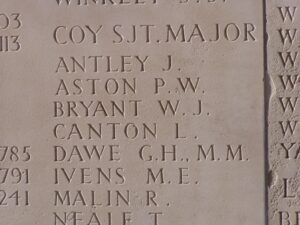
Wilfred Ernest Caswell, Corporal, 9282, Kings Shropshire Light Infantry. Wilfred was the son of Henry and Amy Caswell, of 14, Roslin Place, Newtown Road, Malvern, and the husband of Florence Ann Caswell, of 6, King Street East, Pembroke Dock. He was billeted at Pembroke Dock with the 3rd Battalion, KSLI after the war, due to have being medically downgraded after suffering from gas poisoning in France. Wilfred died as a result of being gassed on 10 February 1920. He was 25 years old, and is buried at Pembroke Dock (Llanion) Cemetery, in Grave Ref. U. 92. Wilfred is not commemorated at Pembroke Dock.
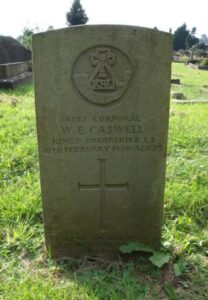
William Charles Stephen Chivers, Serjeant, 8975, Welsh Regiment. William was born at Bristol in 1885. He was a regular soldier, who had enlisted into the 2nd Battalion, Welsh Regiment prior to 1911. William was stationed with the battalion at Pembroke Dock prior to the war, where he met and married Mary L. Ward in 1912. The 2nd Welsh left Pembroke Dock for France at the outbreak of war, and landed in France on 13 August 1914, attached to 3 Brigade, 1st Division. The Division had been one of the first to arrive in France, fighting at the Battle of Mons, and taking part in the retreat to the Marne, where the Germans were stopped. They then fought at the Aisne, and at Chivy, before being moved north to Ypres. Here they fought at the First Battle of Ypres, where they again stopped the German Offensive, before wintering in Flanders. The following year saw them in action again at the Battle of Aubers Ridge. William was wounded at Aubers, and died on 28 May 1915. He is buried at Bailleul Communal Cemetery Extension, France, in Grave I. B. 43. Mary remarried after the war, to Bradfield Folland, of Pembroke Dock. William is commemorated at St. John’s Church.
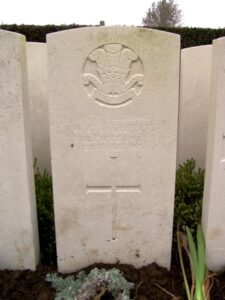
John Clements, Lance Sergeant, 26471, Duke of Edinburgh’s Wiltshire Regiment. John was born at Devizes, Wiltshire in 1884, the son of George and Alice Clements. He lived at Pembroke before the war, and returned to Devizes to enlist into the 6th Battalion, Wiltshire Regiment, which had originally landed in France in June 1915 attached to 58 Brigade, 19th (Western) Division. The Division took part in the opening attack of the Battle of Loos on 25 September 1915. The following year the Division moved to the Somme, where it took part in the second wave of the attack on Ovillers-La Boiselle on 1 July, capturing the village at heavy cost. It then fought through the Somme Battles of Pozieres and the Ancre in 1916. In 1917 the Division moved North to Ypres, taking part in the Battle of Messines, and fought on the Menin Road and at Polygon Wood, before moving up to Broodseinde, Poelcappelle and Passchendaele Village itself, before moving to positions near Ribecourt on the Somme. John was killed here on 22 January 1918, aged 34. His grave was lost during the German Offensive of March 1918, and he is commemorated on the Thiepval Memorial, France, on Pier and Face 13 A. John is commemorated at St. John’s Church.
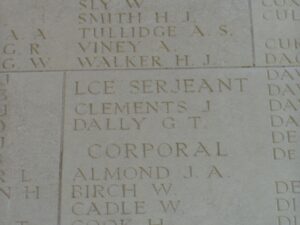
Henry Arnold Collett, Private, 2780, Welsh Guards. Henry was born in 1889, the son of Henry and Elizabeth Collett, of 6, New Ruperra Street, Newport. He resided at Pembroke Dock at the outbreak of war. He enlisted into the 1st Battalion, Welsh Guards, which was formed in February 1915, becoming attached to 3rd Guards Brigade, Guards Division, and saw his first major action during the Battle of Loos on 25 September 1915 The Guards remained in the area during the coming months, where they also fought in the subsequent Action of Hohenzollern Redoubt. In July, 1916 the Division moved to the Somme, where they fought at the Battle of Flers-Courcelette, and then at the Battle of Morval, capturing Lesboeufs Village. They remained here for the winter, and in March, 1917 took part in the advance caused by the German Retreat to the Hindenburg Line. Henry was killed here on 5 March 1917, aged 27. He is buried at Sailly-Saillisel British Cemetery, France, in Grave Ref. V. J. 7. Henry is not commemorated at Pembroke Dock.
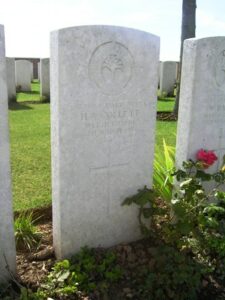
Thomas Joseph Collins, Private, 2141, Welsh Regiment. Thomas was born at Pembroke Dock in 1888, the son of Mary Collins. Mary was widowed, and married John Austen, of 27, Graigyhelva Road, Treforest, Pontypridd, and Thomas was raised there. He enlisted at Pontypridd into the 1/5th Battalion, Welsh Regiment, which was attached to 159 Brigade, 53rd (Welsh) Division. The 53rd (Welsh) Division moved to the Mediterranean, sailing from Devonport in July, 1915 arriving at Mudros by 5 August 1915. From here they moved to Gallipoli, landing on 9 August. Here the Division was immediately thrown into action, and spent the next few days in isolated pockets, fighting against a Turkish counter-attack during the Battle of Sari Bair, and then at the Attack on Scimitar Hill. The Division remained here throughout the coming months, and it was here that Joseph was wounded. He was evacuated to hospital in Egypt for treatment, but died of his wounds on 6 October 1915, aged 26. Joseph is buried at Alexandria (Chatby) Military and War Memorial Cemetery, Egypt, in Grave Ref. F. 62. Thomas is not commemorated at Pembroke Dock.
William John Davey, DSM, Petty Officer, 193429, Royal Navy. William was born at Pembroke Dock on 30 April 1880. He worked for the GPO prior to the war, and resided with his wife Catherine Ann Davey and their two daughters, at 13 Upper Park Street, Worcester. He enlisted into the Royal Navy, and served aboard HMS Lucia, which was a submarine depot ship that had been captured from the Germans early in the war. On 8 August 1918 William was decorated with the Distinguished Service Medal for his work during the war, but sadly died on 3 July 1920, aged 40. He is buried at Worcester (Astwood) Cemetery in Grave Ref. 14281. William is not commemorated at Pembroke Dock.
David John Davies, Private, 36059, Welsh Regiment. David was born at Swansea, the son of David and Anna Davies. The family later moved to 22, Drummond Street, Pembroke Dock, and David worked as a cabinet maker with his father. He enlisted at Neath into the South Wales Borderers, and was transferred to the 1st Battalion, Welsh Regiment, which was attached to 84 Brigade, 28th Division. The Division formed in England between December 1914 and January 1915 from regular units returning from India, Singapore and Egypt. During January 1915 it moved to France, landing at Le Havre and moved to the Western Front, where it saw its first major action during the Second Battle of Ypres. David was wounded at Ypres, and brought to hospital at Boulogne for treatment, but died there of his wounds on 23 July 1915, aged 27. He is buried at Boulogne Eastern Cemetery, France, in Grave Ref. VIII. B. 65. David is not commemorated at Pembroke Dock.
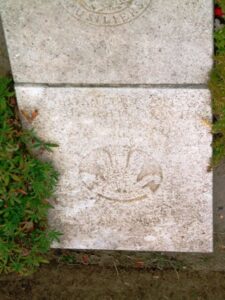
George Price Davies, Second Lieutenant, South Wales Borderers. George was the son of James and Louisa A. Davies, of 95, Gwyther Street, Pembroke Dock, and served with the 2nd Battalion, South Wales Borderers. The battalion had fought in Tientsin, China at the outbreak of war, then at Gallipoli, attached to 87 Brigade, 29th Division. The division then moved to France, and fought during the Battle of the Somme, and at Arras and Passchendaele the following year. They fought at the Battle of Cambrai in November and December, 1917 before moving back to Flanders early in 1918. The German Spring Offensive hit the British on the Somme on 21 March, 1918, and hit in Flanders just weeks later. The 29th Division fought at the desperate defensive battles of Estaires, Messines, Bailleul and Kemmel, before the war turned in favour of the Allies after a series of successes on the Somme in August. The Division then took part in the Offensive in Flanders, where they took part in the Action of Outtersteene Ridge, and then at the Battle of Ypres, and it was here that George was killed on 29 September 1918. He was 37 years old, and is buried at Zantvoorde British Cemetery, Belgium, in Grave Ref. I. D. 26. George is commemorated at St. John’s Church, and also has a stained glass window dedicated to him.
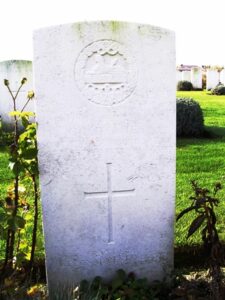
John Eleazor Garnant Davies, Lance Corporal, 6961, Oxfordshire and Buckinghamshire Light Infantry. John was the son of George and Claudia Davies, of The Elms, Killay, Swansea. He worked as a Bank Clerk at Pembroke Dock before the war, and enlisted there into the 2/1st Battalion, Ox and Bucks Light Infantry, which was attached to 184 Brigade, 61st (2nd South Midland) Division. The Division entrained for the Western Front on 21 May 1916, moving to positions at Fromelles. The first major action in which the Division was engaged turned out to be a disaster. An attack was made on 19 July 1916 at Fromelles, a subsidiary action to the much larger battle taking place further south on the Somme. The Division suffered very heavy casualties for no significant gain and no enemy reserves were diverted from the Somme. John was killed here on 14 October 1916. He was 21 years old, and is buried at Pont-Du-Hem Military Cemetery, La Gorgue, France, in Grave Ref. II. B. 13. John is not commemorated at Pembroke Dock.
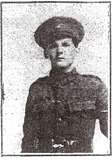
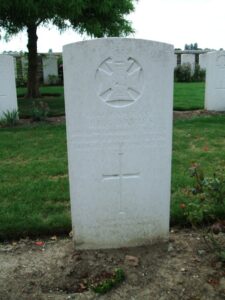
William Davies, Stoker 2nd Class, K/21697, Royal Navy. William was born at Pembroke Dock on 13 January 1894, the son of Elizabeth Davies, and was the nephew of Thomas Evans, of 49, Commercial St, Abergwynfe, Port Talbot. William served in the Royal Navy, aboard the cruiser HMS Monmouth. She was in reserve at the outbreak of war, but was put back into service as part of the West Indies Squadron. Monmouth was sunk with the loss of all hands during the Battle of the Coronel on 1 November 1914. William was 20 years old, and is commemorated on the Plymouth Naval Memorial, Devon, on Panel 3. William is not commemorated at Pembroke Dock.
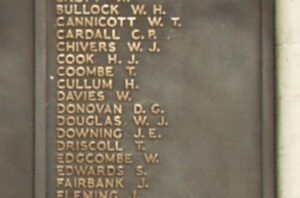
William John Davies, DSM, Shipwright 2nd Class, 344865, Royal Navy. William was born at Pembroke Dock on 30 November 1887, and was the Husband of Mary E. Davies, of 2, Meyrick Street, Pembroke Dock. He was a Shipwright in the Royal Navy, and served aboard HMS Lancaster. She was a Monmouth Class armoured cruiser, and served for the duration of the war, during which time William was awarded the Distinguished Service Medal. He died on 26 February 1919 aged 36, and is buried at Pembroke Dock (Llanion) Cemetery, in Grave Ref. U. 183. William is commemorated at St. John’s Church.
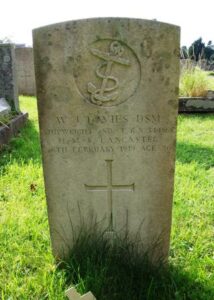
William Joseph Davies, Private, 6487, Kings Shropshire Light Infantry. William was born at Bromyard, Herefordshire in 1893, the son of William and Jane Davies. Prior to the war he resided with his wife, Elizabeth Davies, at 16, Queen Street, Pembroke Dock. William had enlisted at Bromyard into the 7th Battalion, KSLI, which was attached to 76 Brigade. The battalion had fought on the Western Front since the beginning of the war, and by 1917 was attached to the 3rd Division at Arras. William was killed at Arras on 27 April 1917, aged 23, and is buried at Fauborg D’Amiens Cemetery, Arras, in Grave Ref. V. C. 18. William is not commemorated at Pembroke Dock.
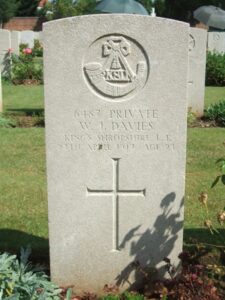
John Dawkins, Corporal, 245980, Durham Light Infantry. John was born at Neyland in 1894, the son of George and Sarah Dawkins. He resided at Pembroke Dock prior to the war, and enlisted at Pembroke into the Welsh Regiment, before being transferred to the 1/5th Battalion, Durham Light Infantry, which was attached to 151 Brigade, 50th (Northumbrian) Division. The division moved to France during April 1915 and saw their first action at Second Ypres. It then fought through the Somme Offensive, and also at Arras and Passchendaele, During March, 1918 they were stationed near St. Quentin, and were hit here by the German Spring Offensive of 21 March 1918 during the Battle of St Quentin. They took part in a gallant rearguard action during the Actions at the Somme Crossings, and then at the Battle of Rosieres. After suffering terrible casualties, the Division moved north to Flanders to rest and rebuild, but in April the Germans launched an attack in Flanders, around the Lys, and the Division took part in the Battle of Estaires, and the Battle of Hazebrouck. Following a most trying time on the Somme and Lys battlefields, the Division was withdrawn and sent to IX Corps, then on the Aisne, believed to be a much quieter area. This was unfortunately not the case, as the Division was hit hard by a surprise enemy attack, and fought at the Battle of the Aisne, 1918. John was killed here on 27 May 1918, aged 23. He has no known grave, and is commemorated on the Soissons Memorial, France. John is commemorated at St. John’s Church.
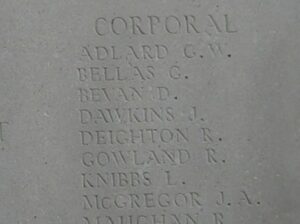
Richard Stanley Dier, Private, 10572, Royal Welsh Fusiliers. Richard was born in 1892, the son of Richard and Caroline Dier, of Pembroke Dock. He was a pre-war regular soldier, having enlisted at Cardiff into the 1st Battalion, Royal Welsh Fusiliers at during March 1911. At the outbreak of war the battalion joined 22 Brigade, 7th Division, and moved to Zeebrugge on 7 August 1914. By then the City was falling to the Germans, and 7th Division moved to Ypres, where it took part in the first desperate Battle of Ypres, where the German advance on the Channel posts was halted. Richard was killed at Ypres on 19 October 1914, aged 21. Richard has no known grave, and is commemorated on the Ypres (Menin Gate) Memorial, Belgium, on Panel 22. Richard is commemorated at St. John’s Church.
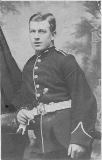
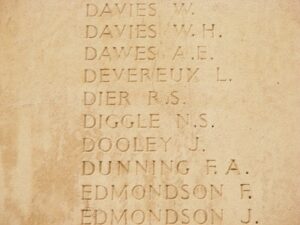
William Alexander Duggan, Sergeant, 7412, Wiltshire Regiment. William was born at Horfield, Gloucester on 21 November 1885, the son of S.Q.M.S. James Duggan (R.A.S.C.) and Agnes Duggan. The family was residing at Pembroke Dock by 1901, and William was educated there before following in his father’s footsteps, and enlisting at Pembroke Dock into the Wiltshire Regiment prior to the war. His parents had by then retired to 99, Warley Road, Brentwood, Essex. At the outbreak of war, William was posted to France with the 2nd Battalion, Wiltshire Regiment, which was attached to 21 Brigade, 7th Division, and moved to Zeebrugge on 7 August 1914. By then the City was falling to the Germans, and 7th Division moved to Ypres, where it took part in the first desperate Battle of Ypres, where the German advance on the Channel posts was halted. William was killed in the following Battle of Neuve Chapelle, on 14 March 1915, aged 28. He is buried at Estaires Communal Cemetery and Extension, in Grave Ref. II. T. 3. William is not commemorated at Pembroke Dock.
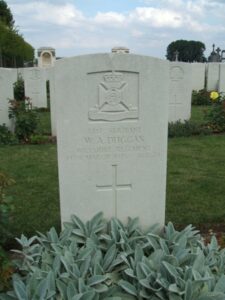
Horton John Edwards, Gunner, 371067, Royal Garrison Artillery. Horton was the youngest son of Thomas and Elizabeth Edwards, of Pembroke House, Pennar, Pembroke Dock, and enlisted there into the Royal Garrison Artillery. He was posted to the 393rd Siege Battery, and moved to the Western Front. On 2 October 1917, Horton was manning his gun in a gun pit south-west of Ypres, when a German shell burst nearby, sending shrapnel flying into the gun crew, wounding Horton and several others. Sadly, Horton had been mortally wounded in the chest. His wounds were dressed by his comrades, who sent him to the 57th Field Ambulance, where Horton died within half an hour. He was 21 years old, and is buried at Voormezeele Enclosures Cemetery, No. 1 & No. 2, Belgium, in Grave Ref. I. K. 23. Horton is not commemorated at Pembroke Dock.
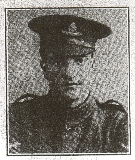
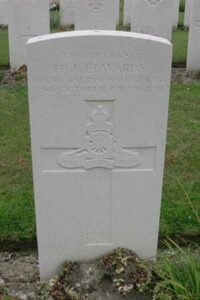
Sidney Thomas Elliot, Private, 2284, Australian Infantry. Sidney was born at Portsmouth in 1892, the son of Sidney Adolphus and Elizabeth Elliott. By 1901 the family had moved back to Elizabeth’s home town, and resided at 47, Laws Street, Pembroke Dock. Sidney had emigrated to Australia, along with his brother Sidney Adolphus Elliot prior to the war, and enlisted at Victoria on 8 July 1915 into the 21st Battalion, Australian Imperial Force. Sidney embarked at Melbourne aboard HMAT Hororato on 27 September 1915 and sailed for Egypt, before moving to France aboard the SS Oriana on21 March 1916. There he joined his battalion in the field, where it was attached to the 6th Australian Brigade, 2nd Australian Division, and the division moved to positions near Fromelles in Northern France. Sidney then moved to the Somme with the battalion, and fought during the Battle of Pozieres, and in the later fighting at Mouquet Farm, before being hospitalised, with an abscess on his spine. He rejoined the battalion on 2 December 1916, and remained with it during the Australians first winter on the Somme of 1916/17. On 20 March 1917, the 21st Battalion was in the line near Noreuil, and a patrol was sent out to ascertain the whereabouts of the German lines. Sidney was killed that day during an ensuing engagement. He was 24 years old, and is commemorated on the Villers-Brettoneaux Memorial, France. Sidney is commemorated at St. John’s Church.
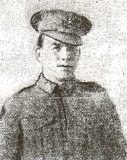
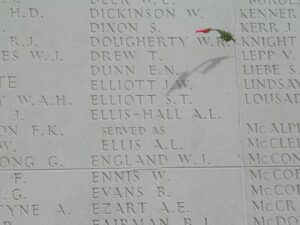
Henry Ellis, Sapper, 95232, Royal Engineers. Henry (Harry) was born at Pembroke Dock in 1896, the son of John George and Mary Anne Ellis, of 30, Queen Street. His parents later resided at 11, Elksley Road, Warsop, Mansfield, Notts. Harry served his apprenticeship at Portsmouth Dockyard before returning to work at Pembroke Dockyard prior to the war. He enlisted at Pembroke Dock into the Royal Engineers, being posted to their 131st Field Company, which was attached to the 26th Division. Embarkation for France began in September 1915, and the concentration of units at Guignemicourt, west of Amiens, was completed before the end of the month. However in November 1915 the Division moved to Salonika, where it then remained. On 26 December 1915 units began to move from Lembet to Happy Valley Camp, and all units were in place there by 8 February. The Division then took part in the Battle of Horseshoe Hill, between 10-18 August 1916, the Battle of Doiran between 24-25 April and 8-9 May 1917. Harry was killed in action the following summer, on 17 May 1918. He was 21 years old, and is commemorated on the Doiran Memorial, Salonika. Harry was the holder of the Italian ‘Al Valore Militaire’. (Bronze Medal for Military Valour). Harry is not commemorated at Pembroke Dock.
James Henry Ellis, Drummer, 9260, Devonshire Regiment. James was born at Pembroke Dock, the son of William H. and Lavinia G. Ellis. By 1901 the family had moved to 10, Oxford Place, Plymouth. James enlisted at Devonport into the 1st Battalion, Devonshire Regiment, which was attached to 8 Brigade, 3rd Division. One of the first Divisions to move to France, the 3rd Division remained on the Western Front throughout the war, and fought during the opening Battle of Mons, and in the epic retreat, from the Rearguard Action of Solesmes, through the Battle of Le Cateau, and down to the Marne, where the German Offensive was stopped. They followed the German withdrawal to the Aisne, where they met them in battle, and stopped the advance on Paris. The Division then moved north to Flanders, and took part in the Battle of La Bassée, and at the Battle of Messines, which were a prelude to the First Battle of Ypres. They took part in the famous Christmas Truce on 25 December 1914 and remained at Ypres throughout the winter. James was killed here on 14 January 1915, aged 18. He has no known grave, and is commemorated on the Ypres (Menin Gate) Memorial, Belgium, on Panel 21. James is not commemorated at Pembroke Dock.
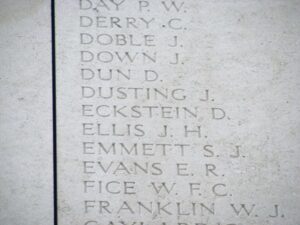
Thomas Edward Emment, Corporal, 18823, Welsh Regiment. Thomas was born at Pembroke Dock in 1890. He worked as a Draper prior to the war, and resided with his sister, Miss Rosa Emment, at 4, Loraine Road, Holloway, London. Thomas enlisted at London into the 9th Battalion, Welsh Regiment, which was attached to 58 Brigade, 19th (Western) Division, and landed in France during July 1915. The division moved to positions near La Bassee, north of Loos, where they took part in the opening assault of the Battle of Loos on 25 September 1915. Thomas was killed in action that day, aged 24. He has no known grave, and is commemorated on the Loos Memorial, France, on Panel 77 & 78. Thomas is commemorated at St. John’s Church, and at St. Teilo’s.
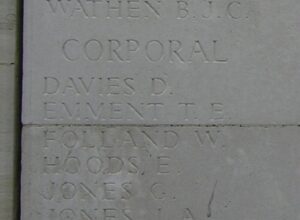
David Edgar Evans, Lance Corporal, 9746, Royal Fusiliers. David was born in 1895, the son of John Thomas Evans and Frances Bell Evans, of 101, Gwyther Street, Pembroke Dock. He enlisted at Pembroke Dock into the Army, and was posted to the 7th Battalion, Royal Fusiliers, which was attached to 190 Brigade, 63rd (Royal Naval) Division. The Naval Brigades were originally sent to Antwerp and Dunkirk in September and October, 1914 to guard against invasion by the Germans. However, Antwerp fell to the Germans soon after, and so many of the RND units were withdrawn to England. After a lengthy period of refit and training the Division moved to Egypt preparatory to the Gallipoli campaign. Landing on 25 April 1915, the Division fought throughout the Campaign on Gallipoli. They were transferred from the authority of the Admiralty to the War Office on 29 April 1916, and was re-designated the 63rd (Royal Naval) Division on 19 July 1916. The Division moved to France, arriving at Marseilles between 12 and 23 May 1916 and moved to positions on the Somme, where it took part in the Battle of the Ancre, and the resulting Operations on the Ancre. David was killed on the Ancre on 13 November 1916, aged 21. He is buried in Ancre British Cemetery, Beaumont Hamel, France, in grave Ref. III. A. 6. David is commemorated at St. John’s Church.
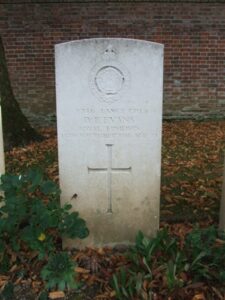
George Evans, Petty Officer, 206834, Royal Navy. George was born at Bosherston on 22 February 1883, the son of John and Elizabeth Evans. He married Alice Rose Davies in 1912, and the couple set up home at 93, Gwyther Street, Pembroke Dock. George served in the Royal Navy aboard HMS Tipperary. Tipperary led the 4th Flotilla at the Battle of Jutland, and continued torpedo attacks on the German main battle line as it escaped from the main British fleet during the night action, on 31 May 1916. The 4th Flotilla sank one of the German light cruisers, but Tipperary was sunk in the morning of 1 June 1916 by the German dreadnought SMS Westfalen, with the loss of 185 hands from her crew of 197. George was among the dead. He was 33 years old, and is commemorated on Panel 11 of the Portsmouth Naval Memorial, Hampshire. George is commemorated at St. John’s Church.
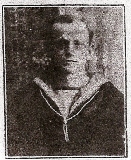
John Edward Martin Evans, Lieutenant (Observer), Royal Flying Corps. John was the son of William and Eleanor Evans, of Pembroke Dock, and the husband of Emily Ethel Evans, of 116, Hemingford Road, Barnsbury, London. He had originally served with the 8th Battalion, Manchester Regiment, but was commissioned into the Royal Flying Corps, joining 48 Squadron as an Observer. John died of wounds suffered when he crashed in his Bristol F2b, Serial B1210 on 9 February 1918. He was 24 years old, and is buried at Roye New British Cemetery, France, in Grave Ref. III. A. 7. John is commemorated at St. John’s Church.
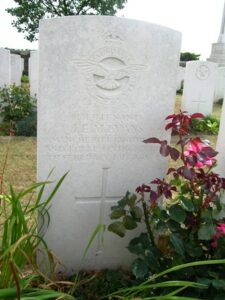
William John Evans, Sergeant, 18868, Kings Liverpool Regiment. William was born at Pembroke Dock on 26 October 1889, the son of William and Jessie Evans. Following the death of his father, his mother remarried to Henry Bowen Jenkins, and later moved to 23, St. John’s Road, Portsmouth. William worked as a labourer prior to enlisting at Liverpool into the King’s (Liverpool) Regiment on 7 September 1914. He was then posted to the 14th Battalion, Liverpool Regiment, which was attached to 65 Brigade, 22nd Division. The Division crossed to France in early September 1915, with all units being concentrated near Flesselles by 9 September. On 27 October 1915 the Division, having been moved by train to Marseilles, began to embark for Salonika, as part of a combined Anglo-French force sent to aid the Greek Army. The division completed concentration there in November, and remained in the theatre for the rest of the war. William died of wounds in Salonika on 13 January 1918, aged 27. He is buried at Sarigol Military Cemetery, Kriston, in Grave Ref. D. 165. William is not commemorated at Pembroke Dock.
William Flood, MM, Sergeant, 58589, Royal Field Artillery. William was born at Malta in 1894, the son of Michael and Mary Flood. The family then resided at Pembroke Dock for several years, before moving to St Helens, Lancashire. William remained at Pembroke Dock, and enlisted there on 6 September 1909, into the Pembrokeshire Royal Garrison Artillery. At the outbreak of war, William was posted to D Battery, 14th Brigade, Royal Field Artillery, and moved to France on 23 August 1914. William was awarded the Military Medal for bravery during the Battle of the Somme, but was killed on the Somme on 7 September 1916. He is buried at Quarry Cemetery, Montauban, France, in Grave Ref. VI. A. 2. William is not commemorated at Pembroke Dock.
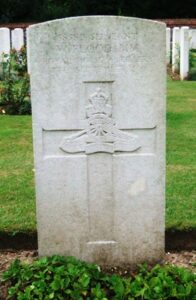
Charles John Footman, Private, 2359, Welsh Regiment. Charles was born in Pembroke Dock early in 1888, the son of John Charles and Sarah Footman (nee Davies), of the Duke of York Inn and Grocers Shop. The family later moved to 16, Trinity Street, Gorseinon, Swansea, after John got work there as a Foreman with a building company. Charles worked as a Fireman at the Grovesend Steelworks prior to the war, and enlisted at Swansea into the local Territorial battalion, the 1/6th Battalion, Welsh Regiment. The battalion was one of the first territorial units to move to France in August 1914. Initially, in late 1914 and early 1915, they were on lines of communication and in July 1915 were based near Locre and Kemmel area, facing the Germans who were on the high ground at Spanbroekmolen. The battalion was in the trenches, but also doing work repairing trenches etc. On the morning of 3 August 1915, Charles was sniped through the head whilst looking over the parapet. He died instantaneously and was buried that afternoon in the grounds of the nearby Lindenhoek Chateau. The cemetery is now known as Lindenhoek Chalet Military Cemetery, Belgium. His brother George was killed just five months later. Charles is not commemorated at Pembroke Dock.
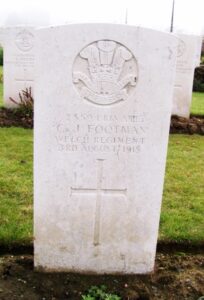
George Henry Footman, Sapper, 151337, Royal Engineers. George was born in Pembroke Dock on 16 June 1889, the son of John Charles and Sarah Footman (nee Davies), of the Duke of York Inn and Grocers Shop. The family later moved to 16, Trinity Street, Gorseinon, Swansea, after John got work there as a Foreman with a building company. George worked as a Collier prior to the war, and married Sarah Ann Roberts at Swansea on 20 July 1912, the couple taking up residence at 23, Garden Crescent, Garden Village, Gorseinon, where they raised two children. George enlisted into the 10th Battalion, Devonshire Regiment early in the war, moving to France on 23 September 1915, where the battalion was attached to 79 Brigade, 26th Division. Due to his mining skills, George was transferred into the 253rd Tunnelling Company, Royal Engineers, which formed in January 1916, at Sailly Labourse, moving to the front line areas of the old Loos battlefield, north of the Vermelles-Hulluch road. George was killed here on 19 January 1916, probably whilst working underground. He was 27 years old, and is commemorated on the Loos Memorial, France. George is not commemorated at Pembroke Dock, although both he and his brother Charles (above) were born there.
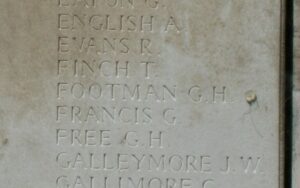
Edwin Ford, Private, 6713, Duke of Edinburgh’s Wiltshire Regiment. Edwin was the son of Mrs. A. Ford, of 26, Westbourne Road, Trowbridge, and the husband of Sarah Ann Ford, of 15, Brewery Street, Pembroke Dock. He enlisted at Trowbridge into the 1st Battalion, Wiltshire Regiment, which was attached to 7 Brigade, 3rd Division. One of the first Divisions to move to France, the 3rd Division remained on the Western Front throughout the war, and fought during the opening Battle of Mons, and in the epic retreat, from the Rearguard Action of Solesmes, through the Battle of Le Cateau, and down to the Marne, where the German Offensive was stopped. They followed the German withdrawal to the Aisne, where they met them in battle, and stopped the advance on Paris. The Division then moved north to Flanders, and took part in the Battle of La Bassée, and at the Battle of Messines, which were a prelude to the First Battle of Ypres. Edwin was killed at Ypres on 31 October 1914. He was 28 years old, and is commemorated on the Le Touret Memorial, Richebourg L’Avoue, France, on Panel 33 & 34. Edwin is not commemorated at Pembroke Dock.
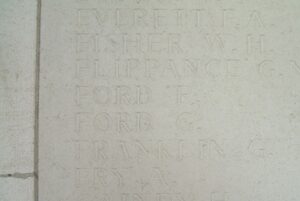
William Reginald Fowler, Drummer, 9032, Devonshire Regiment. William was born at Pembroke Dock in 1895, the son of John and Kate Maria Fowler. The family later resided at 57, Lion Road, Bedminster, Bristol. William enlisted at Guildford into the 1st Battalion, Devonshire Regiment, which was attached to 95 Brigade, 5th Division. The Division had landed at Havre on 15 August, 1914, and fought at the Battle of Mons, and during the retreat south, fighting at Le Cateau, then down to the Marne where the German attack was halted. They took part in the advance to the Aisne, before moving to Flanders, where they fought at the Battle of La Bassée, then at Messines in October, 1914. They fought here through First Ypres, and took part in the capture of Hill 60, and then fought at Second Ypres in April 1915. March 1916 saw the Division moving to positions between St. Laurent-Blangy and Vimy, near Arras, and the Division saw plenty of action during its spell here. On 1 July 1916 the Battle of the Somme opened, and the Division moved south fighting at High Wood, and it was there that William was wounded. He died of his wounds on 25 July 1916, aged 21. He is buried at Mericourt-L’Abbe Communal Cemetery Extension, France, in Grave Ref. II. D. 11. William is not commemorated at Pembroke Dock.
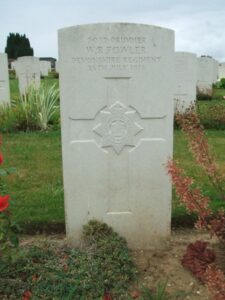
Ernest George Furnaess, Private, 34154, South Lancashire Regiment. Ernest was born at Pennar in 1887, the son of John Furnaess and Sarah Ann Furnaess (nee Britten). He enlisted at Pembroke into the 10th Battalion, Welsh Regiment on 10 September 1914, and was posted to North Wales, where the battalion became attached to the 38th (Welsh) Division. Ernest married Susannah Jones at St. Asaph early in 1915. He landed in France with the 38th Division on 2 December 1915, before being transferred to the 8th Battalion, South Lancashire Regiment, which formed part of 75 Brigade, 25th Division. The Division had been in France since 26 September 1915, and were posted to the Vimy area, where they defended Vimy Ridge against a German attack in May 1916. They then moved to the Warloy area and attacked on 3 July near Thiepval. They fought throughout the Battle of the Somme, and were there when Ernest was killed on 29 August 1916, aged 28. He is commemorated on the Thiepval Memorial, France, on Pier and Face 7 A and 7 B. Ernest is not commemorated at Pembroke Dock.
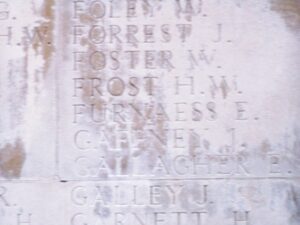
John Genese, Battery Quartermaster Sergeant, 21633, Royal Field Artillery. John was born at Pembroke Dock in 1881, the son of Joseph and Matilda Genese (nee Hunt). The family later resided at 11, Elliscombe Road, Charlton, London, where John had married, and lived with his wife Amy Grace Genese at 6, Helen Street, Woolwich while he was stationed at the Woolwich Barracks. John had served in the South African Campaign with 66th Battery, Royal Field Artillery, and during the Great War served with the 6th Ammunition Column, RFA, which was based in Mesopotamia. John died in Mesopotamia on 23 November 1917, aged 36. He is buried at Baghdad (North Gate) War Cemetery, Iraq, in Grave Ref. XXI. Y. 29. John is not commemorated at Pembroke Dock.
Gerald Parker Goldstraw, Private, 19483, Royal Fusiliers. Gerald was born at Pembroke Dock in 1895, the son of William Walter and Eva Mary Goldstraw. His father was a Methodist Minister, and the family travelled around the country prior to the war, residing at Dover when war broke out. Gerald enlisted at Portsmouth into the 26th Battalion (Bankers), Royal Fusiliers. The battalion formed part of 124 Brigade, 41st Division, and moved to France by 6 May 1916, concentrating near Steenwerck, where they began familiarisation with trench warfare in the areas of Ploegsteert and the Douve valley, south of Ypres. They remained here until August 1916, when they moved to the Somme, and took part in the Battle of Flers-Courcelette. The Division remained in the line, pushing on to Courcelette over the next few days before coming out for a rest and re-fit. They then fought at the Battle of Le Transloy, and it was there that Gerald was killed on 4 October 1916, aged 21. He is commemorated on the Thiepval Memorial, France, on Pier and Face 8 C, 9 A and 16 A, and also on the Dover War Memorial. Gerald is not commemorated at Pembroke Dock.
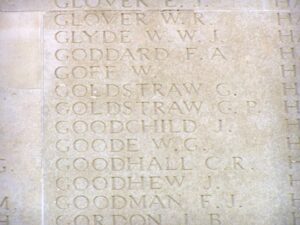
Albert Edward Goulby, Leading Signalman, 236755, Royal Navy. Albert was born at Derby on 25 August 1890. He was a pre-war regular in the Royal Navy, where he served as a Signalman, and he married Emmie Rees, of 40, Front Street, Pembroke Dock, whilst based at Pembroke Dock in 1915. Albert served with the Royal Navy, aboard HMS Orion. She was the first ever ‘super-dreadnought’ battleship, and was attached to the 2nd Battle Cruiser Squadron of the Grand Fleet. Albert served aboard Orion during the Battle of Jutland on 31 May 1916. He was possibly wounded during the battle, and died on 15 August 1916, aged 25. Albert is buried at Nottingham General Cemetery, England, and is commemorated on the Screen Wall, ref. 03378. Albert is not commemorated at Pembroke Dock.
Joseph Edward Grace, Bandmaster, 11511, Royal Scots. Joseph was the son of the late Joseph and Annie Grace, of Shrewsbury. He married Helena Rose Rodger at Kingston on 17 October 1912, and she later lived at 15, London Road, Pembroke Dock. Joseph had enlisted into the King’s Shropshire Light Infantry as a boy soldier on 10 August 1896, and became a renowned musician, attending the Royal College of Music from 1912, before being appointed Bandmaster of the 2nd Battalion, Royal Scots on 5 September 1912. At the outbreak of war, Joseph was posted to the 3rd Battalion, and remained on home service until after the armistice, when he rejoined the 2nd Battalion, which was attached to the occupation forces in Germany. Joseph became ill and died there of pneumonia on 1 March 1919, aged 35. He is buried at Cologne Southern Cemetery, Germany, in Grave Ref. IX. F. 8. Joseph is not commemorated at Pembroke Dock.
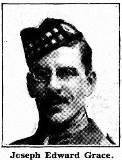
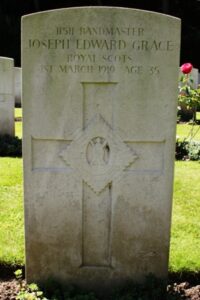
James Sinclair Graham, MID, Corporal, 14584, Royal Engineers. James was the son of Peter and Jane Graham, of Pembroke Dock, and the husband of Anne Graham, of 48, Military Road, Pennar, Pembroke Dock. He enlisted at Pembroke into the Royal Engineers at some time prior to 1911, and at the outbreak of war landed in France with the BEF. James was later posted to the 57th Field Company, Royal Engineers, which was attached to the 49th (West Riding) Division. The Division moved to France between 12 and 19 April 1915 and saw its first major action on the Somme, during the Battle of Albert. They remained on the Somme, taking part in the Battle of Bazentin, the Battle of Pozieres, and the Battle of Flers-Courcelette, and the following year saw action at Third Ypres, during the Battle of Poelcapelle. James was wounded here, and brought back to Ypres for treatment, but sadly he died of his wounds on 13 October 1917, aged 36. James is buried at Ypres Reservoir Cemetery, Belgium, in grave ref. I. H. 30. James was Mentioned in Sir Douglas Haig’s Despatches for bravery during his time at war. James is not commemorated at Pembroke Dock.
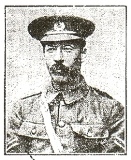
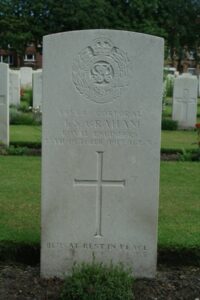
Cyril Norman Green, Driver, 122243, Royal Field Artillery. Cyril was born at Pembroke Dock in 1896, the son of John and Bessie Rundle Green. The family later resided at 7, Bridge Street, Haverfordwest, after moving around West Wales, living at Tenby, Brecon, and Haverfordwest, which is where Cyril enlisted into the Royal Field Artillery. He was posted to the 55th Division Ammunition Column, Royal Field Artillery, which was attached to the 55th (West Lancashire) Division. The complete Division was reformed in France during January 1916, and relieved the French 88th Division south of Arras by 16 February. Trench warfare commenced, with many raids and minor operations. Relieved by the 11th (Northern) Division on 25 July, the division moved south and took up a place in the front line opposite the village of Guillemont. Here they fought at the Battle of Guillemont and the Battle of Ginchy. There was a short period of rest at Ribemont from 12 to 17 September, and then the Division fought at the Battle of Flers-Courcelette and the Battle of Morval. Relieved by 41st Division on 28 September, the Division withdrew to the area of Buire and Ribemont, before relieving the 29th Division in the Ypres salient in October 1916. It was destined to remain in this area for almost a year, stationed near Railway Wood. Cyril was wounded at Railway Wood, and evacuated to the Base Hospital at Boulogne, where he died of wounds on 11 March 1917. He was just 21 years old, and is buried at Boulogne Eastern Cemetery, France, in Grave Ref. VIII. A. 190. Cyril is not commemorated at Pembroke Dock.
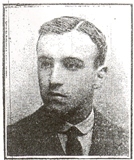
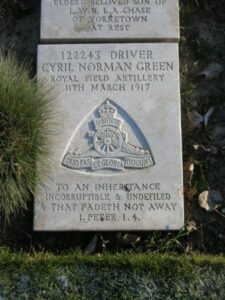
Edward Trewent Greenland, Sapper, 26666, Royal Engineers. Edward was born at Pembroke Dock, and was the son of James David Philip Greenland and Eliza Jane Greenland. He had served on the Western Front since landing on 6 September 1915, before returning to Britain, and serving with G Depot Company, Royal Engineers. Edward died of pneumonia at Brentford, Middlesex on 1 April 1920, aged 25. Edward is buried at New Brentford Cemetery, Essex, in Grave Ref. F. G. 142. Edward is not commemorated at Pembroke Dock.
Patrick John Griffin, MM, Lance Corporal, 20709, Royal Engineers. Patrick had been born at Pembroke Dock in 1893, the son of Robert and Margaret Griffin. The family later moved to Crown Inn, Shorne, Gravesend, Kent. He enlisted at Gravesend prior to 1911, and at the outbreak of war moved to France attached to the 15th Field Company, Royal Engineers, which was attached to the 8th Division. The Division was formed during October 1914, by the bringing together of regular army units from various points around the British Empire. The Division moved to the Western Front in November 1914, a badly-needed reinforcement to the BEF which had been all but wiped out at Ypres. They saw their first major action at the Battle of Neuve Chapelle, and then at the Battle of Aubers. They then saw further fighting at the Action of Bois Grenier, before moving to the Somme in 1916, where they fought at the Battle of Albert. In March, 1917 they followed the German Retreat to the Hindenburg Line, and later that year moved to Ypres. John was killed there on 7 July 1917, aged 23. He is buried at Brandhoek Military Cemetery, Belgium, in Grave Ref. II. M. 3. Patrick is not commemorated at Pembroke Dock.
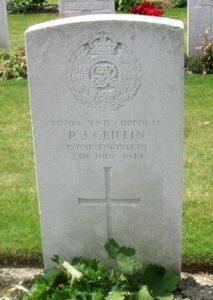
David Arthur Griffiths, Ordinary Seaman, Z/5091, Royal Navy. David was born on 22 June 1900, the son of David and Ellen Griffiths, of 2, Annesley Street, Llanelly. He was a Boy Writer at Pembroke Dockyard, prior to serving as Ordinary Seaman in the Royal Navy, at HMS Victory VI. The base was a training base for recruits, based at Crystal Palace. David took ill while training here, and died of pneumonia on 14 October 1918, aged just 18. His remains were brought home for burial at Llanelli (Box) Cemetery, Wales, in grave ref. II. 23. 3. David is not commemorated at Pembroke Dock.
David George Griffiths, Corporal, 320217, Welsh Regiment. David was the son of Benjamin John and Elizabeth Griffiths, of Pembroke Dock. He enlisted at Tenby on 10 August 1914, into the Pembroke Yeomanry, with the army number 4262, and moved with the Yeomanry out to Egypt in 1916. In March 1917 the Pembroke Yeomanry was merged with the Glamorgan Yeomanry to form the 24th Battalion, Welsh Regiment, as part of 231 Brigade, 74th (Yeomanry) Division. The division moved into Palestine, and took part in the Second and Third Battles of Gaza, and it was during the latter, on 6 November 1917, that David was killed. He was 22 years old, and is buried at Beersheba War Cemetery, Israel, in Grave Ref. K. 67. David is not commemorated at Pembroke Dock.
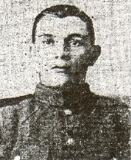
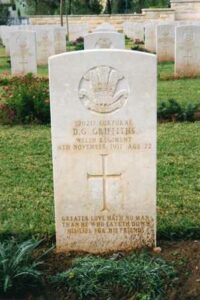
David Thomas Griffiths, Private, 53195, Cheshire Regiment. David was the son of Thomas and Jane Griffiths of Nailers Arms, Pontllanfraith, Monmouthshire. He had served prior to the war with the Royal Engineers, before leaving the forces, and working at Pembroke Dock as a mason. David was called up from the army reserve on 21 July 1916, and enlisted at Pembroke Dock into the Liverpool Regiment. He was then posted to the 9th Battalion, Cheshire Regiment, which was attached to 56 Brigade, 19th (Western) Division. The division had landed in France in July 1915 and fought during the Battle of Loos, the Somme in 1916, and at Arras, Messines and Passchendaele in 1917. David landed in France on 26 March 1918, joining the battalion at Ploegsteert, where it was rebuilding after heavy fighting on the Somme. On 9 April 1918 the Germans launched their offensive on the Lys, and the 19th Division was hit hard when it was attacked by a superior number of German troops, causing huge casualties. David was killed here on 10 April 1918, aged 37. He has no known grave, and is commemorated on the Tyne Cot Memorial, Belgium, on Panel 61 to 63. David is not commemorated at Pembroke Dock.
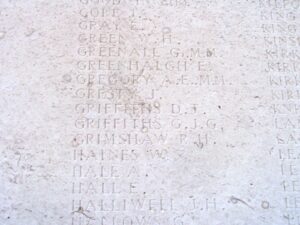
John Alfred Griffiths, Sergeant, 17945, Welsh Regiment. John was born at Walwyn’s Castle in 1889, the son of Mary Griffiths. Mary was widowed prior to 1901, and married George Bailey Richards, of 5, Fleet Street, Pennar. John was raised at Pennar, and worked as a Policeman at Mumbles prior to the war. He enlisted there into the 14th Battalion, Welsh Regiment, which was known as the Swansea Pals. The Battalion was raised at Swansea by the Mayor and Corporation with the Swansea Football and Cricket Club, and moved to Rhyl in 129 Brigade, 43rd Division. After training, the Division moved to Winchester, where the formation became 114 Brigade, 38th (Welsh) Division, and in December 1915 landed at Le Havre. The Division moved to positions in the so called Nursery Sector near Fleurbaix, and received instruction in trench warfare from the Guards and 19th Divisions. It moved to positions on the La Basseé Canal in the spring of 1916. The 14th Welsh were in the front line trenches at Givenchy when John was killed, on 13 March 1916, aged 27. He is buried at Guards Cemetery, Windy Corner, Cuinchy, France, in grave ref. III. M. 12. John is commemorated at St. John’s Church.
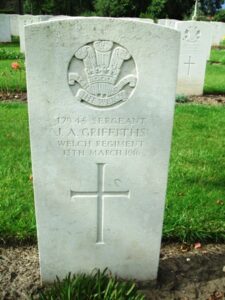
Gordon Valentine Gwyther, Driver, 105702, Royal Field Artillery. Gordon was the son of William Parsell Gwyther and Sarah Gwyther, of 79, Gwyther Street, Pembroke Dock. He served with the 268th Brigade, Royal Field Artillery, which served in Egypt and Palestine. Gordon was killed in Palestine, during the Third Battle of Gaza, on 4 November 1917, aged 33. He is buried at Beersheba War Cemetery, Israel, in Grave Ref. A. 33. Gordon is not commemorated at Pembroke Dock.
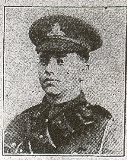
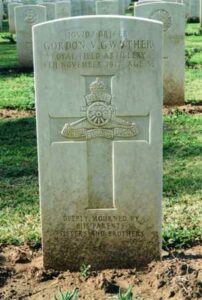
Thomas Handley, Lance Corporal, 15194, South Lancashire Regiment. Thomas was born at Pembroke Dock in 1891, the son of Charles and Eliza Jane Handley. The family had moved to 23, Adare Street, Gilfach Goch prior to the war, and Thomas enlisted at Swansea on 10 September 1914 into the army. Thomas was posted to the 8th Battalion, South Lancashire Regiment, which was attached to 75 Brigade, 25th Division. The Division landed in France on 26 September 1915, and were posted to the Vimy area, where they defended Vimy Ridge against a German attack in May 1916. They then moved to the Warloy area and attacked on 3 July near Thiepval. They fought throughout the Battle of the Somme, and it was during the latter stages of the offensive that Thomas was killed on 11 October 1916, aged 25. He is commemorated on the Thiepval Memorial, France, on Pier and Face 7A/7B. Thomas is not commemorated at Pembroke Dock.
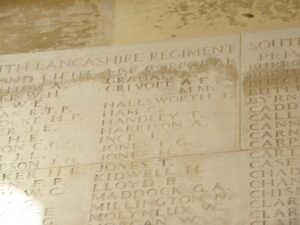
George Sydney Hanson, Rifleman, S/25268, Rifle Brigade. Sydney was born at Pembroke Dock in 1882, the son of Thomas and Susan Hanson. He worked as a Grocer prior to the war, and lived with his wife Edith Constance Hanson at 41, Queens Head Street, Essex Road, Islington. He enlisted there into the 8th Battalion, Rifle Brigade, which was attached to 41 Brigade, 14th (Light) Division. The Division was to see its first action during the Action of Hooge, where the Division were the first to be attacked by the German use of flamethrowers. They then fought at the Second attack on Bellewaarde. In July, 1916 they moved to the Somme, and fought at the Battle of Delville Wood, and then the Battle of Flers-Courcelette, and in March, 1917 followed the German Retreat to the Hindenburg Line. May saw them at Arras, where they took part in the First Battle of the Scarpe, and it was there that Sydney was killed on 3 May 1917. He has no known grave, and is commemorated on the Arras Memorial, France, on Bay 9. George is not commemorated at Pembroke Dock.
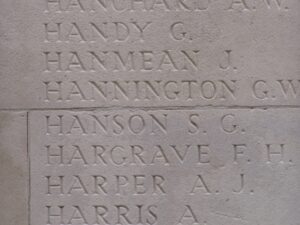
William George Hobbs, Shipwright 2nd Class, M/21471, Royal Navy. William was born on 23 January 1895, the son of George and Isabella Hobbs, of 84, Gwyther Street, Pembroke Dock. He served with the Royal Navy, aboard HMS Laurentic. William drowned when Laurentic struck a mine of the north Irish coast on 25 January 1917 and sank. He was 21 years old, and is commemorated on panel 22 of the Plymouth Naval Memorial, Devon. William is commemorated at St. John’s Church.
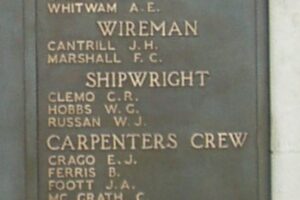
Gwyn Reginald Holloway, Private, S/10536, Royal Munster Fusiliers. Gwyn was the son of James Holloway (Army Schoolmaster) and Augusta Mary Holloway, of Pembroke Dock. He enlisted into the 5th Lancers in February 1913, before joining the 2nd Battalion, Royal Munster Fusiliers, using the name of George Holloway. Gwyn is recorded as having served in Gallipoli, before joining the 2nd Munsters in France, where the battalion was attached to 3 Brigade, 1st Division. Gwyn probably served with them on the Somme in 1916, and was killed the following year, on 10 July 1917, after the division had been moved to Flanders. He was 26 years old, and is buried at Coxyde Military Cemetery, Belgium, in Grave Ref. I. G. 16. Gwyn is not commemorated at Pembroke Dock.
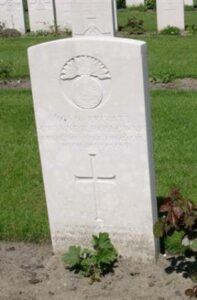
Henry Wareham Hopkins, Private, 37219, Royal Army Medical Corps. Henry was born at Pembroke Dock, the son of William F. Hopkins and Ellen Elizabeth Hopkins, of 17, Arthur Street, Pembroke Dock. The family later moved to 70, East Block, Brookhill Quarters, Woolwich, London. Henry enlisted at Pembroke into the Royal Army Medical Corps, and was posted to their 77th Field Ambulance, which was attached to the 25th Division in France. The Division landed in France on 26 September, 1915, and were posted to the Vimy area, where they defended Vimy Ridge against a German attack in May 1916. They then moved to the Warloy area and attacked on 3 July near Thiepval. They fought throughout the Battle of the Somme, and it was on the Somme that Henry was killed on 26 August 1916. He was 20 years old, and is buried at Serre Road Cemetery, No. 2, France, in Grave Ref. XXV. K. 7. Henry is not commemorated at Pembroke Dock.
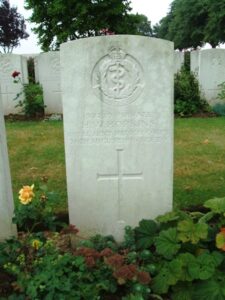
William Howarth, Private, 34696, Royal Fusiliers. William was born at Pembroke Dock, the son of Robert and Sarah J. Howarth. The family later resided at 55, Heidelburg Road, Portsmouth, where William worked as a Shipping Clerk. He enlisted at Crouch End, London into the 10th Battalion, Royal Fusiliers, which was attached to 111 Brigade, 37th Division, which moved to France in July 1915. They took part in the Attack on the Gommecourt Salient, during the first phase of the Battle of the Somme, and then fought at the Battle of the Ancre. They then moved to Arras in March 1917 and took part in the First Battle of the Scarpe, where they captured Monchy le Preux. They then took part in the Second Battle of the Scarpe, and the Battle of Arleux before moving north to Ypres. Here, they fought throughout Third Ypres, at the Battle of the Menin Road, the Battle of Polygon Wood, the Battle of Broodseinde, the Battle of Poelcapelle, the First Battle of Passchendaele and the Second Battle of Passchendaele. William was killed at Passchendaele on 29 September 1917. He was 27 years old, and is commemorated on the Tyne Cot Memorial, Belgium. William is not commemorated at Pembroke Dock.
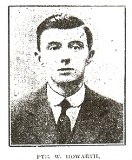
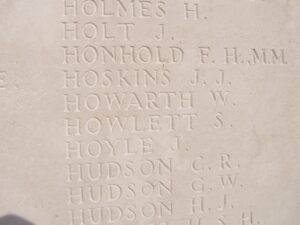
William John Howell, MM, Corporal, 461102, Royal Army Medical Corps. William was the son of William and Elizabeth Howell, of 28, Brewery Street, Pembroke Dock. His sister, Mary Ann Baines, lived at 30, Meyrick Street, Pembroke Dock. William had worked at H.M. Dockyard, Pembroke before the war, and enlisted at Portsmouth on 4 May 1909, into the 3rd Wessex Field Ambulance, Royal Army Medical Corps. At the outbreak of the Great War, William was posted to the 26th Field Ambulance, which embarked at Southampton on 5 November 1914 as part of the 8th Division. The Division saw its first major action at the Battle of Neuve Chapelle, and then at the Battle of Aubers. It then saw further fighting at the Action of Bois Grenier, and William gained a Mention in Despatches there, for his gallantry. The Division moved to the Somme in 1916, where it fought at the Battle of Albert. William gained further distinction on the Somme, being awarded the Military Medal. In March 1917 the Division followed the German Retreat to the Hindenburg Line, and later that year moved to Ypres, fighting at the Battle of Pilckem Ridge. William was killed in action here on 31 July 1917, aged 43. He has no known grave, and is commemorated on the Ypres (Menin Gate) Memorial, Belgium. William is not commemorated at Pembroke Dock.
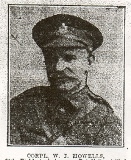
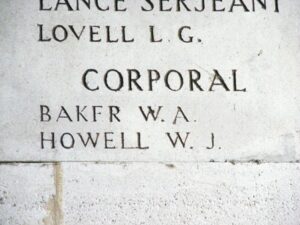
William Hughes, Company Sergeant Major, 15314, Welsh Regiment. William was the son of Thomas and Elizabeth Hughes, of Colwall, Hereford. He lived at Pembroke Dock with his wife Mary Helen Hughes prior to the war and enlisted at Cardiff into the army. He was posted to the 9th Battalion, Welsh Regiment, which was attached to 58 Brigade, 19th (Western) Division, and landed in France with the division in July 1915. William was killed in action during the divisions diversionary attack near Festuber, during the opening of the Battle of Loos on 25 September 1915. He was 46 years old and is buried in Brown’s Road Military Cemetery, Festubert, France. William is not commemorated at Pembroke Dock, although he is named on the County War Memorial.
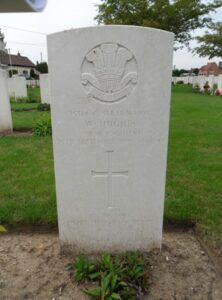
Robert Hutchison, Driver, 5521, Royal Field Artillery. Robert was the son of Serjeant Robert George Hutchison (R.F.A.) and Teresa Hutchison of Pembroke Dock, and he enlisted at Haverfordwest into the Royal Field Artillery, following in his fathers footsteps. After training, he was posted to B Battery, 86th Brigade, which was attached to the 19th (Western) Division. The Division crossed to France between 11 and 21 July 1915, and moved to positions near Loos, where it took part in the opening attack of the Battle of Loos on 25 September 1915. The following year the Division moved to the Somme, where it took part in the second wave of the attack on Ovillers-La Boiselle on 1 July, capturing the village at heavy cost. It then fought through the Somme Battles of Pozieres and the Ancre in 1916. Robert was wounded just before the Division moved to Flanders the following year. He died of his wounds on 3 May 1917, aged 25, and is buried at Duisans British Cemetery, Etrun, France, in Grave Ref. IV. B. 37. Robert is not commemorated at Pembroke Dock.
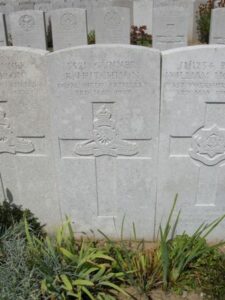
Alfred James Ireland, Lance Sergeant, 10755, Border Regiment. Alfred was born at Carlisle in 1886, the son of Francis and Margaret Ireland. He was a regular soldier, and was based at Pembroke Dock prior to the war, living with his wife Mary Ireland (nee Elliot) at 1, Carlton Place, Pembroke Dock. Upon the outbreak of war, he was serving with the 1st Battalion, Border Regiment, which had returned from India to become attached to 87 Brigade, 29th Division. The Division moved to Gallipoli via Egypt, landing on 25 April, 1915. They remained here until evacuation to Egypt on 11 January, 1916 and then moved to the Western Front on 15 March 1915, taking up positions near Beaumont Hamel. Alfred was wounded here during the build up to the Somme offensive. He died of his wounds on 17 June 1916, aged 29, and is buried at Beauval Communal Cemetery, France, in Grave Ref. B. 5. Alfred is not commemorated at Pembroke Dock.
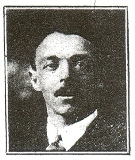
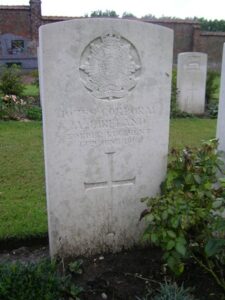
John James, Private, 19607, Welsh Regiment. John was born at Pembroke Dock, and enlisted at Barry into the 2nd Battalion, Welsh Regiment. The battalion was one of the first to move to France, as part of 3 Brigade, 1st Division, and took part in the Battle of Mons, and the retreat south to the Marne, where the German drive on Paris was halted. It then pushed the Germans back to the Aisne, where the 2nd Welsh fought a gallant action against the Germans, helping to bring their push to an end. The 1st Division then moved to Ypres, where it fought at First Ypres, again stopping the German attempt to break through to the Channel Ports. The following year saw them in action again at the Battle of Aubers, before moving South to Loos, where they fought during the Battle of Loos, which is where John was killed, during the initial assault of 25 September 1915. He has no known grave, and is commemorated on Panel 77/78 of the Loos Memorial, France. John is not commemorated at Pembroke Dock.
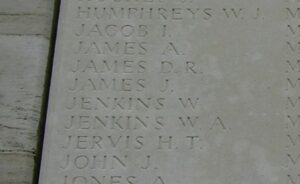
John James, MID, Sergeant, 17244, Royal Engineers. John was born at Pembroke Dock in 1890. He was a carpenter, and enlisted at Pembroke Dock into the Royal Engineers on 26 February 1908. John was based at Weymouth when war broke out, and had married Lauritina Whitehead whilst based in Ireland. John was posted to the 59th Field Company, Royal Engineers, which was attached to the 5th Division. The Division had landed at Havre on 15 August, 1914, and fought at the Battle of Mons, and during the retreat south, fighting at Le Cateau, then down to the Marne where the German attack was halted. They took part in the advance to the Aisne, before moving to Flanders, where they fought at the Battle of La Bassée, then at Messines in October, 1914. They fought here through First Ypres, and took part in the capture of Hill 60, and then fought at Second Ypres in April 1915. John was wounded at Second Ypres, and died of his wounds on 15 May 1915, aged 25. He is buried at Perth Cemetery (China Wall), Belgium, in Grave Ref. III. E. 7. John was Mentioned in Despatches twice during the war, on 17 February 1915 and on 22 June 1915. John is not commemorated at Pembroke Dock.
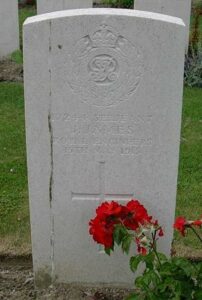
Sydney David James, Private, 66078, Cheshire Regiment. Sydney was born at Barry, the son of William and Lillian James. The family had moved to Pembroke Dock prior to the war, and resided at 59, Gwyther Street, Pembroke Dock, where Sydney began an apprenticeship as a motor cycle mechanic. Sydney enlisted at Pembroke on 2 November 1916 into the army, and was posted to France to join the 1/6th Battalion, Cheshire Regiment, which was attached to 118 Brigade, 39th Division. The Division had been in France since February 1916, and Sydney joined it on 21 January 1918, when it was stationed near St. Quentin, on the Somme. It was one of the Divisions to be hit hard here by the German Offensive which was launched on 21 March 1918. Sydney was killed on the first day of the German Offensive, on 21 March 1918. He was 19 years old, and was buried by the Germans at Heath Cemetery, Harbonnieres, France, where he still lies today. His parents retired to The Bungalow, Brynberian, Crymych after the war. Sydney is not commemorated at Pembroke Dock.
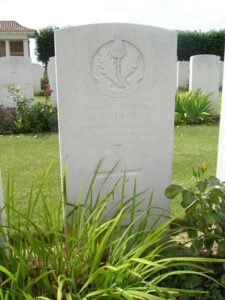
Albert Thomas Jenkins, MM., Private, 434911, Canadian Infantry. Albert was born on 18 December 1882 at Pembroke Dock, the son of Ephraim Thomas Jenkins and Sarah Jane Jenkins. The family later emigrated to Canada, and lived at Medicine Hat, which is where Albert enlisted into the 50th Battalion (Alberta), Canadian Expeditionary Force. The Battalion moved to France by April 1916, joining 10th Canadian Brigade, 4th Canadian Division, and saw action during the latter stages of the Somme Offensive, and at Vimy Ridge in spring 1917. During October 1917 the Battalion moved to Ypres, to take part in the Battle of Passchendaele, and on 22 October 1917 the Battalion moved into the front line at Levi Cottage, Zonnebeke, under a heavy artillery bombardment. Albert was killed during this move that day, aged 34. He is commemorated on Panels 24-30 of the Ypres (Menin Gate) Memorial, Belgium. Albert had won the Military Medal for Bravery in the Field during his time at war. Albert is not commemorated at Pembroke Dock.
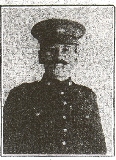
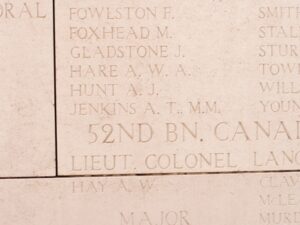
Alfred Jenkins, Deck Hand, 3709/DH, Royal Naval Reserve. Alfred was the son of William and Elizabeth Jenkins, of 4, Clayton Terrace, Mumbles, Swansea, and the husband of Ethel Mary Jenkins, of 22, King Street, Pembroke Dock. He served aboard HM Paddle Minesweeper Queen of the North, and was killed when she struck a mine on 20 July 1917. Alfred was 26 years old, and is buried at Noordwijk General Cemetery, Netherlands, in Grave Ref. C. 45. He was most probably washed ashore on the local beach. Alfred is not commemorated at Pembroke Dock.
William George Jenkins, Private, S4/058615, Royal Army Service Corps. William was the son of Ephraim Thomas Jenkins and Sarah Jane Jenkins, of 10, London Road, Pembroke Dock. He enlisted at Pembroke into the army, and joined the 2nd Company, Royal Army Service Corps, which was attached to the 32nd Divisional Train. At the end of December, 1915 the Division was in France, and the following year took part in the opening of the Somme Offensive, fighting at the Battle of Albert, the Battle of Bazentin, the Battle of the Ancre and the resulting Operations on the Ancre. They remained here over the winter, and in March 1917 followed the German Retreat to the Hindenburg Line. Their next major action was during the First Battle of Arras, after the Germans had launched their Spring Offensive on 21 March 1918. They then moved south, and took part in the Battle of Amiens later in the year. William was killed in action on 10 August 1918, two days into the Battle of Amiens. He was 30 years old, and is buried at Fouquescourt British Cemetery, France, in Grave Ref. III. I. 3. William is not commemorated at Pembroke Dock.

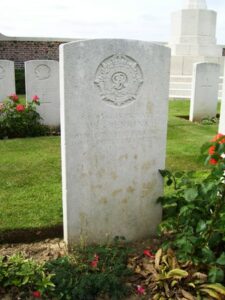
Herbert Stephen John, Shipwright, 343488, Royal Navy. Herbert was born on 1 October 1881, the son of William and Mary John, of 59, Military Road, Pennar. He was the husband of Lizzie (who later remarried, and became Lloyd), of 26, Owen Street, Pennar, Pembroke Dock. Herbert served in the Royal Navy, aboard HMS Black Prince, which was a Duke of Edinburgh Class cruiser. She served in the First Cruiser Squadron, and participated in the Pursuit of Goeben and Breslau. On 31 May 1916 she took part in the Battle of Jutland. Separated from the rest of the British fleet, the Black Prince approached the German lines at midnight. Realizing his error, Bonham ordered his crew to turn around, but it was too late. The German battleship Thüringen fixed the Black Prince in its spotlights and opened fire. Up to five other German ships, including battleships Nassau, Ostfriesland, and Friedrich der Grosse, joined in the bombardment. Most of the German ships were within close range of the Black Prince, and she was sunk within 15 minutes. Herbert was killed that night. He was 34 years old, and is commemorated on the Portsmouth Naval Memorial, Hampshire, on Panel 20. Herbert is not commemorated at Pembroke Dock.
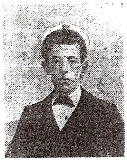
Thomas George John, Ordinary Seaman, Wales Z/4825, Royal Naval Volunteer Reserve. Thomas was born at Pembroke Dock on 2 March 1895, the son of John and Martha Davies. His parents had moved the family to 78, Thomas Street, Tonypandy prior to the war. Thomas had enlisted into the Royal Naval Volunteer Reserve and was posted aboard the Colossus-class dreadnaught battleship HMS Hercules. Hercules had taken part in the Battle of Jutland in 1916, and also participated in an action on 19 August 1916, before being reduced to patrolling in the North Sea, following the decision by the Germans not to risk putting their fleet to sea again. Thomas died of disease just weeks before the Armistice, on 17 October 1918, aged 23 and is buried in Trealaw Cemetery, Rhondda. He does not appear to be commemorated locally.
William Johns, Carpenter, Royal Navy. William was the son of George and Mary Johns, of Pembroke Dock. He was a long serving seaman, and married Alice Elizabeth Parker at Portsea whilst based there with the Royal Navy in 1896. The couple resided at 79, Oriel Road, North End, Portsmouth, where they raised two daughters. William served as Carpenter aboard HMS Cochrane, a Duke of Edinburgh Class armoured cruiser. She joined the Nore Division of the Home Fleet on 6 March 1907 and shortly afterwards was brought into to full commission for service with the 5th Cruiser Squadron. On 1 April 1909 she re-commissioned for service with the 2nd Cruiser Squadron, and participated in the Battle of Jutland on 31 May to 1 June 1916. William drowned accidentally while serving aboard Cochrane on 10 April 1917. He was 44 years old, and is commemorated on the Portsmouth Naval Memorial, Hampshire, on Panel 24. William is not commemorated at Pembroke Dock.
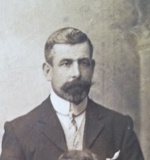
Thomas Johnson, Deck Hand, 694/DA, Royal Naval Reserve. Thomas was born at Pembroke Dock in 1866, the son of Lucy Johnson. He served during the war with the Royal Naval Reserve. After the armistice, Thomas was serving at HMS Victory. He died at Pembroke Dock on 10 March 1919, aged 52. He is buried at Pembroke Dock (Llanion) Cemetery, in Grave Ref. U. 198. Thomas is not commemorated at Pembroke Dock.
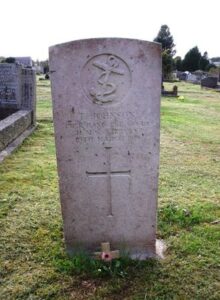
Frederick Gwyn Jones, Private, 23837, New Zealand Infantry. Frederick was the son of David and Jane Jones of 37 Park Street, Pembroke Dock. He had emigrated to New Zealand at some time between 1911 and 1914, and at the outbreak of war enlisted into the New Zealand Infantry, and embarked at Wellington on 27 May 1916 for England with the 13th Reinforcements for the 1st Battalion, Wellington Regiment, which was in France attached to the 1st Brigade, New Zealand Division. The division was on the Somme when Frederick arrived in France, and he would possibly have taken part in the Somme offensive. On the following year the New Zealanders moved to Ypres, and that is where Frederick was killed, on 3 October 1917, aged 29. He is commemorated on the Tyne Cot Memorial, Belgium. Frederick is commemorated at St. Andrew’s Church.
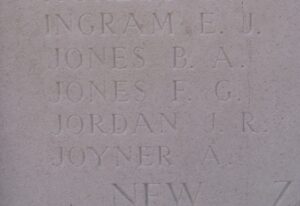
Frederick James Jones, Gunner, 371305, Royal Garrison Artillery. Frederick was the son of Evan and Sarah Jones, of Mead Lodge Farm, Pembroke Dock. He had served during the war with 238th Siege Battery, Royal Garrison Artillery, which had originally moved to France on 22 December 1916. At some time during the latter stages of the war, Frederick was incapacitated by gas, probably as a result of German gas shells. He returned home for treatment, but died of pneumonia as a result of his wounds on 27 December 1918. He was 21 years old, and is buried at Pembroke Dock (Llanion) Cemetery, in Grave Ref. P. 376. Frederick is commemorated at St. John’s Church.
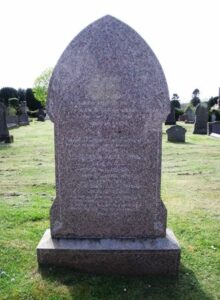
Gilbert Jones, Private, 40079, Welsh Regiment. Gilbert was born at Pembroke Dock in 1881, but resided at Nantymoel prior to the war with his wife Louie Jones and their five children. He enlisted at Bridgend into the 13th Battalion, Welsh Regiment, which was formed as a Rhondda Battalion in August 1914, forming part of 114 Brigade, 38th (Welsh) Division at Winchester the following year. In December 1915 the division landed in France, and fought on the Western Front from then on. At the end of August 1918 the division launched an offensive over the old Somme battlefields, and it was during this advance that Gilbert was wounded. He died of his wounds on 5 September 1918, aged 37, and is buried at Varennes Military Cemetery, France, in Grave Ref. III. K. 6. Gilbert is not commemorated at Pembroke Dock.
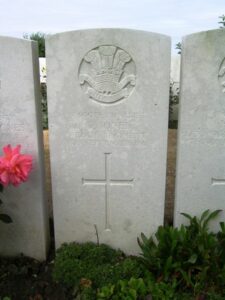
Gilbert John Jones, Private, 13788, Kings Shropshire Light Infantry. Gilbert was born at Neyland in 1891, the son of John and Elizabeth Jones. By 1911 the family was residing at 3, Upper Row, Golden Hill, Pembroke. He enlisted at Maesteg into the army and was posted to the 7th Battalion, King’s Shropshire Light Infantry, which was attached to 76 Brigade, 25th Division. The battalion moved to France on 28 September 1915, where it was transferred to the 3rd Division, which was at Ypres. In the summer of 1916 the Division moved to the Somme, and took part in the Battle of Albert, and at the Battle of Bazentin, where they captured Longueval. They then took part in the Battle of Delville Wood, and the Battle of the Ancre, before settling into another bleak winter in France. In May 1917 the Division were at Arras, and it was here that Gilbert was killed on 3 May 1917, aged 26. Gilbert has no known grave, and is commemorated on Bay 7 of the Arras Memorial, France. Gilbert is commemorated at St. John’s Church.
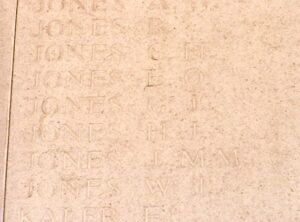
William Jones, Private, 7814, Welsh Regiment. William was born at Pembroke Dock, and enlisted at Swansea into the 2nd Battalion, Welsh Regiment. The battalion moved to France at the outbreak of war, attached to 3 Brigade, 1st Division. The Division had been one of the first to arrive in France, fighting at the Battle of Mons, and taking part in the retreat to the Marne, where the Germans were stopped. They then fought at the Aisne, and at Chivy, before being moved north to Ypres. Here they fought at the First Battle of Ypres, where they again stopped the German Offensive, before wintering in Flanders. The following year saw them in action again at the Battle of Aubers, and it was here that William was killed on 15 March 1915. He is buried at Chocques Military Cemetery, France, in Grave Ref. I. A. 49. William is not commemorated at Pembroke Dock.
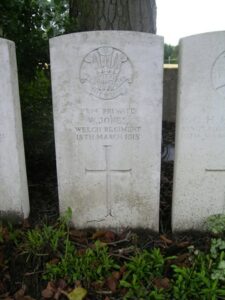
William Jones, Leading Seaman, 2306D, Royal Naval Reserve. William was born on 6 June 1879, the son of Arthur Jones, of Temple Bar, Park Street, Pembroke Dock. Prior to the war he resided with his wife, Martha Jones, at 30, Lewis Street, Pembroke Dock. William served aboard SS Kosseir, which was a requisitioned Mexican Steamship. William lost his life on 20 July 1918, while the ship was en-route from Alexandria to Port Said, carrying a general cargo. She was torpedoed and sunk by German submarine UB-51 with the loss of 39 of her crew, including the Master. William was 39 years old, and is commemorated on the Plymouth Naval Memorial, Devon, on Panel 29. William is commemorated at St. John’s Church.
Thomas Jordan, Private, 3/7853, Yorkshire Regiment. Thomas was the son of William and Catherine Jordan, of 1, Gravel Lane, Pembroke Dock. He was a boilermaker at Pembroke Dock prior to the war, and enlisted at Middlesbrough into the Yorkshire Regiment. Thomas was posted to their 2nd Battalion, which was attached to 21 Brigade, 7th Division. The Division landed at Zeebrugge on 6 October 1914, and fought on the Western Front for most of the war. During 1917 they suffered heavy casualties during the Third Battle of Ypres, and were sent to Italy after being withdrawn from the Salient. Thomas died just before this move, on 5 January 1918. He was 25 years old, and is buried at Railway Dugouts Burial Ground, Belgium. Thomas is not commemorated at Pembroke Dock.
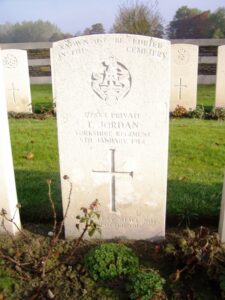
Matthew Kick, Sergeant, 7311, Kings Shropshire Light Infantry. Matthew was the son of Henry and Sarah Ann Kick, of Kingston, Surrey. He was a regular soldier, and resided with his wife, Matilda Jane Kick, at 15, Wellington Street, Pembroke Dock prior to the war. Matthew served with the 1st Battalion, King’s Shropshire Light Infantry, which was attached to 16 Brigade, 6th Division. On 10 September 1914 the Division landed at St Nazaire and proceeded to the Western Front, and arrived in time to reinforce the hard-pressed BEF on the Aisne, before the whole army was moved north into Flanders. Here they took part in the Action of Hooge during June, 1915. Matthew was wounded the following spring, and was evacuated to the Military Hospital at Le Touquet. He died of his wounds there on 10 March 1916, aged 39, and is buried at Le Touquet-Paris Plage Communal Cemetery, France, in Grave Ref. II. B. 5. Matthew is not commemorated at Pembroke Dock.
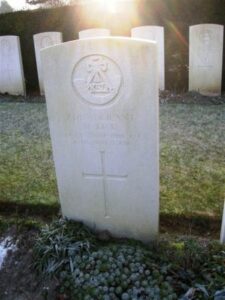
Alfred William Henry Knight, Private, 9204, Devonshire Regiment. Alfred was born at Pembroke Dock in 1896, the son of John and Emma Knight. The family later resided at 5, Hope Road, Heavitree, Exeter. Alfred enlisted at Exeter into the 1st Battalion, Dorsetshire Regiment, which was in Belfast at the outbreak of war, as part of 15 Brigade, 5th Division. The Division moved to France, and landed at Le Havre on 16 August 1914, and fought at the Battle of Mons, and during the retreat south, fighting at Le Cateau, then down to the Marne where the German attack was halted. They took part in the advance to the Aisne, before moving to Flanders, where they fought at the Battle of La Bassée, then at Messines in October, 1914. They fought here through First Ypres, and took part in the capture of Hill 60. On 31 December 1915 the 1st Dorsets transferred to 95 Brigade, 32nd Division, which had just arrived in France. The following year the Division took part in the opening of the Somme Offensive, fighting at the Battle of Albert, the Battle of Bazentin, the Battle of the Ancre and the resulting Operations on the Ancre. They remained here over the winter, and in March 1917 followed the German Retreat to the Hindenburg Line. Alfred was killed at Ypres later that year, on 4 October 1917, aged 21. He is buried at Voormezeele Enclosures, No. 1 & No. 2, Belgium, in Grave Ref. I. K. 29. Alfred is not commemorated at Pembroke Dock.
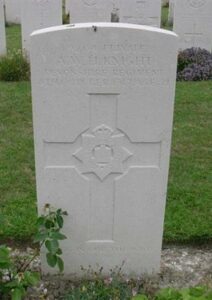
Harry Ernest Lambert, Warrant Wardmaster, Royal Navy. Harry was born at Winchester in 1870, the son of Robert and Sarah Jane Lambert. He resided with his wife Emily Lambert, at 33, Park Street, Pembroke Dock, where he served as Warrant Wardmaster at Pembroke Dock Royal Naval Hospital. Harry died after the end of the war, on 17 December 1919. He was 49 years old, and is buried at Pembroke Dock (Llanion) Cemetery, in grave ref. Q. 133. Harry is not commemorated at Pembroke Dock.
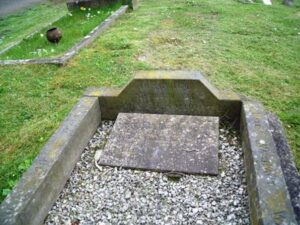
John Edward Leigh, Shipwright 1st Class, 343496, Royal Navy. John was born on 14 March 1896, the son of James and Harriett Ann Leigh, of 7, Gwyther Street, Pembroke Dock. He served aboard HMS Arabis, which was an Arabis Class Sloop. She was involved in a minesweeping exercise off the Dogger Bank during the night of 10/11 February 1916, when she was encountered by a flotilla of German destroyers. A brief action followed which led to the torpedoing and sinking of Arabis with the loss of 56 of her crew on the morning of 11 February 1916. John was among the dead. He was 29 years old, and is commemorated on Panel 17 of the Plymouth Naval Memorial, Devon. John is not commemorated at Pembroke Dock.
Robert Matthew Ingledew Leonard, Patternmaker, Royal Navy. Robert was born in Hakin in1862, the son of William and Catherine Leonard. He married in 1890, and resided with his wife Sarah J. Leonard, at 40, Laws Street, Pembroke Dock. Robert worked as a Patternmaker Chargehand at Pembroke Dockyard throughout the war, with the rank of Temporary Lieutenant-Commander. Robert died in France on 21 August 1918, aged 56, after many years service. Robert is not commemorated by the Commonwealth War Graves Commission, so the location of his burial is not known. Both of his sons served in the army during the Great War, Guion was an Officer in the Indian Army, and Harding served with the Royal Welsh Fusiliers, and was killed during an air raid on Portsmouth in 1941. Robert is commemorated at St. John’s Church.
Albert Victor Leverett, Sergeant, 12098, Machine Gun Corps. Albert was born at Pembroke Dock, the son of Captain Albert Leverett and Blanche Leverett. His parents had moved to 260, Sandycombe Road, Kew Gardens, Surrey during the war. Albert originally enlisted into the Army Service Corps, and served in France from 10 August 1914, before being transferred into the 99th Company, Machine Gun Corps, which was attached to 99 Brigade, 2nd Division. Albert was killed during the Battle of the Somme on 27 July 1916. He was 21 years old, and is commemorated on the Thiepval Memorial, France, on Pier and Face 5C/ 12C. Albert is not commemorated at Pembroke Dock.
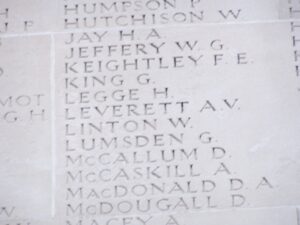
David James Lewis, Private, 5139, Welsh Regiment. David was the son of Thomas and Minnie Lewis, of 17, Waterloo Terrace, Pembroke Dock. He served in the local Territorial Battalion, the 1/4th Battalion, Welsh Regiment, which was attached to 159 Brigade, 53rd (Welsh) Division. The Division moved to the Mediterranean, sailing from Devonport in July 1915 arriving at Mudros by 5 August 1915. From here they moved to Gallipoli, landing on 9 August. Here the Division was immediately thrown into action, and spent the next few days in isolated pockets, fighting against a Turkish counter-attack during the Battle of Sari Bair, and then at the Attack on Scimitar Hill. David was killed here on 23 August 1915, aged 22. He is buried at Hill 10 Cemetery, Gallipoli, in Grave Ref. I. C. 13. David is not commemorated at Pembroke Dock.
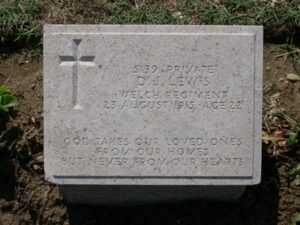
Frederick Charles Lewis, Private, 30763, Welsh Regiment. Frederick was born in 1897, the son of Walter Charles Lewis and Emily Lewis, of 37, Laws Street, Pembroke Dock. He enlisted at Pembroke into the Welsh Regiment, and was posted to France in 1915, joining the 2nd Battalion, Welsh Regiment, which was attached to 3 Brigade, 1st Division. The Division had been one of the first to arrive in France, fighting at the Battle of Mons. Frederick probably joined the battalion at Loos, prior to its move to the Somme in July 1916. The 2nd Welsh saw heavy fighting on the Somme, during the Battle of Bazentin, before taking part in the ensuing Battle of Pozieres. Frederick was badly wounded during fierce fighting at High Wood, and died on 10 September 1916, aged 19. He is buried at Millencourt Communal Cemetery Extension, France. His brother John Cecil Lewis also fell, whilst serving as John Williams! Frederick is not commemorated at Pembroke Dock.
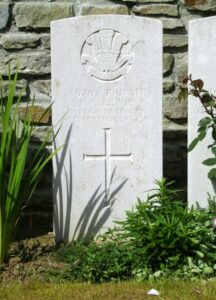
John Cecil Lewis, Private, 17261, Kings Shropshire Light Infantry. John was born at Pembroke Dock in 1885, the son of Walter Charles Lewis and Emily Lewis, of 37, Laws Street. He enlisted at Hereford into the 7th Battalion, King’s Shropshire Light Infantry under the name John Williams. The battalion was part of 76 Brigade, 25th Division, and landed in France during September 1915, before being transferred to the 3rd Division. The Division was at Ypres, and John saw action at Hooge with them, before they moved to the Somme, where they remained until May 1917. They then fought at the Battle of Arras, and later that year at Third Ypres. In November the Division moved south again, where they fought at the Battle of Cambrai, and they were in the area during March, 1918 when the German Spring Offensive swept through the British lines, at the Battle of St Quentin. John was wounded here, and evacuated to the Base Hospital at Etaples, where he died of his wounds on 31 March 1918. John is buried at Etaples Military Cemetery, France, in Grave Ref. XXXIII. B. 15. He is commemorated by the CWGC as John Williams. His brother Frederick Charles Lewis was killed with the 2nd Welsh. John is not commemorated at Pembroke Dock.
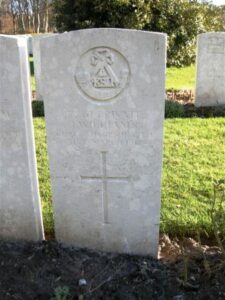
Thomas Lewis, Private, 7158, Welsh Regiment. Thomas was the son of James and Sophia Lewis, of 13, North Brewery Street, Pembroke Dock. He was an army reservist, and was recalled to the colours at the outbreak of war to serve with the 2nd Welsh, which went to France at the outbreak of war, attached to the 1st Division. The Battalion took part in heavy fighting during the retreat from Mons to the Marne, before moving to Ypres, where it was practically wiped out in its successful defence of the City. In 1915 2nd Welsh fought at Neuve Chapelle, and at sometime after, Thomas came back to Cardiff, where he joined the 3rd Welsh, possibly due to wounds. He died in Cardiff on 18 September 1915, aged 39, and is buried at Cardiff (Cathays) Cemetery. Thomas is not commemorated at Pembroke Dock.
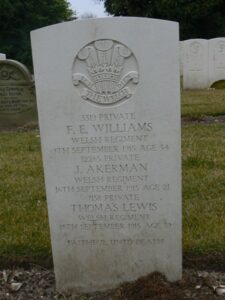
Alfred Edgar Leyshon, Quartermaster Sergeant, 4871, Welsh Regiment. Alfred was born at Pembroke Dock in 1877, the son of Alfred and Elizabeth Leyshon. He enlisted at Cardiff into the Welsh Regiment in December 1895, and served at India and South Africa with the 2nd Welsh before returning to Britain in 1909, where he married, and set up home with his wife Georgina Leyshon, at 4, Brithdir Street, Cathays, Cardiff. At the outbreak of the Great War Alfred was still with the 2nd Welsh, but didn’t embark for France with them in August 1914, but remained at the Depot at Cardiff until being posted to India in 1916. Alfred took ill in India, and in October 1917 was shipped home. He finally died on 25 December 1920, after a long spell of illness. He was 43 years old, and is buried at Cardiff (Cathays) Cemetery. Alfred is not commemorated at Pembroke Dock.
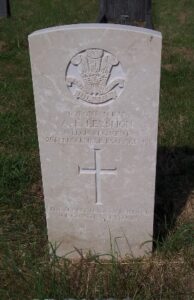
Arthur George Lifton, Private, 26830, Middlesex Regiment. Arthur was the son of John Joseph and Mary Elizabeth Lifton, of 105, High Street, Pembroke Dock. He enlisted at Fulham into the 4th Battalion, Middlesex Regiment, which was attached to 63 Brigade, 37th Division, which moved to France in July 1915. They took part in the Attack on the Gommecourt Salient during the first phase of the Battle of the Somme, and also fought at the Battle of the Ancre. They then moved in March 1917 and took part in the First Battle of the Scarpe, where they captured Monchy le Preux. They then took part in the Second Battle of the Scarpe, and the Battle of Arleux. Arthur was wounded here, and evacuated to the Base Hospital at Boulogne, but died of his wounds there on 6 May 1917. He was 35 years old, and is buried at Boulogne Eastern Cemetery, France, in Grave Ref. IV. B. 4. Arthur is not commemorated at Pembroke Dock.
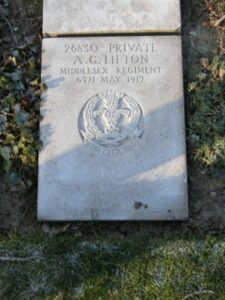
Albert Seymour Lloyd, MM, Gunner, 15757, Royal Field Artillery. Albert was the son of Alderman William George Lloyd and Margaret Anne Lloyd, of Britannia House, Corporation Terrace, Pembroke Dock. He was an Apprentice in HM Dockyard, Pembroke Dock, but enlisted at Pembroke into the Royal Field Artillery. Albert was posted to ‘C’ Battery, 78th Brigade, which was attached to the 17th (Northern) Division. Between 12 to 17 July 1915 the Division landed in France. They spent their initial period of trench familiarisation and then holding the front lines in the southern area of the Ypres salient. Here they took part in fighting at the Bluff during February, 1916 before moving south, where they fought at the Battle of Albert, where the Division captured Fricourt at heavy cost during the opening of the Somme Offensive. They then saw action during the Battle of Arras, at the First Battle of the Scarpe, and it was here that Albert was killed when a German shell crashed into his gunpit near Monchy on 19 April 1917. He was 23 years old, and is buried at Tilloy British Cemetery, Tilloy-Les-Mofflaines, France, in grave ref. I. E. 35. Albert had been awarded the Military Medal for bravery during the Battle of the Somme in 1916. Albert is commemorated at St. John’s Church, and at Bethany Chapel.
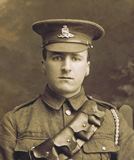
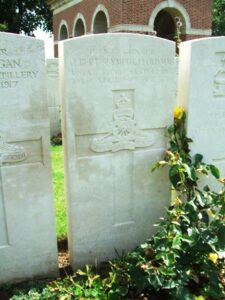
Henry Lloyd, MM, Corporal, T/069724, Royal Army Service Corps. Henry was the son of Henry Lloyd, of Owen Street, Pembroke Dock, and served with No. 3 Company, 38th Divisional Train, Royal Army Service Corps. Henry landed in France with the Division on 3 December 1915, and saw action at Mametz Wood the following year. In July 1916 the Welsh Division moved to Ypres, and in August 1917 took part in the Battle of Pilckem Ridge. Henry was awarded the Military Medal, for Bravery in the Field at Ypres, which was listed in the London Gazette of 25 September 1917. He survived the war, but died of influenza at the Hospital at Caudry, in Northern France on 25 November 1918, aged 26. Henry is buried at Caudry British Cemetery, France, in Grave Ref. II. B. 16. Henry is commemorated at St. John’s Church.
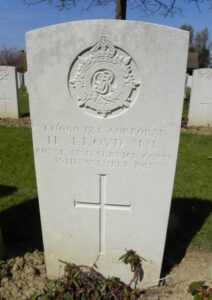
Thomas Lloyd, Private, 125, Welsh Regiment. Thomas was the son of Thomas and Maria Lloyd, of 41, Front Street, Pembroke Dock. He had been one of the early enlistees into the 1/4th Battalion, Welsh Regiment at the outbreak of war, so was probably a serving Territorial. The battalion was the local Territorial infantry unit, and formed for war at Carmarthen from 4 August 1914, attached to South Wales Brigade, Army Troops. During November 1914 it moved to Tunbridge Wells, and in February 1915 moved to Scotland on the Forth and Tay Defences. On 17 April 1915 the battalion joined 159 Brigade, 53rd (Welsh) Division, at Bedford, and on 19 July 1915 sailed from Devonport for Mudros, arriving on 5 August, before being transferred to Suvla Bay, Gallipoli on 9 August 1915. Immediately the 1/4th Welsh became embroiled in heavy fighting, against strongly defended Turkish trenches. Desperate fighting ensued over the coming weeks, which also saw terrible sickness raging through the men due to the amount of corpses littered over the battlefields. Thomas took ill on Gallipoli and was evacuated to a Hospital Ship moored offshore, but sadly he died on 18 September 1915, aged 25, and was buried at sea. Thomas is commemorated on the Helles Memorial, Gallipoli, Panel 140 to 144. Thomas is commemorated at St. John’s Church.
William Thomas Locke, Private, 58286, Kings Liverpool Regiment. William was born at Pembroke Dock, the son of Thomas and Annie Locke. He lived at Aylesford in Kent prior to the war, but enlisted at Carmarthen into the Army, joining the Cheshire Regiment. He was then transferred to the 5th Battalion, King’s Liverpool Regiment, which was attached to 165 Brigade, 55th (West Lancashire) Division. Little else is known of William, but he died at Oswestry Camp on 7 October 1918 aged just 18. William was buried in Aylesford (St. Peter) Churchyard. He is commemorated on a Special Memorial there. William is not commemorated at Pembroke Dock.
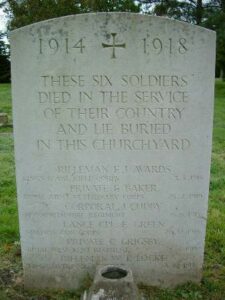
Robert Lowe, Private, 32952, King’s Liverpool Regiment. Robert was from Liverpool, but was posted to Pembroke Dock with the King’s Liverpool Regiment. He was posted to France with the 4th Battalion, King’s Liverpool Regiment, which was attached to 98 Brigade, 33rd Division. The Division moved to France during November 1915, and saw its first major action during the Battles of the Somme, from July 1916 onwards. Robert was killed in action on the Somme, on 29 August 1916. He has no known grave and is commemorated on the Thiepval Memorial, France. Robert is not commemorated locally.
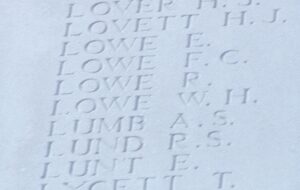
Owen Arthur Mitchell Magall, Private, 65327, Cheshire Regiment. Owen was born at Trincomalee, Ceylon on 2 August 1899, the son of James and Sarah Magall. He lived at Pembroke Dock before the war, before enlisting into the Army Service Corps in 1913, at the age of 14. When Owen reached the age of 18, he was posted to the 11th Battalion, Cheshire Regiment, which was in France attached to 75 Brigade, 25th Division. Owen joined the battalion at Ploegsteert on 3 April 1918, and was immediately thrown into terrible fighting, when the Germans launched their offensive on the Lys on 9 April. After a desperate spell of fighting, Owen was reported as missing in action. On 20 April 1918 the Red Cross reported him as being a Prisoner of War at Limburg Camp, in Germany. Owen died in Hospital in Worms on 5 November 1918. He was 19 years old, and is commemorated on the Screen Wall at Worms (Hochheim Hill) Cemetery, Germany. His personal possessions and medals were sent to his sister, Miss Ethel Magall, who was a Nurse at the 2nd London General Hospital, Chelsea. Owen is commemorated at St. John’s Church, and at St. Teilo’s.
Frank Manning, Lance Corporal, 13118, Welsh Regiment. Frank was the son of William John and Elizabeth Alice Manning, of 31, Church Street, Pembroke Dock. He enlisted at Carmarthen into the 9th Battalion, Welsh Regiment, which was attached to 58 Brigade, 19th (Western) Division. The Division crossed to France between 11 and 21 July 1915, and moved to positions near Loos, where it took part in the opening attack of the Battle of Loos on 25 September 1915. The following year the Division moved to the Somme, where it took part in the second wave of the attack on Ovillers-La Boiselle on 1 July, capturing the village at heavy cost. It then fought through the Somme Battles of Pozières and the Ancre in 1916. In 1917 the Division moved north to Ypres, taking part in the Battle of Messines, and it was here that Frank was killed on 7 June 1917. He was 20 years old, and is buried at Voormezeele Enclosure No. 3, Belgium, in Grave Ref. XVI. K. 3. Frank is commemorated at St. John’s Church.
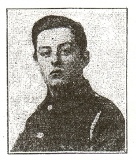
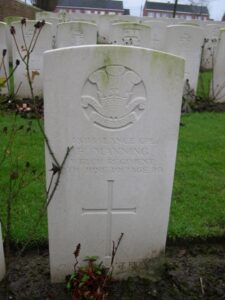
Frederick Mason, Private, 27782, Royal Warwickshire Regiment. Frederick was the son of William and Sarah Mason, of 30, Mountain Row, Ferndale, Glamorgan, and the husband of Lilian Mason, of 48, Laws Street, Pembroke Dock. He originally served with the King’s Shropshire Light Infantry, but transferred into the 11th Battalion, Royal Warwickshire Regiment, which was attached to 112 Brigade, 37th Division. Late in July 1915 the Division landed in France and saw its first action during the Attack on the Gommecourt Salient, during the first phase of the Battle of the Somme. It then fought at the Battle of the Ancre, and this is where Frederick was wounded. He died of his wounds at the Casualty Clearing Station at Contay on 21 November 1916, aged 22, and is buried at Contay British Cemetery, France, in Grave Ref. IV. E. 7. Frederick is not commemorated at Pembroke Dock.
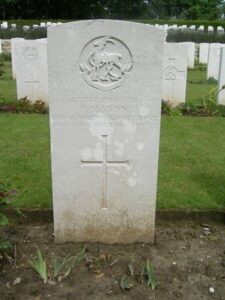
John Mason, Stoker 1st Class, 229299, Royal Navy. John was born on 6 April 1887, the son of James and Hannah Mason, of West Orielton. John married Beatrice Rowena Johns in 1913, and the couple resided with their two children at Waterloo, Pembroke Dock. John served aboard HMS Marmion, a Moon Class Destroyer, which was launched on 28 May 1915. On 21 October 1917, Marmion was involved in a collision with HMS Tirade, another Royal Naval destroyer, off Lerwick, Shetland Isles, and sank. John was one of several seamen to lose his life in the sinking. His body must have washed ashore at Norway, and John is one of several sailors from Marmion to be buried in Fredrikstad Military Cemetery, Norway. John is commemorated at St. John’s Church, and at St. Teilo’s.
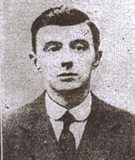
John Mathias, Sapper, 200280, Royal Engineers. John was the son of John and Jane Mathias, of Pembroke Dock. He was a carpenter prior to the war, and lived with his wife Frances Ann Mathias, at 47A, Bell Street, Trecynon, Aberdare. John enlisted at Aberdare in December 1915 into the Royal Engineers, and was posted to the Inland Water Transport, RE, moving to Egypt and Mesopotamia on 15 March 1917. John became ill and died in hospital at Basra on 11 July 1917. He was 38 years old, and is buried at Basra War Cemetery, Iraq, in Grave Ref. IV. J. 19. John is not commemorated at Pembroke Dock.
William John McCarthy, Stoker 1st Class, 309224, Royal Navy. William was born on 3 June 1887, the son of Daniel and Emily McCarthy, of 18, Charlton Place, Pembroke Dock, and served aboard HMS Goliath, a Canopus Class Battleship which had been placed in Reserve at Pembroke Dock in 1913. Goliath moved to the Mediterranean, where she supported the landings on the Gallipoli Peninsula on 25 April 1915 onwards. It was while stationed off Gallipoli that she was torpedoed and sunk by the Turkish torpedo boat Muavenet on 13 May 1915, with the loss of 570 of her crew. William was among the dead. He was 28 years old, and is commemorated on the Plymouth Naval Memorial, Devon, on Panel 6. William is commemorated at St. John’s Church.
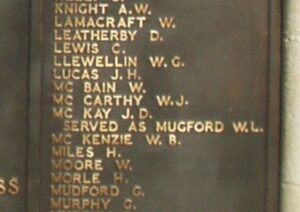
Thomas McCloghrie, Engine Room Artificer 5th Class, M/3263, Royal Navy. Thomas was born at Portsmouth on 30 September 1895, the son of George and Kate McCloghrie. The family was residing at 4, Gwyther Street, Pembroke Dock prior to the war. Thomas enlisted into the Royal Navy on 30 September 1913 and after training at Fisgard and Victory served aboard HMS Conquest, which was a C-class light cruiser, assigned to the 5th Light Cruiser Squadron, Harwich Force, guarding the eastern approaches to the English Channel. Thomas was one of eighteen men aboard a cutter from Conquest who died when she was caught in a freak snow squall in Harwich harbour on 28 March 1916. He was 20 years old, and is buried at Walton-On-The-Naze (Or Walton-Le-Soken) (All Saints) Churchyard Extension, England. Thomas is commemorated at St. John’s Church.
Henry McCormick, Driver, 14534, Royal Field Artillery. Henry was the son of Henry and Charlotte Ann McCormick, of 14, King Street, Pembroke Dock. He had enlisted at Pembroke into the Royal Field Artillery, and served on the Western Front with the 42nd Division Ammunition Column. The Division had fought at Gallipoli and Egypt before moving to the Western Front in February 1917, taking over the line near Epehy then Havrincourt. In September they moved north to Ypres, where they fought through Third Ypres, until moving to the Coast in September to refit. November 1917 saw them moving to positions at Givenchy, where they remained until moving back south in early 1918. Here they faced the German Spring Offensive of 21 March on the Somme, and fought in the Battle of Bapaume, and then at Arras. The offensive stalled for several months, until an Australian victory at Villers Brettoneux on 8 August saw the tide of war turn. The British attacked the German lines on the Somme on 21 August, with the 42nd Division in the line, and began the great offensive that was eventually to end the war. The Division fought at the Battle of Albert, then the Battle of Bapaume, and on to the Canal du Nord, and the pursuit to the Selle, where they saw out the end of the war. Henry died of influenza in France on 6 March 1919, aged 24. He is buried at Charleroi Communal Cemetery, Belgium, in grave ref. L. 7. His brother John had been killed in France in 1917. Henry is not commemorated at Pembroke Dock.
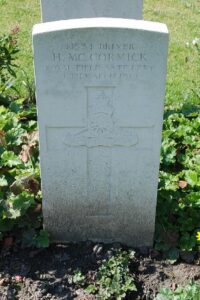
John McCormick, Gunner, 131054, Royal Garrison Artillery. John was the son of Henry and Charlotte Ann McCormick, of 14, King Street, Pembroke Dock. He enlisted at Pembroke into the Royal Garrison Artillery, and was posted to France with the 343rd Siege Battery, Royal Garrison Artillery. John was killed in action at Ypres on 29 December 1917, aged 19. He is buried in Belgian Battery Corner Cemetery, Belgium. His brother Henry died in France after the armistice. John is not commemorated at Pembroke Dock.
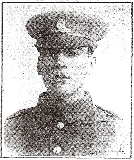
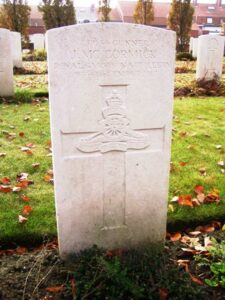
William Ernest Meyler, Sergeant, 24811, Lancashire Fusiliers. William was born at Pembroke Dock, the son of William and Ellen Meyler. He had married Annie Wright early in 1916, and the couple resided at the Hollies, Farington, near Preston. William enlisted at Preston into the North Lancashire Regiment, but transferred into the 10th Battalion, Lancashire Fusiliers, which was attached to 52 Brigade, 17th (Northern) Division. Between 12 to 17 July 1915 the Division landed in France. They spent their initial period of trench familiarisation and then holding the front lines in the southern area of the Ypres salient. Here they took part in fighting at the Bluff during February, 1916 before moving south, where they fought at the Battle of Albert, where the Division captured Fricourt at heavy cost during the opening of the Somme Offensive. William was wounded on the Somme, and died as a result on 3 February 1917. He was 30 years old, and is buried at Grove Town Cemetery, Meaulte, France, in Grave Ref. II. N. 19. William is not commemorated at Pembroke Dock.
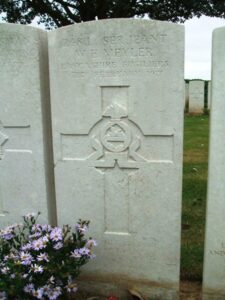
Rupert John Mills, Corporal, 61653, Welsh Regiment. John was the son of George Alfred and Elizabeth Mills, of 8, Military Road, Pennar. He was a baker prior to the war, and lived at Hafod, Swansea. John enlisted at Swansea on 25 January 1915 into the Army Service Corps, and served at home before being posted to the Middle East, where he served in Gallipoli and Egypt before being transferred into the 24th Battalion, Welsh Regiment, which was attached to 231 Brigade, 74th (Yeomanry) Division. The division embarked for France in May 1918, and took up positions in Northern France on the Lys. Rupert had a brief spell back at Swansea on leave in June 1918, and married Kitty Grealey, of 47, Vivian Street, Hafod, Swansea on 15 June 1918. He rejoined the 24th Welsh in France, and was killed while the battalion was holding the line in the St. Floris sector on 23 July 1918. He was 26 years old, and is buried at Merville Communal Cemetery Extension, France, in Grave Ref. III. E. 35. Rupert is not commemorated at Pembroke Dock.
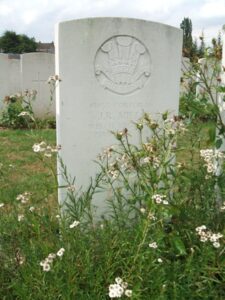
James Ernest Lillie Mitchell, Corporal, 93175, Royal Garrison Artillery. James was born at Dursley, in Gloucester, but lived at 19, Dimond Street, Pembroke Dock prior to the war, with his wife Mabel Bongye Mitchell (later of Crescent Villa, Fydell Crescent, Boston). James enlisted at Pembroke into the Royal Garrison Artillery on 9 December 1915, and was posted to the 203rd Siege Battery, Royal Garrison Artillery. The battery had formed at Pembroke Dock, and moved to France in July 1916. James was killed in action in France the following summer, on 20 June 1917. He was 34 years old, and is buried at Cite Bonjean Military Cemetery, Armentieres, France, in Grave Ref. VII. B. 23. James is not commemorated at Pembroke Dock.
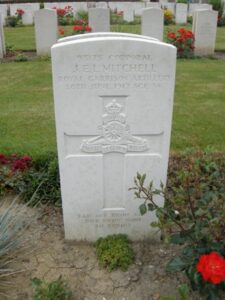
Albert John Moffat, Gunner, 46311, Royal Garrison Artillery. Albert was the son of Thomas and Elizabeth Moffatt, of 80, Laws Street, Pembroke Dock. A native of London, he enlisted at Westminster into the army, and was posted to the 30th Brigade, Royal Garrison Artillery. Albert was wounded when his billets were bombed by a German aircraft near Arras in the spring of 1918. He died of his wounds on 20 June 1918, aged 34, and is buried at Aubigny Communal Cemetery Extension, France, in Grave Ref. IV. L. 35. Albert is commemorated at St. John’s Church.
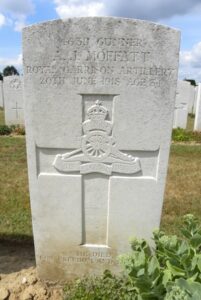
Charles Henry Morgan, MM, Sergeant, 9966, Border Regiment. Charles was born at Fareham, Hants. He was stationed at Pembroke Dock with the 2nd Battalion Border Regiment prior to the outbreak of war, and lived with his wife, Mrs. Morgan, at Owen Street, Pennar. On 5 September 1914, the battalion moved to Lyndhurst and became attached to 20 Brigade, 7th Division, and landed at Zeebrugge on 6 October 1914. The City was already falling however, and so the Division was moved to Ypres, where they became the first British Division to hold the city. They fought during the First Battle of Ypres, and in all of the major battles in Flanders thereafter, before moving to Vaux sur Somme in the summer of 1916. Here, the Division took part in the Battle of Albert, where it was tasked with the capture of Mametz Village. The 2nd Borders objective was Danube Support Trench, then Shrine Alley-Kiel Lane, and finally the third objective was Apple Alley. By 17.00 all of their objectives had been taken, one of the few successes of 1 July 1916, with the loss of 93 men killed and 246 men wounded. Charles was among the dead. He was awarded the Military Medal for gallantry, possibly for his actions on that day. It was listed in the London Gazette of 16 February 1917. Charles is buried at Dantzig Alley British Cemetery, Mametz, France. Charles is not commemorated at Pembroke Dock.
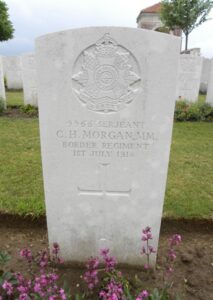
George Morgan, Able Seaman, 226369, Royal Navy. George was born at Pembroke Dock on 26 November 1886, the son of Charles Morgan, of 8, King Street, Pembroke Dock. He served in the Royal Navy, aboard HMS Challenger. Challenger had been launched in 1904, and was a protected cruiser. At the outbreak of war she joined the 9th Cruiser Squadron in the Mid Atlantic, and in September 1914 Captured the German steamer Ulla Boog. She then moved to West Africa, where she took part in the blockade of SMS Konigsberg. George died around this time, on 9 November 1914, aged 27. He was buried at sea, and so is commemorated on the Plymouth Naval Memorial, Devon, on Panel 2. George is not commemorated at Pembroke Dock.
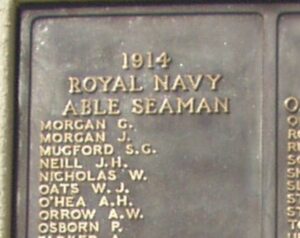
Sidney John Morris, Seventh Engineer, Mercantile Marine. Sidney was born at Pembroke Dock, the son of Thomas Sidney and Elizabeth Anne Morris, and was the husband of Annie Christine Morris (nee Edwards), of 30, Leinster Gardens, Runcorn, Cheshire. He served with the Mercantile Marine, aboard SS Haverford, a White Star Liner. She was requisitioned by the Admiralty at the outbreak of war, serving as a troop transport, and was torpedoed in the Atlantic by the German submarine U-38 on 26 June 1917, killing six of her crew, including Sidney. The ship survived the attack, and limped into port in Ireland, where Sidney was buried at Lower Fahan (Christ Church) Churchyard, in the South-East part. He was 28 years old. Sidney is not commemorated at Pembroke Dock.
Daniel Joseph Morrison, Shipwright 1st Class, 342391, Royal Navy. Daniel was born at Pembroke Dock on 2 February 1879, the son of John and Elizabeth Morrison. He enlisted into the Royal Navy prior to the war, and lived with his wife, Ethel Morrison, at 2A, Bridwell Road, Weston Mill Estate, Devonport. Daniel served aboard HMS Challenger towards the end of the war. She was a Protected Class Cruiser, which served in East African waters. Daniel took ill, and died on 16 December 1918. He was 39 years old, and is buried at Dar Es Salaam (Upanga Road) Cemetery, Tanzania. Daniel is not commemorated at Pembroke Dock.
Arthur Benjamin Stephen Mules, Carpenter, 344463, Royal Navy. Arthur was born at Pembroke Dock on 17 January 1887, the son of Frederick Edward Mules and Louisa Alice Mary Mules, of 19, Queen Street, Pembroke Dock. He served in the Royal Navy aboard the Canopus Class Battleship HMS Goliath, which had been placed in Reserve at Pembroke Dock in 1913. HMS Goliath moved to the Mediterranean, where she supported the landings on the Gallipoli Peninsula on 25 April 1915 onwards. It was while stationed off Gallipoli that she was torpedoed and sunk by the Turkish torpedo boat Muavenet on 13 May 1915, with the loss of 570 of her crew. Arthur was among the dead, and is commemorated on Panel 9 of the Chatham Naval Memorial, Kent. Arthur is commemorated at St. John’s Church.
Ernest Norris, Lance Sergeant, 7182, Duke of Edinburgh’s Wiltshire Regiment. Ernest was born at Mere, Wiltshire on 8 March 1887, the son of James and Mary Ann Norris. He resided at Pembroke Dock at the outbreak of war, where he served with the 1st Battalion, Wiltshire Regiment. Ernest married Mary Ellen Furlong at Pembroke Dock whilst on leave in June 1915. He then returned to France attached to the 6th Battalion, Wiltshire Regiment, which was attached to 58 Brigade, 19th (Western) Division. The Division crossed to France between 11 and 21 July 1915, and moved to positions near Loos, where it took part in the opening attack of the Battle of Loos on 25 September 1915. The following year the Division moved to the Somme, where it took part in the second wave of the attack on Ovillers-La Boiselle on 1 July, capturing the village at heavy cost. It then fought through the Somme Battles of Pozieres and the Ancre in 1916. In 1917 the Division moved north to Ypres, taking part in the Battle of Messines, and fought on the Menin Road and at Polygon Wood. Ernest was killed here on 20 September 1917, aged 30. Ernest is commemorated on Panels 119/120 of the Tyne Cot Memorial, Belgium. Ernest is commemorated at St. John’s Church, and at St. Teilo’s.
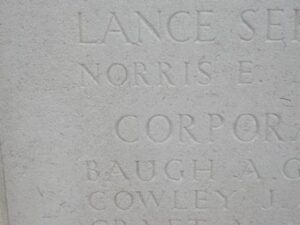
Bert Novis, MM, Private, 41349, Worcestershire Regiment. Bert was born at Peckham, London, in 1891, the son of Harry and Margaret Novis. Bert resided at Pembroke Dock at the outbreak of war, and married Elsa Winifred Graham at Pembroke Dock in 1916. He served with the 1/7th Battalion, Worcestershire Regiment, which was attached to 144 Brigade, 48th Division. The Division moved to France between 22 March and 1 April 1915, and saw its first major engagement at the opening of the Battle of the Somme. They then went into action at the Battle of Bazentin, during the second phase of the Battle of the Somme, and captured Ovillers. They also fought at the Battle of Pozières and the Battle of the Ancre. In March 1917 they followed the German Retreat to the Hindenburg Line, and later in the year fought at Third Ypres, at the Battle of Langemarck and at Polygon Wood. Bert was killed here on 26 August 1917. He was posthumously awarded the Military Medal, in the London Gazette of 30 October 1917, aged 25. He is commemorated on Panel 75-77 of the Tyne Cot Memorial, Belgium. Bert is not commemorated at Pembroke Dock.
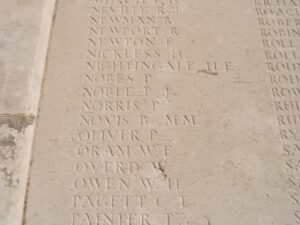
Alfred Thomas Owen, Stoker 1st Class, 310628, Royal Navy. Alfred was born on 16 February 1888, the son of Thomas Owen, of Pembroke Dock, and was the husband of Sarah Frances Clarke (formerly Owen), of 16, Rant Score, Beach, Lowestoft. He served aboard the Battlecruiser HMS Indefatigable, which was part of the 2nd Battlecruiser Squadron. Indefatigable took part in the Battle of Jutland on 31 May 1916, but was to become the first major casualty of the action, when she was hit by 11 inch shells from the SMS Von der Tann, blowing out her bottom and causing her to fall out of formation, sinking by the stern. Following more hits, the forward magazine exploded, and the ship sank quickly, killing all but three of her crew of 1,017. Alfred was 30 years old, and is commemorated on Panel 16 of the Plymouth Naval Memorial, Devon. Alfred is not commemorated at Pembroke Dock.
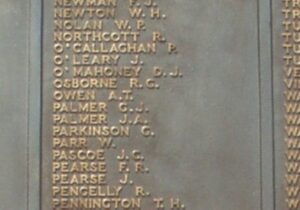
Frederick James Owens, Gunner, 79409, Royal Garrison Artillery. Frederick was born at Pembroke Dock, the son of Thomas James and Mary Amelia Owens, of 36 Prospect Place, Pembroke Dock. He enlisted at Pembroke Dock on 15 April 1916 into the Royal Garrison Artillery, joining the 250th Siege Battery in France on 31 December 1916. Frederick was killed in action during the Battle of Arras on 22 April 1917, aged 38. He is buried at Hervin Farm British Cemetery, St. Laurent-Blangy, France, in Grave Ref. B. 5. Frederick is not commemorated at Pembroke Dock.
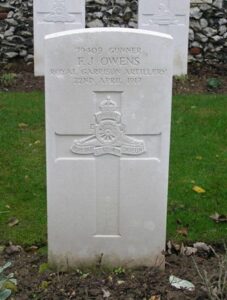
Thomas Leonard Owen Page, Able Seaman, J/11990, Royal Navy. Thomas was born on 22 October 1894, the son of John and Mary Page. The family was originally from Pembroke Dock, but by 1911 had moved to 41, Tangier Road, Copnor, Portsmouth. Thomas served aboard HMS Fortune, which was an Acasta Class Destroyer, serving with the Grand Fleet. Fortune took part in the Battle of Jutland on 31 May 1916, and during the night of the battle she came under heavy fire from German battleships, including SMS Westfalen. Hits from the secondary armament of Westfalen caused overwhelming damage and she went down on fire with 67 men on the morning of 1 June 1916. Thomas was 21 years old, and his body was washed ashore in Sweden some time after. He is buried at Kviberg Cemetery, Sweden, in Grave Ref. 1. C. 2. Thomas is not commemorated at Pembroke Dock.
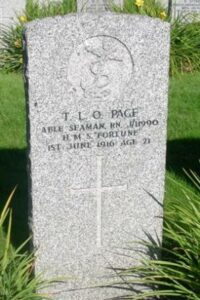
Charles Lionel Palmer, Private, 10578, Welsh Regiment. Charles was the son of Mrs. Nora Cass, of 5, Prince’s Street, Pembroke Dock. His father Charles had been killed at Ladysmith during the Boer War, on 24 February 1900, while serving with the Devonshire Regiment. Charles enlisted as a Boy Soldier at Pembroke Dock around 1912, at the age of 14. He served with the 1st Battalion, Welsh Regiment, which was attached to 84 Brigade, 28th Division. The Division landed at Le Havre on 18 January 1915, and fought on the Western Front until embarking at Marseilles for Egypt and eventually Salonika on 24 November 1915. It remained in Salonika for the remainder of the war. Charles took ill and died of pneumonia on 8 October 1918. He was 21 years old, and is buried at Mikra British Cemetery, Kalamaria. Charles is not commemorated at Pembroke Dock.
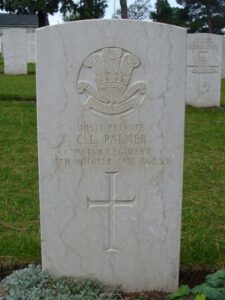
Edward John Parkman, MM, Corporal, 14106, Royal Garrison Artillery. Edward was the son of Joseph William and Jane Parkman, of 6 Bassett Street, Coedpenmaen, Pontypridd. He had worked as a collier prior to enlisting at Pontypridd into the Glamorgan Battery, Royal Garrison Artillery on 6 January 1903, and by the time of the war was based at Pembroke Dock. Edward was posted to France with the 56th Siege Battery, Royal Garrison Artillery in 1916. Edward served in France for two years, before dying on 23 May 1918, aged 34. He is buried in Doullens Communal Cemetery Extension, No. 2, France. Edward is not commemorated locally.
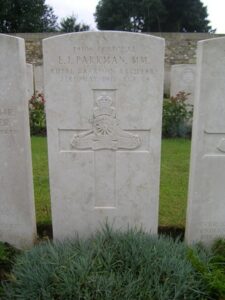
Edgar Ernest Parrington, MID, Sergeant, S/5175, Army Ordnance Corps. Edgar was the son of William and Susan Parrington, of 50, Seymour Road, Harringay, London. He enlisted into the Army Ordnance Corps on 22 September 1902, and after four years on home service, served in Egypt for six years. On 19 April 1912 Edgar returned to Britain, and was posted to Pembroke Dock, living with his wife Maud Parrington, at 2, London Road, Pembroke Dock. He had served in France for two years, but returned to Britain to serve as an Instructor with the Army Ordnance Corps Depot. Edgar died of phthisis on 5 December 1918. He was 39 years old, and is buried at Newport (Christchurch) Cemetery, Gwent, in Grave Ref. 1859. Ernest is commemorated at St. John’s Church.
Francis William John Patterson, Artificer Engineer, Royal Navy. Francis was born at Newcastle in 1879, and had served in the Royal Navy for several years prior to the war, mainly at Pembroke Dock. On 22 January 1916 Francis was posted aboard the Invincible Class Battlecruiser H.M.S. Indomitable. She had an interesting war, taking part in the Battle of Dogger Bank and the Battle of Jutland, and in 1919 was part of the Nore Reserve at Pembroke Dock. Francis had been awarded the French Medaille Militaire for his good work during the Battle of Jutland. He was one of five men who drowned when a boat from the R.F.A. Francol capsized at Pembroke Dock on 27 December 1919, because of an incident when Francis was attacked by another sailor. His body was washed ashore on 20 January 1920 and he was buried at Pembroke Dock (Llanion) Cemetery, in Grave Ref. V. 33. He was 41 years old and is not commemorated locally.
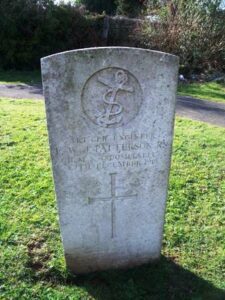
Albert Walter Payne, Private, 38489, Welsh Regiment. Albert was born at Pembroke Dock in 1894, the son of Edward and Mary Payne. He enlisted at Cardiff into Welsh Regiment and was posted to France on 16 December 1915, joining the 2nd Battalion, Welsh Regiment, which was attached to 3 Brigade, 1st Division. The 2nd Welsh had been one of the first to arrive in France, fighting at the Battle of Mons, and taking part in the retreat to the Marne, where the Germans were stopped. They then fought at the Aisne, and at Chivy, before being moved north to Ypres. Here they fought at the First Battle of Ypres, where they again stopped the German Offensive, before wintering in Flanders. The following year saw them in action again at the Battle of Aubers, before moving South to Loos, where they fought during the Battle of Loos, and the action at the Hohenzollern redoubt. Albert joined the battalion at Loos, and moved with it to the Somme in July 1916. Albert was wounded at some time during the Battle of Flers and was evacuated to the Base Hospital at Rouen, but died there on 17 September 1916, aged 22. He is buried at St. Sever Cemetery, Rouen, France, in Grave Ref. B. 22. 74. Albert is not commemorated at Pembroke Dock.

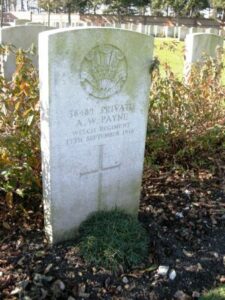
William James Pearce, Sergeant, 7727, Duke of Edinburghs Wiltshire Regiment. William was born at Pewsey, Wiltshire, but lived at Pembroke Dock at the outbreak of war. He served with the 2nd Battalion, Wiltshire Regiment, which was attached to 21 Brigade, 7th Division. The Division was formed during September, 1914 and landed at Zeebrugge on 6 October 1914. The City was already falling however, and so the Division was moved to Ypres, where they became the first British Division to hold the city. They fought during the First Battle of Ypres, and helped stop the German advance through Belgium. William was killed here on 4 November 1914. He is buried at Tyne Cot Cemetery, Belgium, in Grave Ref. LXI. J. 3. William is not commemorated at Pembroke Dock.
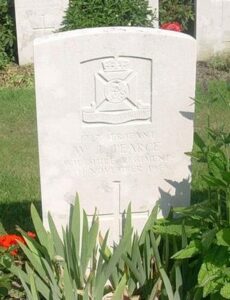
Ewart Walter Lewis Phelps, Fitter, Royal Navy. Ewart was born on 21 January 1890, the son of George and Sarah Ann Phelps, of 5, Belle Vue Terrace, Pembroke Dock. He served as a Fitter at HM Dockyard Malta, and was killed aboard the Armed Boarding Steamer HMS Louvain, when she was sunk by the German submarine, UC-22 on 20 January 1918. Ewart was 28 years old, and is commemorated on the Plymouth Naval Memorial, Devon, on Panel 31. Ewart is commemorated at St. John’s Church, and at St. Teilo’s.
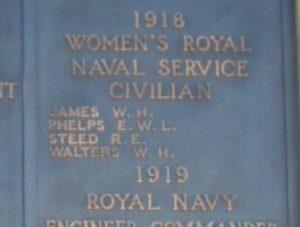
John Patrick Joseph Phillips, Private, 6953, Royal Irish Regiment. John was born in Ireland on 27 May 1899, the son of Alfred Thomas and Esther Elizabeth Phillips. By 1901 the family had moved to 43, High Street, Pembroke Dock. John enlisted at Cardiff into the Army, and was posted to the 7th Battalion, Royal Irish Regiment, which was attached to 21 Brigade, 30th Division. The Division moved to France in November 1915, and had fought on the Somme in 1916, and at the Battle of Arras the following year, before moving to Ypres, and fought at the Battle of Pilckem. After seeing much heavy fighting throughout 1918, the 30th Division took part in the Advance in Flanders towards the end of the war, and it was here that John was killed during the capture of Wulverghem on 2 September 1918. He was just 19 years old, and is buried at Dranoutre Military Cemetery, Belgium, in Grave Ref. III. A. 26. John is commemorated at St. John’s Church.
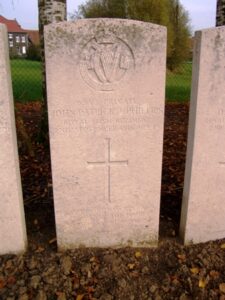
Sidney Picton, Private, 235511, Royal Welsh Fusiliers. Sidney was born at Pembroke Dock in 1887, the son of George and Elizabeth Picton. He married Annie Griffiths of 10, Picton Place, Pembroke Dock on 7 November 1915. Sidney was a Postman prior to the war, and enlisted at Pembroke on 29 November 1915 into the 7th (Cyclist) Battalion, Welsh Regiment. Sidney served in France from 27 July 1917 until being wounded by gunshot on 7 November 1917, and returned home to recuperate. On 22 March 1918 he landed back in France, and was posted to the 9th Battalion, Royal Welsh Fusiliers, which were attached to 58 Brigade, 19th (Western) Division. The Division had been in France since July 1915, and had fought at Loos, the Somme, and at Messines and Passchendaele. In the Spring of 1918 they were in the Ploegsteert Sector when they were hit by the German Spring Offensive, losing many men over the coming days. Sidney was killed here on 18 April 1918, aged 31. He has no known grave, and is commemorated on the Tyne Cot Memorial, Belgium, on Panel 63-65. Sidney is commemorated at Bethany Chapel, Pembroke Dock.
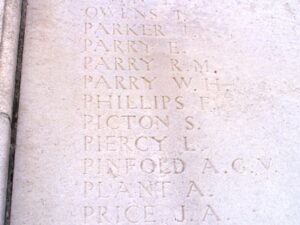
William Arthur Picton, Sergeant, 200110, Welsh Regiment. William was the son of William and Ruth Picton, of 12, King Street, Pembroke Dock. He served with the local Territorial Battalion, the 1/4th Battalion, Welsh Regiment. The battalion were attached to 159 Brigade, 53rd (Welsh) Division, and moved to the Mediterranean, sailing from Devonport in July 1915, and arriving at Mudros by 5 August 1915. From here they moved to Gallipoli, landing on 9 August. Here the Division was immediately thrown into action, and spent the next few days in isolated pockets, fighting against a Turkish counter-attack during the Battle of Sari Bair, and then at the Attack on Scimitar Hill. The Division remained here throughout the coming months, and suffered severe losses in manpower strength during the great November 1915 blizzard on Gallipoli, when its total strength was reduced to less than that of a full-strength Brigade. On 11 December 1915 the Division was evacuated to Mudros, and by 23 December 1915 were moved to Egypt. They remained on the Suez Canal Defences for the next twelve months, and in early 1917 moved into Palestine, where they took part in the First Battle of Gaza. William was killed there on 26 March 1917, aged 20. He has no known grave, and is commemorated on Panels 30-32 of the Jerusalem Memorial, Israel. William is commemorated at St. John’s Church.
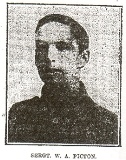
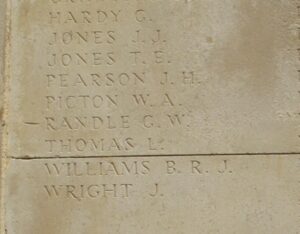
William Richard Picton, Deck Hand, 14850DA, Royal Naval Reserve. William was born on 23 July 1889, the son of Richard William Picton. Prior to the war he resided with his wife, Florence Mary Picton, at 14, Clarence Street, Pembroke Dock. He served in the Royal Naval Reserve aboard HM Drifter Active III, and was killed when she struck a mine off Milford Haven on 15 October 1917. William was 28 years old, and is commemorated on Panel 24 of the Portsmouth Naval Memorial, Hampshire. William is not commemorated at Pembroke Dock.
Bertram Theodore Pinnegar, Sergeant, 11001, Royal Engineers. Bertram was born at Warwick in 1881, the son of Edward William and Hester Pinnegar. He was a regular soldier, and had been based at Pembroke Dock prior to the war, marrying Beatrice Mary Phoebe Davies there in 1914. At the outbreak of war Bertram was posted to the 7th Field Company, Royal Engineers, which was attached to the 50th (Northumbrian) Division. The Division had fought at the Second Battle of Ypres from April to June 1915, and on the Somme the following year. After spending a winter on the Somme, they took part in the Arras Offensive, before being sent north again to Ypres, where they fought at the Second Battle of Passchendaele. During March 1918 they were stationed near St. Quentin, and were hit here by the German Spring Offensive, and took part in a gallant rearguard action during the Actions at the Somme Crossings, and then at the Battle of Rosieres. After suffering terrible casualties, the Division moved north to Flanders to rest and rebuild, but in April the Germans launched an attack in Flanders, around the Lys, and the Division took part in the Battle of Estaires, and the Battle of Hazebrouck. Following a most trying time on the Somme and Lys battlefields, the Division was withdrawn and sent to IX Corps, then on the Aisne, believed to be a much quieter area. This was unfortunately not the case, as the Division was hit hard by a surprise enemy attack, and fought at the Battle of the Aisne, 1918. Bertram was killed on the Aisne on 27 May 1918, aged 36. He has no known grave, and is commemorated on the Soissons Memorial, France. Bertram is commemorated at St. John’s Church.
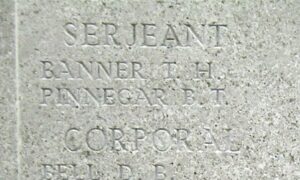
Stephen Potter, Bombardier, 22006, Royal Garrison Artillery. Stephen was the son of William and Phoebe Potter, of Shoeburyness. He married Annie Blake, of 98, Laws Street, Pembroke Dock in 1917 after meeting her while stationed at the Defensible Barracks, with 57 Company, Royal Garrison Artillery. He was posted to France to join the 1st/2nd Lancs Heavy Battery, Royal Garrison Artillery in 1916. Stephen was killed by a shell fragment while his battery was bombarding the German trenches at Ypres on 19 August 1917. He was 32 years old and is buried in Bard Cottage Cemetery, Belgium. Stephen does not appear to be commemorated locally.
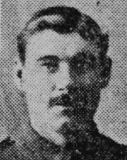
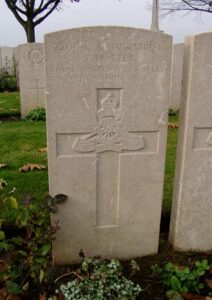
Harold Joseph Preen, Lance Corporal, 1824, Welsh Guards. Harold was born at Pembroke Dock in 1896, the son of Charles and Mary Preen. The family resided at Trowbridge, Wiltshire prior to the war, and Harold enlisted at Mountain Ash into the Welsh Guards. The Welsh Guards had been formed by Royal Warrant early in 1915, and moved to France where it joined 3rd Guards Brigade, Guards Division. The Welsh Guards then fought at the Battle of Loos in September 1915, and the following year fought on the Somme. In 1917 they took part in the Battle of Third Ypres, before moving to Cambrai later that year. They remained in the area over the final winter of the war, and were stationed near Gouzeaucourt when the German Spring Offensive hit the area on 21 March, 1918, at the Battle of St Quentin. The British retreated in the face of this onslaught, fighting at the First Battle of Bapaume, before the Guards Division retreated west and faced the Germans at the First Battle of Arras, 1918. Harold was killed in the ensuing lull in the offensive, on 23 July 1918, aged 19. He is buried at Berles New Military Cemetery, France, in Grave Ref. II. D. 5. Harold is not commemorated at Pembroke Dock.
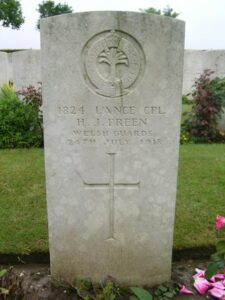
Harry Pugh, Private, 7698, Kings Shropshire Light Infantry. Harry was born at Cleobury Mortimer, Shropshire. He was stationed at Pembroke Dock before the war with the King’s Shropshire Light Infantry, and was the Husband of M. Pugh, of Cranfield House, Beverley Street, Port Talbot. Harry served with the 1/4th Battalion, King’s Shropshire Light Infantry, which had been on Garrison duties at Singapore and Hong Kong for the first two years of the war. On 27 July 1917 the battalion landed at Le Havre, and joined 190 Brigade, 63rd (Royal Naval) Division. The Division then moved to Ypres, and took part in the Battle of Passchendaele. On 4 February 1918 the 1/4th KSLI transferred to 56 Brigade, 19th (Western) Division, and were caught up in the German Spring Offensive near St. Quentin, where they suffered terrible casualties during the Battle of Bapaume. They moved to Ypres, but were caught up in the German attack at Messines. Harry was wounded at Messines, and died at the Casualty Clearing Station at Haringhe on 18 April 1918. He was 42 years old, and is buried at Haringhe (Bandaghem) Military Cemetery, Belgium, in Grave Ref. II. F. 24. Harry is commemorated at St. John’s Church.
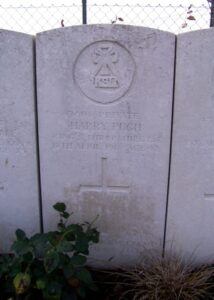
Richard Rees, Sapper, 62617, Royal Engineers. Richard was born at Pembroke Dock, but resided at Pen-y-Graig, Glamorgan prior to the war. He enlisted at Tonypandy into the 151st Field Company, Royal Engineers, which was attached to the 38th (Welsh) Division. Richard landed in France with the Division in December 1915, where they took the line at Fleurbaix. They remained here until the middle of June 1916, before moving to the Somme. Richard was killed in Flanders on 1 June 1916, before the move south. He is buried at La Gorgue Communal Cemetery, France, in Grave Ref. II. B. 14. Richard is not commemorated at Pembroke Dock.
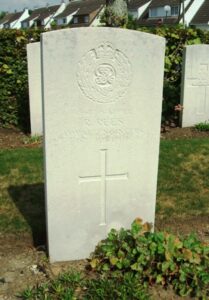
Robert Charles Revell, Leading Seaman, 110199, Royal Navy. Robert was born at Hull on 25 December 1863, the son of Henry Kirk Revell. The family later moved to Bristol, but Robert worked at Pembroke Dock, living with his wife Mary Jane Revell, at Fern Cottage, Pennar, Pembroke Dock. Robert served with the Royal Navy aboard HMS Viknor. The Viknor was assigned to the 10th cruiser squadron and was used to patrol the waters between Scotland and Iceland. On 13 January 1915, she disappeared off Tory Island, Ireland, with the loss of all her crew. Robert was 52 years old, and is commemorated on the Portsmouth Naval Memorial, Hampshire, on Panel 7. Robert is not commemorated at Pembroke Dock.
Frank Ribbon, Private, 15081, South Wales Borderers. Frank was the son of William Henry Ribbon (Professor of Music) and Agnes Maria Ribbon, of Pembroke Dock. He had originally enlisted at Pembroke into Pembrokeshire Battery, Royal Garrison Artillery on 21 February 1893, and had served with the battery for several years. At the outbreak of war he re-enlisted into the 1st Battalion, South Wales Borderers, which was attached to 3 Brigade, 1st Division. The Division had been one of the first to arrive in France, fighting at the Battle of Mons, and taking part in the retreat to the Marne, where the Germans were stopped. They then fought at the Aisne, and at Chivy, before being moved North to Ypres. Here they fought at the First Battle of Ypres, where they again stopped the German Offensive, before wintering in Flanders. Frank was killed during the first winter of the war, on 14 January 1915. He was 38 years old, and is buried at Woburn Abbey Cemetery, Cuinchy, France, in Grave Ref. II. A. 4. Frank is not commemorated at Pembroke Dock.
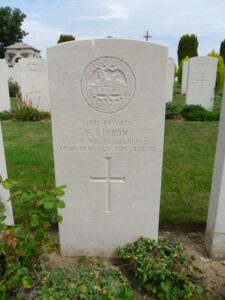
William Ernest Richards, Conductor, 4316, Indian Ordnance Department. William was born at Pembroke Dock, the son of John Peter Richards and Henrietta L. Richards. The family later moved to 9, Castilion Terrace, Northampton, where Ernest lived with his wife Sophia Richards. He served with the Indian Ordnance Department, Indian Army. William died during the end of the campaign in Mesopotamia on 14 September 1918. He was 46 years old, and is buried at Baghdad (North Gate) War Cemetery, Iraq, in Grave Ref. III. F. 11. William is not commemorated at Pembroke Dock.
William John Richards, Petty Officer, 184496, Royal Navy. William was born on 18 February 1880, the son of William and Emily Richards, of Tenby. He was a pre-war regular with the Royal Navy, and resided with his wife Elizabeth Gertrude Richards, at 18, North Street, Bufferland, Pembroke Dock. William served in the Royal Navy, aboard HMS Goliath, which was a Canopus class battleship. She was launched on 23 March 1898 and commissioned at Chatham on 27 March 1900. Designed for the China station, she had a narrow draught, to enable her to use the Suez Canal. She remained there until 1903, and in 1904 went into commissioned reserve at Portsmouth. In May 1905 she joined the Mediterranean fleet, transferring to the channel fleet in December and remaining there until March 1907. She was then commissioned in April 1909 at Sheerness for the 4th Fleet (Nore Reserve). HMS Goliath was mothballed in 1913, and joined the 3rd Fleet (Pembroke Reserve), to be brought out in August 1914 to join the battle squadron operating from Devonport. Her complement was drawn up from the naval reserve on 2 August 1914. She was despatched in September 1914 to the East Indies for escort duties, operating against the German light cruiser Konigsberg in November (Rufigi River, East Africa). In April 1915 she was transferred to the Dardanelles, to support the ill-fated landings around Cape Helles. She was damaged on 25 April and 2 May, and then finally sunk by 3 torpedoes fired by the Turkish torpedo boat ‘Muavanet’ on 13 May 1915. 570 of her crew were lost, including William, who was 38 years old. He is remembered on the Plymouth Naval Memorial, Devon. William is not commemorated at Pembroke Dock.
Frederick Augustus Richardson, Driver, 97296, Royal Field Artillery. Frederick was born at Pembroke Dock in 1874. He resided at Neath prior to the war, and enlisted at Newport, Monmouth into the army. He was posted to C Battery, 56th Brigade, Royal Field Artillery, which was attached to 13th (Western) Division. The Division had fought at Gallipoli from July to December 1915, and had briefly served in Egypt before moving into Mesopotamia. Fred died in Mesopotamia on 17 July 1916, aged 42, and is buried at Basra War Cemetery, Mesopotamia, in Grave Ref. VI. X. 6. Frederick is not commemorated at Pembroke Dock.
Thomas George Roberts, Private, 13540, Welsh Regiment. Thomas was born at Pembroke, and resided at Pembroke Dock at the outbreak of war. He enlisted at Llanelli into the 9th Battalion, Welsh Regiment, which was attached to 58 Brigade, 19th (Western) Division. The Division assembled around Bulford during September 1914. Divisional training was completed near Tidworth, from March 1915, and the ‘Butterfly Division’ crossed to France between 11 and 21 July 1915, and moved to positions near Loos. The Division fought during the opening attack of the Battle of Loos, and then moved to the Somme, where they took part in the second wave of the attack on Ovillers-La Boiselle on 1 July, capturing the village at heavy cost, and fought through the Somme Battles of Pozieres and the Ancre in 1916. They then moved North to Ypres, taking part in the Battle of Messines. Thomas was killed at Messines on 23 July 1917. He is buried at Locre Hospice Cemetery, Belgium, in Grave Ref. II. A. 21. Thomas is not commemorated at Pembroke Dock.
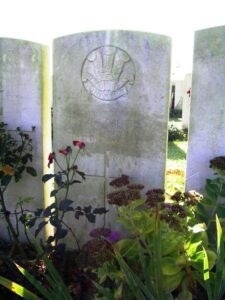
John Hubert Rogers, Shipwright 1st Class, 345535, Royal Navy. John was born on 4 July 1888, the son of John Thomas and Amy Letitia Rogers, of 28, Church Street, Pembroke Dock. He resided with his wife Lillian May Rogers (who later remarried, becoming Flowers), at 100, Jubilee Road, Southsea, Portsmouth prior to the war. John served aboard HMS Invincible, a battlecruiser, which was attached to 3rd Battlecruiser Squadron, serving as Flagship. John was killed when Invincible was blown up by a salvo of shells from the SMS Derfflinger during the Battle of Jutland, on 31 May 1916. He was 28 years old, and is commemorated on the Portsmouth Naval Memorial, Hampshire, on Panel 20. John is commemorated at St. John’s Church.
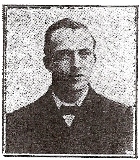
Ernest Dunbar Rollings, Lance Sergeant, 10969, Royal Army Pay Corps. Ernest was born at Pembroke Dock in 1876, the son of John and Jane Rollings. He lived with his wife Maude Rollings, at 47, Mantella Road, Tooting Common, London prior to the war. Ernest enlisted at Tooting into the army, joining the East Surrey Regiment with the service number GD/31496, before being posted to the Royal Army Pay Corps. Ernest died, aged 42, on 6 November 1918, and is buried at Brookwood Military Cemetery, Surrey, in Grave Ref. XIII. A. 7. Ernest is not commemorated at Pembroke Dock.
William Joseph Rosen, Staff Sergeant, 725042, Royal Field Artillery. William was born at Pembroke Dock, the son of Arthur and Edith Rosen. The family later resided at 15, Mansel Street, Briton Ferry. He had served throughout the war with C Battery, 266th Brigade, Royal Field Artillery, which was attached to the 53rd (Welsh) Division, and had seen action at Gallipoli, Egypt and in Palestine. William returned home at the end of the war, but died on 17 August 1919 of malaria. He was 31 years old, and is buried at Neath (Ynysymaerdy) Cemetery, in Grave Ref. A. 865. William is not commemorated at Pembroke Dock.
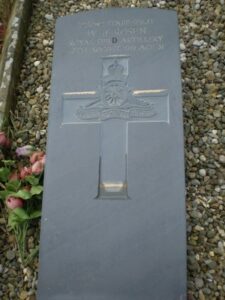
Walter Michael Joseph Roser, Engine Room Artificer 3rd Class, M/12906, Royal Navy. Walter was born on 1 January 1890, the son of Walter and Ellen Roser, of Forest Gate, London. He served with the Royal Navy prior to the war, and married Lilian Bermingham, of 14, Commercial Row, Pembroke Dock, whilst based at Pembroke Dock in 1915. Walter served aboard HM Submarine C34. Walter died when C34 was torpedoed and sunk by U-52 off the Shetland Isles on 21 July 1917. He was 27 years old, and is commemorated on the Chatham Naval Memorial, Kent, on Panel 23. Lilian never remarried, and died in 1970. Walter is not commemorated at Pembroke Dock.
Alfred Rossiter, 3rd Class Waiter, M/5412, Royal Navy. Alfred was born on 5 April 1890, the son of James and Esther Rossiter, of Pembroke Dock. He served in the Royal Navy, aboard HMS Indefatigable. Indefatigable was a battlecruiser, which was attached to the Grand Fleet, and was stationed at Rosyth. On 31 May 1916 the Grand Fleet sailed into the North Sea, and intercepted the German High Seas Fleet. Alfred was killed when Indefatigable was blown up by a direct hit in her magazines during the Battle of Jutland on 31 May 1916, and sank with the loss of her entire crew. He was 27 years old, and is commemorated on the Plymouth Naval Memorial, Devon, on Panel 17. Alfred is not commemorated at Pembroke Dock.
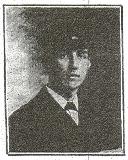
Robert Rossiter, Private, 23628, Welsh Regiment. Robert was the son of Warlow and Mary Rossiter, of Lower Law’s Street, Pembroke Dock, and the husband of Margaret Ellen Thomas (formerly Rossiter), of 15, Park Street, Maesteg, Bridgend, Glamorgan. He had originally enlisted into the Rhondda Battalion, Welsh Regiment, but was posted to the 15th Welsh, the Carmarthen Pals Battalion. The Battalion was attached to 114 Brigade, 38th (Welsh) Division, and moved to France in December 1915, being sent to the line at Fleurbaix. In June 1916 the Welsh marched to the Somme, and fought at Mametz Wood. After being decimated at Mametz, they moved to Ypres, where they took the line at Boesinghe. The Division fought during the opening assault of the Battle of Pilckem Ridge on 31 July 1917, and the 15th Welsh remained in the area to aid the 20th Division in their advance to Langemarck. Robert was killed here on 8 September 1917. He was 35 years old, and is commemorated on the Tyne Cot Memorial, Belgium. Robert is not commemorated at Pembroke Dock.
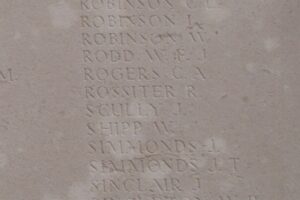
John Riley Salisbury, Private, 22716, Northumberland Fusiliers. John was the son of the Reverend John Thomas and Annie Salisbury, of Wesley Villa, Pembroke Dock. He served with the 12th Battalion, Northumberland Fusiliers, which was attached to 62 Brigade, 21st Division. The Division crossed to France between 2 and 13 September, 1915, and its first experience of battle was calamitous, being in France for only a few days, lengthy forced marches brought it into the reserve for the British assault at Loos, where it was sent into action on 26 September, and suffered over 3,800 casualties for very little gain. They moved to the Somme in 1916, and fought at the Battle of Albert, and it was here that John was killed, on 3 July 1916. He was 21 years old, and is commemorated on the Thiepval Memorial, France, on Pier and Face 10B, 11B and 12B. John is not commemorated at Pembroke Dock.
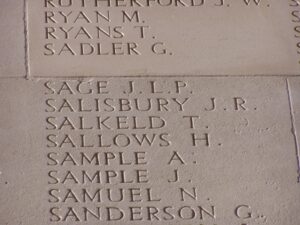
George James Rich Saunders, Captain, Leicestershire Regiment. George was the son of Dr. Edward Argent Saunders and Louisa Gertrude Saunders, of 1, Apley Terrace, Pembroke Dock. He had originally been commissioned into the South Lancashire Regiment, but had then been promoted Captain, and posted to the 7th Battalion, Leicestershire Regiment, which formed part of 110 Brigade, 21st Division. The Division crossed to France between 2 and 13 September, 1915, and its first experience of battle was calamitous, being in France for only a few days, lengthy forced marches brought it into the reserve for the British assault at Loos, where it was sent into action on 26 September, and suffered over 3,800 casualties for very little gain. They moved to the Somme in 1916, and fought at the Battle of Albert, then at the Battle of Bazentin, the Battle of Flers-Courcelette and the Battle of Morval. George was killed at Morval on 26 September 1916, aged 20. He has no known grave, and is commemorated on the Thiepval Memorial, France, on Pier and Face 7A and 7B. George is commemorated at St. John’s Church, where he also has a stained glass window dedicated to him.
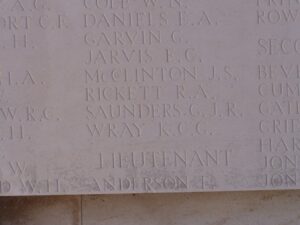
Frederick John Scurlock, Gunner, 112487, Royal Field Artillery. Frederick was the son of John Henry and Catherine Elizabeth Scurlock, of Pembroke Dock. He served with C Battery, 102nd Brigade, Royal Field Artillery, which was attached to 23rd Division. Between 21 and 26 August, 1915 the Division landed in Boulogne and proceeded to the Western Front, initially concentrating near Tilques. They saw their first major action at the Battle of Albert, where they captured Contalmaison, and then fought at the Battle of Bazentin, the Battle of Pozieres, the Battle of Flers-Courcelette, the Battle of Morval and the Battle of Le Transloy, where they captured Le Sars. In May 1917 they took part in the Battle of Messines, before moving further north to Ypres, and fighting at the Battle of the Menin Road, the Battle of Polygon Wood, the First Battle of Passchendaele and the Second Battle of Passchendaele. At the end of October 1917 the division moved by rail to Italy, concentrating between Mantua and Marcaria in November. On 4 December the Division took over a section of front line on the Montello, relieving the 70th Italian Division, and then fought at the Battle of Asiago and the Battle of Vittorio Veneto. Frederick was wounded here, and died of his wounds on 18 June 1918. He was 30 years old, and is buried at Dueville Communal Cemetery Extension, Italy, in Grave Ref. I. C. 1. Frederick is commemorated at St. John’s Church, and at St. Teilo’s.
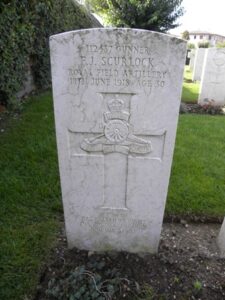
Albert Victor Searle, Shipwright 2nd Class, M/530, Royal Navy. Albert was born on 15 April 1893, the son of Frederick William and Mary, Ann Searle, of 39, Lewis Street, Pembroke Dock, and served aboard HMS Queen Mary, a modern battlecruiser, attached to the 1st Battlecruiser Squadron. During the Battle of Jutland, Queen Mary was inflicting heavy damage on two of the German battlecruisers, when she exploded after a shell hit her in the magazines. Albert was killed, along with most of Queen Mary’s crew of over 1,200 men, when she exploded and sank on 31 May 1916. Albert was 23 years old, and is commemorated on the Portsmouth Naval Memorial, Hampshire, on Panel 20. Albert is commemorated at St. John’s Church.
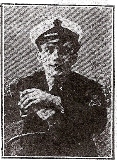
Alec Searle, Second Lieutenant, Royal Engineers. Alec was the son of Milton and Ann Searle, of 3, Hillsborough, Mannamead, Plymouth. He was an Associate Member of the Institute of Civil Engineers, and worked at Pembroke Dock for several years prior to the war, where he worked on the building of the new slipway at Pembroke Dockyard. Alec enlisted into the Royal Naval Division at the outbreak of war, and served at Gallipoli with the Royal Naval Division Engineers, where he was badly wounded. After recovering, he was commissioned into the Royal Engineers on 10 May 1916, and was posted to France with the 202nd Field Company, Royal Engineers. Alec was killed during the Battle of Arras on 16 April 1917. He was 26 years old, and is commemorated on the Arras Memorial, France. Alec is not commemorated at Pembroke Dock.
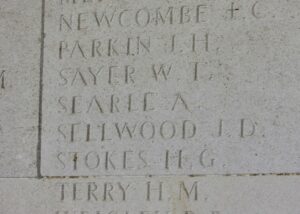
Garfield Stanley Sainsbury Silcox, Private, 425314, Canadian Infantry. Garfield was born at Saundersfoot on 8 November 1888, the son of James Henry and Sarah Jane Silcox. The family later lived at Pembroke Dock, before moving to Skeena, Park View, Swansea. Garfield emigrated to Canada, where he worked for the Grand Trunk Pacific Railway. He enlisted at Winnipeg on 1 September 1915 into the 45th Battalion, Canadian Infantry, and arrived in England on 25 March 1916. Garfield then landed in France on 25 May 1915, where he was posted to the 2nd Canadian Mounted Rifles, which was attached to the 8th Brigade, 3rd Canadian Division. Garfield joined his new unit in time to take part in the Battle of Mount Sorrel. The Canadians then moved to the Somme, and took part in the Battle of Flers-Courcelette, and the Battle of Thiepval during September 1916. On 1 October 1916 the Battle of Le Transloy was launched, and Garfield was killed here on 9 October 1916, aged 29. He is commemorated on the Vimy Memorial, France. Garfield is not commemorated locally.
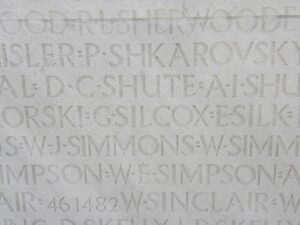
Alfred Ernest Simmonds, Petty Officer Stoker, 289127, Royal Navy. Alfred was born on 1 March 1875, the son of Daniel and Mary Simmonds, of Devonport. He was a long serving sailor, and resided with his wife Martha Simmonds) (nee Williams, later White), at Manchester House, Pembroke Ferry, Pembroke Dock. Alfred served aboard HMS Amphion, a scout cruiser, which had been built at Pembroke Dockyard. Alfred was killed when Amphion struck a mine and sank in the North Sea on 6 August 1914. He was 39 years old, and is commemorated on the Plymouth Naval Memorial, Devon, on Panel 3. Alfred is commemorated at Bethany Chapel, Pembroke Dock.
James William Simpson, Private, 13659, King’s Shropshire Light Infantry. James had been born at Pembroke Dock in 1892, the son of James and Minnie Simpson. The family later resided at 41, Rutland Street, Grange, Cardiff. James enlisted at Pembroke Dock into the 7th Battalion, King’s Shropshire Light Infantry, which was attached to 76 Brigade, 25th Division at Codford, Salisbury Plain. On 28 September 1915 the battalion landed at Boulogne, then moved to the 3rd Division. In 1916 the 7th KSLI fought at the Actions of the Bluff, and at the St Eloi Craters. They were then moved south to the Somme, where they were to take part in the great Battle of the Somme, and fought there at the Battle of Albert, and at the Battle of Bazentin, where they captured Longueval. They then took part in the Battle of Delville Wood, and the Battle of the Ancre, before settling into another bleak winter in France. In May, 1917 the Division were at Arras, and fought at the First Battle of the Scarpe, and it was here that James was killed, on 5 May 1917, aged 25. He is buried at Duisans British Cemetery, Etrun, France, in Grave Ref. IV. D. 24. James is not commemorated at Pembroke Dock.
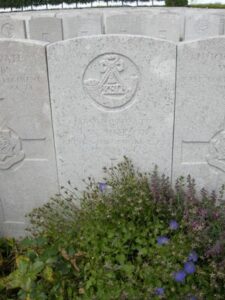
Edwin Skyrme, Shipwright, H.M. Dockyard, Portsmouth. Edwin was born on 25 November 1874, the son of Peter and Frances Skyrme, of Pembroke Dock, and the husband of Alice Skyrme, of 28, Widley Road, Twyford Avenue, Portsmouth. He worked as a Shipwright at Portsmouth, but was working aboard the American cutter USS Tampa, when she was sunk by a torpedo from the German submarine UB-91 in the Bristol Channel on 26 September 1918. Edwin was 44 years old, and is commemorated on the Portsmouth Naval Memorial, Hampshire, on Panel 31. Edwin is commemorated at St. John’s Church.
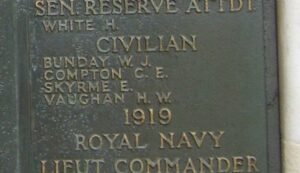
William Arthur Smedley, Gunner, 36252, Royal Garrison Artillery. William was the son of Alfred and Mary Ann Smedley, of 9, Park Street, Pembroke Dock. He enlisted at Pembroke Dock on 6 November 1911 into the Royal Garrison Artillery. William landed in France on 13 February 1915 attached to the 121st Heavy Battery, Royal Garrison Artillery, and served with it on the Western Front. William was killed on the opening day of Third Ypres on 31 July 1917. He was 21 years old, and is buried at Vlamertinghe New Military Cemetery, Belgium, in Grave Ref. VII. A. 15. His parents later retired to Chetputt Villas, Lemon Grove, Whitehill, Bordon, Hants. William is not commemorated at Pembroke Dock.
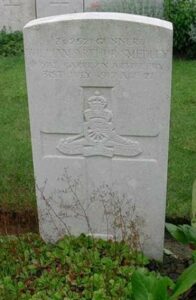
Alfred George Smith, Sapper, 490597, Canadian Railway Troops. Alfred was Born at Pembroke Dock on 20 May 1886, the son of Edward and Mary Smith. He emigrated to Canada prior to the war, and enlisted at Fernie, British Columbia on 10 May 1916, joining the 11th Battalion, Canadian Railway Troops. Alfred survived the war, but died of influenza while stationed at Kinmel Park on 2 February 1919. He was 29 years old, and is buried at Bodelwyddan (St. Margaret) Churchyard, in Grave Ref. 478. Alfred is not commemorated at Pembroke Dock.
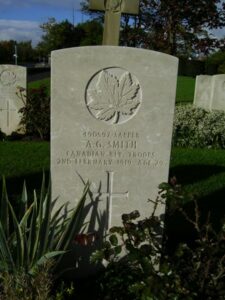
Arthur Eldred Smith, Gunner, 1257605, Canadian Garrison Artillery. Arthur was born at Pembroke Dock on 22 November 1896, the son of Henry Smith and Ellen Smith (nee Scone). The family later resided at Portsmouth before emigrating to Esquimalt, British Columbia. Arthur enlisted in Canada into the Canadian Garrison Artillery, and was posted to their 9th Siege Battery in France. Arthur was killed during the Battle of Arras on 13 May 1917. He was 20 years old, and is buried at Lievin Communal Cemetery Extension, France, in Grave Ref. IV. D. 16. Arthur is not commemorated at Pembroke Dock.
Ernest John Stewart, Private, 12207, Gloucestershire Regiment. Ernest was born at Pembroke Dock in 1890, the son of John and Mary Stewart. He enlisted at St. Pancras, London into the 8th Battalion, Gloucestershire Regiment. The battalion was attached to 57 Brigade, 19th (Western) Division, and crossed to France between 11 and 21 July 1915, moving to positions near Loos. The Division fought during the opening attack of the Battle of Loos, and then moved to the Somme, where they took part in the second wave of the attack on Ovillers-La Boiselle on 1 July, capturing the village at heavy cost, and fought through the Somme Battles of Pozières. It was here that Ernest was killed on 30 July 1916, aged 26. He has no known grave, and is commemorated on the Thiepval Memorial, France, on Pier and Face 5A/5B. Ernest is not commemorated at Pembroke Dock.
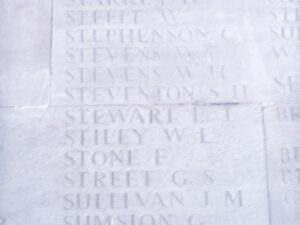
Arthur Evan Rideout Thomas, Corporal, 372, Australian Imperial Force. Arthur was born at Narberth, the son of Richard and Agnes Thomas. The family later resided at Pembroke Dock, and at Newport House, South Cliff Gardens, Tenby. Prior to the war, he had served for three years with the Artists Rifles, and had then emigrated to Australia. Arthur enlisted on the 22nd February, 1915 at Liverpool, NSW into the 18th Battalion, Australian Infantry, which were part of the 5th Brigade, 2nd Australian Division. The Battalion left Australia in May, 1915 bound for Egypt, and after several months spent training there landed on ANZAC Cove, Gallipoli on the 22nd August, 1915 to reinforce the badly depleted First Division who had been there since landing on the 25th April. Just days later, the Battalion took part in the Battle for Hill 60, where Arthur was wounded. He sadly Died of Wounds on 27 August 1915 aged 26. He was buried at sea, and so is remembered on the Lone Pine Memorial. Arthur is commemorated at St. John’s Church, and on a stained-glass window within the church.
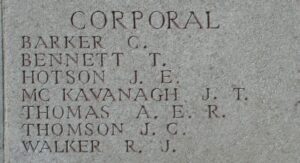
Benjamin Stewart Buckingham Thomas, MC, Lieutenant (Pilot), Royal Air Force. Benjamin was the son of Benjamin and Jessie Thomas, of 71, Gwyther Street, Pembroke Dock. He had originally served in France with the 9th Welsh, gaining the award of the Military Cross for gallantry on the Somme, before volunteering to serve with the Royal Flying Corps, where he trained as a Pilot. Benjamin was then posted to Number 11 Squadron, which flew the Bristol F2b. Benjamin was killed when his F2b, Serial D7978, with Lieutenant C. E. Spinks as Observer, was shot down over the Somme on 4 October 1918. He was 24 years old, and is buried at Grevillers British Cemetery, France, in Grave Ref. XVI. E. 14. Benjamin is commemorated at St. John’s Church.

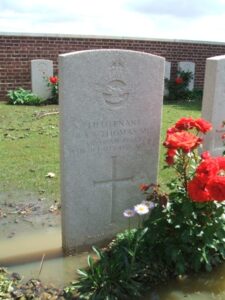
Frederick James Thomas, Private, G/40011, Middlesex Regiment. Frederick was the son of James and Annie Thomas, of 12, Grove Street, Pennar, Pembroke Dock. He enlisted at Highbeech, Essex into the Royal Fusiliers, but was later transferred into the 18th Battalion, Middlesex Regiment, which was attached to the 33rd Division, as Pioneers. The Division moved to France during November 1915, and saw its first major action during the Battles of the Somme, from July 1916 onwards. They then fought at the Battle of the Scarpe and at Bullecourt, before heading to Ypres, and fighting at the Menin Road and at Polygon Wood. They were still in Flanders when the German Spring Offensive hit, and fought at the Battle of Messines, and it was here that Frederick was killed on 13 April 1918. He was 25 years old, and is buried at Meteren Military Cemetery, France, in Grave Ref. II. C. 108. Frederick is not commemorated at Pembroke Dock.
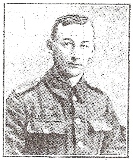
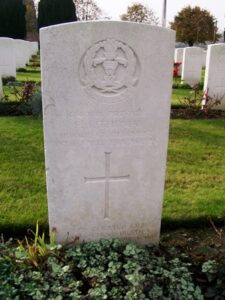
Frederick James Thomas, Second Lieutenant, West Yorkshire Regiment. Frederick was the son of Martha Jane Thomas, of 24, Commercial Row, Pembroke Dock. He was commissioned into the 3rd Battalion, West Yorkshire Regiment, and after training was posted to the 11th Battalion, which was in France attached to 69 Brigade, 23rd Division. Between 21 and 26 August, 1915 the Division landed in Boulogne and proceeded to the Western Front, initially concentrating near Tilques. They saw their first major action at the Battle of Albert, where they captured Contalmaison, and then fought at the Battle of Bazentin, the Battle of Pozieres, the Battle of Flers-Courcelette, the Battle of Morval and the Battle of Le Transloy, where they captured Le Sars. In May, 1917 they took part in the Battle of Messines, before moving further north to Ypres, and fighting at the Battle of the Menin Road, the Battle of Polygon Wood, the First Battle of Passchendaele and the Second Battle of Passchendaele. Frederick was killed at Passchendaele on 21 September 1917. He was 22 years old, and is commemorated on the Tyne Cot Memorial, Belgium, on Panel 42. Frederick is commemorated at St. John’s Church.
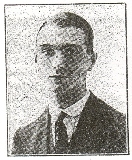
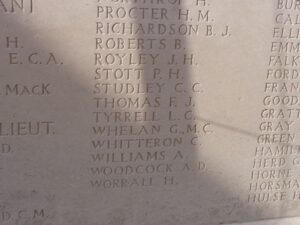
Lewis James Thomas, Private, 94123, Royal Welsh Fusiliers. Lewis was the son of James and Mary Thomas, and the brother of Elizabeth Ann Thomas, of 30, Milton Terrace, Pembroke Dock. He was a boiler maker at Pembroke Dockyard prior to enlisting on 7 December 1915 into the Monmouth Regiment. On 8 October 1918 Lewis embarked for France, and upon arrival was posted to the 17th Battalion, Royal Welsh Fusiliers, which was attached to 113 Brigade, 38th (Welsh) Division. The Division had been in France since December 1915, and had fought at Mametz Wood in 1916 and at Passchendaele in 1917. In 1918 it was moved to the Somme, from where it took part in the great offensive, which started on 23 August 1918. Lewis was killed when the Division was taking part in the Battle of the Selle on 21 October 1918. He was 22 years old, and is buried at Highland Cemetery, Le Cateau, France. Lewis is commemorated at St. John’s Church.
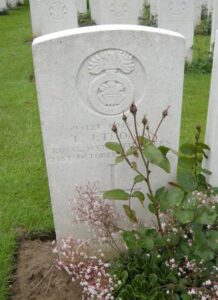
Reginald George Thomas, Shipwright 1st Class, 344454, Royal Navy. Reginald was born on 12 August 1886, the son of John and Jane Thomas, of Pembroke Dock. He served with the Royal Navy prior to the war, and resided with his wife Eva Thomas (nee Webb), at 158, Balmoral Road, Gillingham, Kent. Reginald served aboard HMS Vanguard, which was a St. Vincent Class Battleship, which was attached to the First Battle Squadron, and took part in the Battle of Jutland. On 9 July 1917 Vanguard was at anchor at Scapa Flow, when a fire exploded part of the vast store of cordite aboard her, sinking the mighty ship in seconds, with the loss of all but two of her crew. Reginald was among the dead. He was 31 years old, and is commemorated on Panel 24 of the Chatham Naval Memorial, Kent. Reginald is commemorated at St. John’s Church.
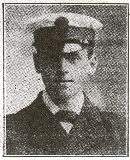
John Thompson, Private, 13415, Gloucestershire Regiment. John was born at Pembroke Dock in 1877. He worked at Birmingham prior to the war, and resided with his wife Mary and their children at No 1, 17 Court, Camden Street, Birmingham. John enlisted at Birmingham into the Gloucestershire Regiment. He joined the newly formed 10th Battalion, but sadly died while the battalion was training in Wiltshire on 9 December 1914. John is buried at Mere Cemetery, Wiltshire, in Grave Ref. 637. John is not commemorated at Pembroke Dock.
Alfred Torrington, Stoker 1st Class, K/10324, Royal Navy. Alfred was born at Pembroke Dock on 20 April 1892, the son of Robert and Florence Torrington. He served in the Royal Navy aboard HMS Monmouth, an Armoured Cruiser, attached to the 4th Cruiser Squadron, based in the West Indies. She participated in the Battle of Coronel, off the coast of Chile on 1 November 1914, but, due to her age, and inexperienced crew, was quickly outclassed and sank after receiving direct hits from SMS Gneisenau. Alfred was 22 years old when he was killed along with all of his fellow crew-members during the sinking, and is commemorated on the Plymouth Naval Memorial, Devon, on Panel 3. Alfred is not commemorated at Pembroke Dock.
Bertram Treharne, Leading Seaman, Z/744, Royal Navy. Bertram was born at Tumble on 26 March 1893, the son of William and Elizabeth Treharne. William then took up ownership of the Prince Albert Vaults at Pembroke Dock, and moved his family there to live. Bertram enlisted on 18 April 1915 into the Royal Navy, and on 16 August 1915 was posted for duty with the Grand Fleet. Bertram was posted aboard the battlecruiser HMS Indefatigable, which served in the 1st Battlecruiser Squadron of the Grand Fleet. She sadly became the first casualty of the Battle of Jutland on 31 May 1916. Indefatigable was struck by a salvo of shells from the German battlecruiser SMS Von der Tann, which exploded her magazines, sending her to the bottom in minutes, with the loss of all bar three of her crew of 1,017. Bertram was one of the dead, and is commemorated on panel 19 of the Plymouth Naval Memorial, Devon. Bertram is not commemorated at Pembroke Dock.
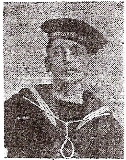
Frederick George Truscott, Private, 25713, Lancashire Fusiliers. Frederick was the son of Horatio George and Anne Prosser Truscott, of 70, Gwyther Street, Pembroke Dock. Frederick enlisted at Pembroke into the Royal Field Artillery, and was given the service number 137692. He was later transferred, probably due to earlier wounding or sickness, to the 12th Battalion, Lancashire Fusiliers, his number changing to 25713. The Battalion formed part of 65 Brigade, 22nd Division. The Division crossed to France in early September 1915, with all units being concentrated near Flesselles by 9 September. However, it’s stay in France was to be very short, as on 27 October 1915 the Division, having been moved by train to Marseilles, began to embark for Salonika. It completed concentration there in November, although the final artillery units were still coming in as late as 13 December 1915. It remained in the theatre for the rest of the war, taking part in the Retreat from Serbia during December, 1915. From 10-18 August 1916 the Division fought at the battle of Horseshoe Hill, then from 13-14 September 1916 at the battle of Machukovo. From 24 to 25 April and 8 and 9 May 1917 the Division fought at the battle of Doiran. Frederick was killed in action near Doiran on 22 April 1918. He was 23 years old, and is commemorated on the Doiran Memorial, Salonika. Frederick is commemorated at St. John’s Church, and also has a stained-glass window dedicated to him.
Samuel George Turner, Bombardier, 31927, Royal Garrison Artillery. Samuel was born at Pembroke Dock on 16 November 1894, the son of James and Phoebe Turner. He enlisted there into the Royal Garrison Artillery. After training, he was posted to France with 242nd Siege Battery, RGA, and was killed at Ypres during the build up to the Battle of Passchendaele on 16 July 1917, aged 22. Samuel was buried at Bus House Cemetery, Belgium, in Grave Ref. E. 3. Samuel is commemorated at St. John’s Church.
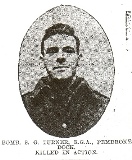
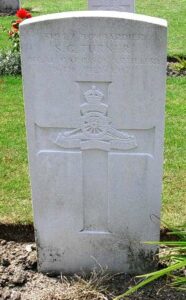
Ernest John Vaughan, Shipwright 2nd Class, 176015, Royal Navy. Ernest was born at Pembroke Dock on 29 December 1873, the son of Michael and Catherine Vaughan. He served at HMS Pembroke, the Royal Naval Base at Chatham. He died on 25 April 1916, aged 42, and is buried at Gillingham (Woodlands) Cemetery, Kent, in Grave Ref. Naval. 21. 1084. His brother Arthur Vaughan, of 121, Trealaw Road, Trealaw, Glamorgan was named as his next of kin. Ernest is not commemorated at Pembroke Dock.
Frederick Norton Warlow, Private, 442234, Canadian Infantry. Fred was born on 20 August 1884, the son of William and Elizabeth Warlow, of 36, Queen Street, Pembroke Dock. He had served for several years with the Pembroke Imperial Yeomanry before deciding to emigrate to Canada prior to the war. He enlisted at Vernon, British Columbia into the 7th Battalion, Canadian Infantry on 29 May 1915, and embarked for Britain, before moving to France, where the Battalion was attached to the 2nd Canadian Brigade, 1st Canadian Division. Fred fought on the Somme in 1916, and was wounded at Courcelette during the Battle of Thiepval Ridge. He was evacuated to the Base Hospital at Le Havre for treatment, but died there of his wounds on 1 October 1916. Fred was 31 years old, and is buried at Ste. Marie Cemetery, Le Havre, France, in Grave Ref. Div. 3. I. 3. Frederick is commemorated at St. Andrew’s Church.
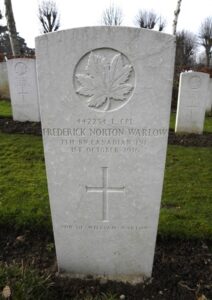
Joseph George Watson, Sergeant, 10073, Royal Welsh Fusiliers. Joseph was born at Lewisham in 1891, the son of Joseph George Watson and Elizabeth Anne Watson. The family lived at 102, Laws Street, Pembroke Dock before the war. Joseph enlisted at Pembroke at the outbreak of war into the 1st Battalion, Royal Welsh Fusiliers, which moved to France in October 1914 attached to 22 Brigade, 7th Division. The Division moved to Ypres, where they became the first British Division to hold the city, fighting through the First Battle of Ypres. In March 1915, the Division fought at the Battle of Neuve Chapelle, then in May 1915 at the Battle of Aubers Ridge, and at Festubert, before taking part in the Battle of Loos in September. The Division remained in the Loos Sector over the winter of 1915/16, and it was there that Joseph was killed, on 11 November 1915, aged 24. He has no known grave, and is commemorated on Panel 50 of the Loos Memorial, France. Joseph is commemorated at St. John’s Church.
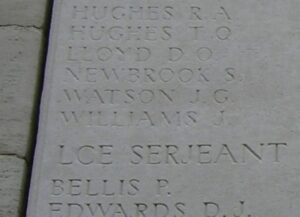
Albert Henry Wilde, Lance Corporal, 16331, Royal Engineers. Albert was born at Pembroke Dock, the youngest son of Master Gunner Joseph Wilde and Elizabeth Wilde. He resided at Ilford, Essex at the outbreak of war, and enlisted there on 4 October 1906 as a boy soldier into the Royal Engineers. On 26 October 1915 Albert was posted to France, before joining the 53rd Base Park Company, in Salonika. Albert became ill and died in Salonika of pneumonia and influenza on 23 October 1918, aged 27. He is buried at Kirechkoi-Hortakoi Military Cemetery, Salonika, in Grave Ref. 381. Albert is not commemorated at Pembroke Dock.
George Wildig, DCM, Lieutenant, Kings Shropshire Light Infantry. George was born at Cork, Ireland, the son of Major George Wildig, of the KSLI. He came to Pembroke Dock with his father in 1904, and was educated at the County School. After leaving school, George followed in his father’s footsteps, and enlisted into the 1st Battalion, King’s Shropshire Light Infantry, which was attached to 16 Brigade, 6th Division. On 10 September 1914 the Division landed at St Nazaire and proceeded to the Western Front, and arrived in time to reinforce the hard-pressed BEF on the Aisne, before the whole army was moved north into Flanders. Here they took part in the Action of Hooge during June, 1915, and in 1916 moved to the Somme, where the Division fought at the Battle of Flers-Courcelette, the Battle of Morval and the Battle of Le Transloy. George was awarded the Distinguished Conduct Medal while serving with them in France, his award being listed in the London Gazette of 11 January 1916. He was then commissioned, and married Elsie Mary Vaughan whilst on leave in the summer of 1916. George served for the rest of the war as a Lieutenant with the 161st Training Battalion. He died in hospital at Birmingham on 6 November 1918, aged 26. George was buried at Pembroke Dock (Llanion) Cemetery on Armistice Day, in Grave Ref. V. 2. George is commemorated at Pembroke County School.
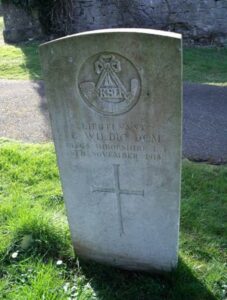
Albert Edwin Williams, Driver, 814, Royal Field Artillery. Albert was the son of George and Alice Williams, of Albion Square, Pembroke Dock. He enlisted at Glasgow into the Royal Field Artillery, and was posted to their Lowland Brigade. The Brigade moved to the Mediterranean, and landed on Gallipoli on 6 June 1915. Albert took ill while at Gallipoli, and was evacuated to Egypt for treatment, but died there on 13 October 1915. He was 19 years old, and is buried at Alexandria (Chatby) Military and War Memorial Cemetery, Egypt, in Grave Ref. D. 48. Albert is commemorated at St. John’s Church.
David Aubrey Williams, Second Lieutenant, South Wales Borderers. David was the son of William and Mary Williams, of 95, Laws Street, Pembroke Dock. He was a schoolmaster at Cardiff prior to the war. David was commissioned from the Royal Engineers into the 1st Battalion, South Wales Borderers, and landed in France on 5 January 1916. The 1st SWB was attached to 3 Brigade, 1st Division, and had been in France since the outbreak of war. In 1916 the Division moved to the Somme, where it took part in the Battle of Albert during the opening of the Somme Offensive. David was killed three weeks into the battle, on 25 July 1916, aged 29. He is commemorated on the Thiepval Memorial, France, on Pier and Face 4A. His brother Thomas Howard Williams also fell. David is commemorated at St. John’s Church and at St Andrew’s Church.
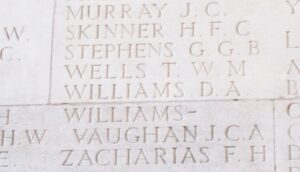
Ernest Evan Williams, Private, 372305, Royal Army Medical Corps. Ernest was the son of Evan and Mary Ann Williams, of 49, South Park Street, Pembroke Dock. He worked as a Schoolmaster at Pembroke Dock prior to the war. Ernest enlisted at Cardiff on 25 October 1915 into the Royal Army Medical Corps, and was attached to the 3rd Western General Hospital at Cardiff. By 21 May 1917 Ernest had become too ill to work, and was struck off the strength of the RAMC, his papers showing that he had caught an infection during his service. Ernest was treated in a Sanatorium for the next year, sadly dying of pulmonary tuberculosis on 23 June 1918, aged 26, at Newport Hospital, Gwent. Ernest was 26 years old, and is buried at Pembroke Dock (Llanion) Cemetery. Ernest was accepted for commemoration by the CWGC on Saturday 26 April 2014 as a result of my research.
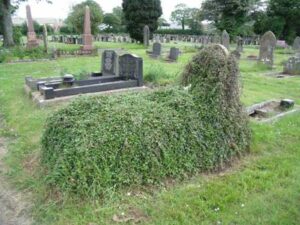
John A. Williams, Private, 39026, Cheshire Regiment. John was the son of Mrs. K. Martin, of 13, Military Road, Pennar, Pembroke Dock. He originally enlisted into the 19th Battalion, Cheshire Regiment, before being medically downgraded, most probably as a result of being wounded, and was posted to the 59th Labour Company, Labour Corps. John was killed at Ypres on 17 June 1917, aged 26, and is buried at Mendinghem Military Cemetery, Belgium, in Grave Ref. II. E. 23. John is not commemorated at Pembroke Dock.
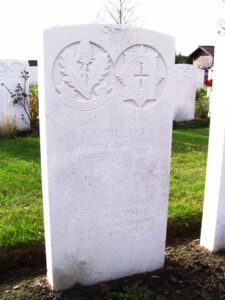
Ronald Charles Williams, Private, 418947, Canadian Infantry. Ronald was born at Pembroke Dock on 23 December 1886, the son of William and Fanny Williams. He emigrated to Canada in the years before the war, and lived with his wife Fanny Williams, at 65, Aird Avenue, Maissoneuve, Canada. Ronald enlisted at Montreal on 21 May 1915 into the 42nd Battalion (Royal Highlanders of Canada), Canadian Expeditionary Force. The Battalion was in France by the end of the year, attached to the 7th Canadian Brigade, 3rd Canadian Division, and moved to positions at Ypres. On 2 June 1916 the battalion was to see its first major action, when the Germans attacked the Canadian positions from Hooge to Sanctuary Wood, and the 42nd Battalion was sent to the front to support the embattled troops there. Ronald was killed here during the fighting of 2 June 1916. He was 29 years old, and is commemorated on Panels 24-30 of the Ypres (Menin Gate) Memorial, Belgium. Ronald is not commemorated at Pembroke Dock.
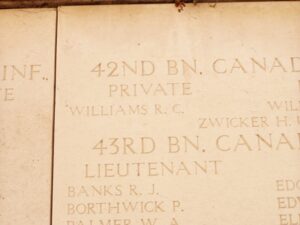
Samuel Mervyn Williams, Second Lieutenant, Notts & Derby Sherwood Foresters. Samuel was the son of the late Dr. Richard H. Williams and of Mrs. Edith Silcott (formerly Williams), of Penfro, St. Bride’s Hill, Saundersfoot. Samuel was born in Pembroke Dock, and was educated at Llandovery, Plymouth and St. George’s College, Kingsway. He passed into Sandhurst on 18 January, 1915 and was commissioned into the Sherwood Foresters on 15 August. Samuel was then posted to their 2nd Battalion, which was attached to 71 Brigade, 6th Division, arriving on the Western Front on 4 October 1916. The Battalion had been in France since landing at St. Nazaire on 11 September, 1914. They had rushed to reinforce the BEF on the Aisne, and had then been transferred to Hooge. In 1916 the Division moved south, to take part in the Somme Offensive, and fought at Flers-Courcelette, Morval and Le Transloy. Samuel had only gone into action for the first time on 13 October, but was killed in Action just three days later, on 16 October 1916 during the Battle of Le Transloy. He was aged just 19, and is remembered on the Thiepval Memorial, France. Samuel is commemorated at St. John’s Church.
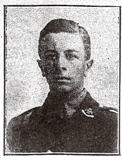
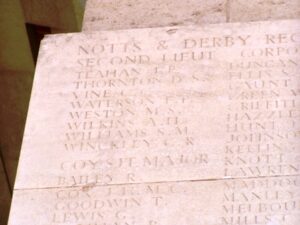
Thomas Howard Williams, Private, 765298, London Regiment. Thomas was the son of William and Mary Williams, of 95, Laws Street, Pembroke Dock. Prior to the war he had worked for 19 years in the service of the London and Provincial Bank at Cardiff, where he resided with his wife, Nancy Williams, at Ship House, The Leys, St. Athans. Thomas had enlisted at Cardiff on 1 December 1915 into the 1/28th Battalion, London Regiment (Artists Rifles). The battalion was an officer training battalion for most of the war, and on 28 June 1917 joined 190 Brigade, 63rd (Royal Naval) Division. The RND was at Arras by then, before moving to positions at Ypres, where they took part in the Battle of Passchendaele. Thomas joined the battalion in France on 13 September 1917, at the height of the Passchendaele offensive. He was killed at Passchendaele on 30 October 1917, aged 34, and is commemorated on the Tyne Cot Memorial, Belgium, on Panel 153. Nancy returned to Pembroke Dock to live, but in 1922 married John Gibbs, and moved back to Cardiff. Thomas’s brother David Aubrey Williams also fell. Thomas is commemorated at St. John’s Church and at St. Andrew’s Church.
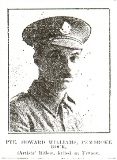
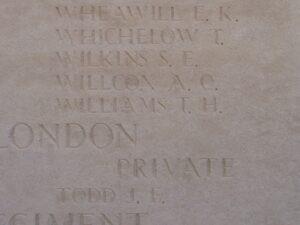
Thomas William Williams, Private, 57188, Royal Fusiliers. Thomas was born at Haverfordwest, the son of Martha S. Griffiths. The family later resided at 1, Commercial Row, Pembroke Dock. He served with the 11th Battalion, Royal Fusiliers, which was attached to 54 Brigade, 18th (Eastern) Division. On 25 May 1915 the Division landed in Boulogne, and saw its first major action the Battle of Albert. They fought throughout the Somme offensive, before spending the winter on the Somme. In March, 1917 they followed the German Retreat to the Hindenburg Line, and in May took part in the Third Battle of the Scarpe, which was part of the Arras Offensive. July, 1917 saw the Division at Ypres, where they took part in the Battle of Pilckem, where they helped capture Westhoek, and then they fought at the Battle of Langemarck. Thomas was killed at Langemarck on 10 August 1917. He was 21 years old, and is buried at New Irish Farm Cemetery, Belgium, in Grave Ref. XXXI. E. 10. Thomas is not commemorated at Pembroke Dock.
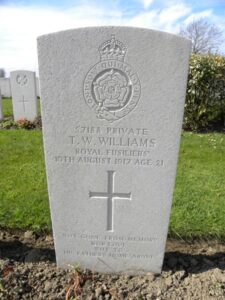
William Arthur Williams, Armament Staff Sergeant, 392, Royal Army Ordnance Corps. William was the son of William and Esther Williams, of Pembroke Dock, and the husband of Leah Annie Williams, of 35, Meyrick Street, Pembroke Dock. He was a regular soldier, and served with the 11th Heavy Artillery H.Q., Royal Army Ordnance Corps on the Western Front. William was mortally wounded at Ypres, and died of his wounds on 29 December 1915. He was 35 years old, and is buried at Lijssenthoek Military Cemetery, Belgium, in Grave Ref. IV. C. 33. William is commemorated at St. Andrew’s Church.
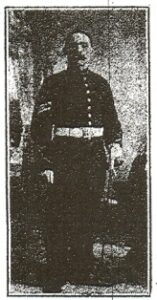
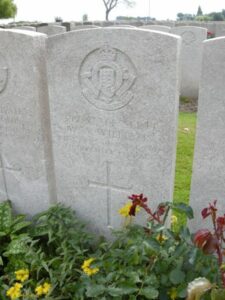
James Dominique Wood, DCM, Second Lieutenant, Wiltshire Regiment. James was born at Trowbridge, Wiltshire in 1885, the son of Jackson and Lucie Wood. James was a long serving soldier, and was stationed at Pembroke Dock with the Wiltshire Regiment prior to the war, marrying Mary Anne Phillips prior to 1907. The couple resided at 13, Lewis Street, Pembroke Dock with their three young children. James landed in France on 7 October 1914 with the 2nd Battalion, Wiltshire Regiment, and took part in the First Battle of Ypres. He was awarded the Distinguished Conduct Medal for gallantry at Hooge on 2 September 1915, before gaining a commission into the 1st Battalion, Wiltshire Regiment, which was attached to 7 Brigade, 25th Division. The Division moved to the Somme in the summer of 1916, and attacked on 3 July near Thiepval. They fought throughout the Battle of the Somme, and then moved to Ploegsteert, where they held the line for the months leading up the Battle of Messines in June 1917. After fighting at Messines, the Division moved north, and fought at Pilckem Ridge. James was killed at Langemarck on 5 August 1917. He has no known grave, and is commemorated on Panel 53 of the Ypres (Menin Gate) Memorial, Belgium. Mary remarried in 1922, and lived at 32, Highgrove Street, Reading, passing away in 1949. James is commemorated at St. John’s Church.
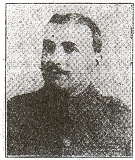
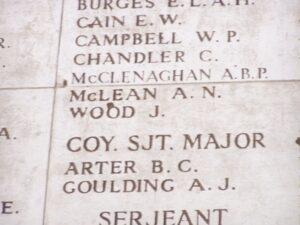
Harry George Robert Wyatt, Sergeant, 8044, Duke of Edinburghs Wiltshire Regiment. Harry was the son of Frank and Sarah Ann Wyatt, of Great Western Hotel, Devizes. He resided at Pembroke Dock for some time prior to the war. Harry embarked for France on 1 April 1915, joining the 2nd Battalion, Wiltshire Regiment, which was attached to 21 Brigade, 7th Division. He was killed in action just two months later, on 15 June 1915, aged 26. Harry is commemorated on the Le Touret Memorial, Richebourg L’Avoue, France. Harry is not commemorated locally.
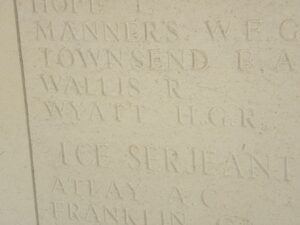
Herman Lile Young, Steward, 484890, Mercantile Marine Reserve. Herman was the son of William and Bessie Young, of Pembroke Dock. William was a Lighthouse Keeper at North Stack, Anglesey by 1901, and Herman married Anne Jones at Liverpool on 22 April 1913, setting up the family home at 36, Thomas Street, Holyhead. During the Great War Herman served aboard the Armed Merchant Cruiser HMS Laurentic, which had been requisitioned by the Admiralty from the White Star Line at the outbreak of war. She sunk after striking two mines off Lough Swilly, off the Irish coast on 25 January 1917. Only 121 of the 475 aboard survived, Herman being among the dead. He was 28 years old, and is commemorated on Panel 26 of the Plymouth Naval Memorial, Devon. Herman is not commemorated at Pembroke Dock.
